Sri Lanka's best national parks for seeing elephants, leopards and birdlife
Feb 15, 2022 • 10 min read
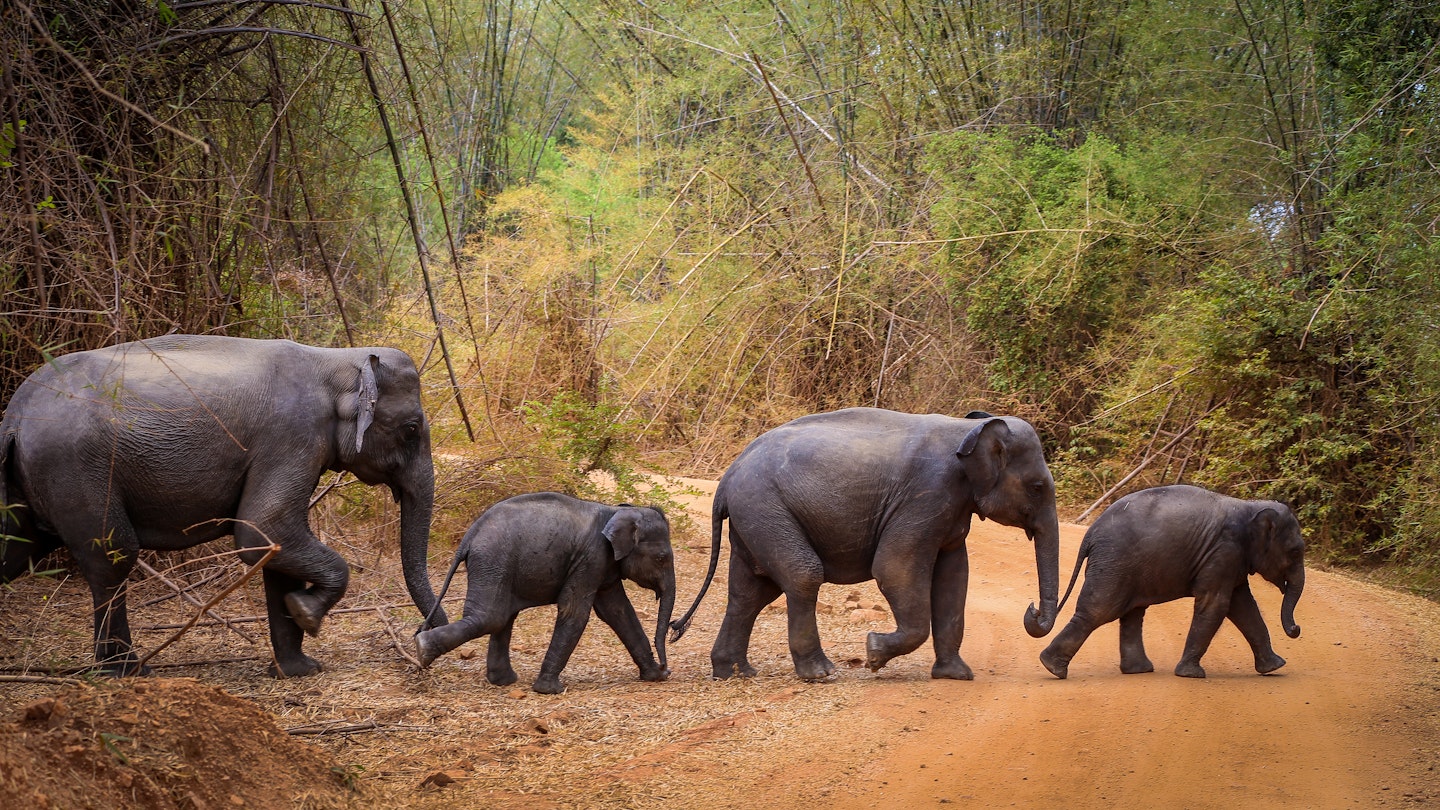
Elephant encounters are one of the top experiences drawing visitors to Sri Lanka's national parks © Olivier Schram / Getty Images
A leopard basking in the fork of a tree. A family of elephants lumbering out of the tropical undergrowth. A solitary jackal gazing across an open plain in the early morning sun. These are just some of the sights awaiting in Sri Lanka 's national parks – some of the wildest, most beautiful places on earth.
Some Sri Lankan parks are busy and crowded – most notably Yala, Minneriya , and Kaudulla – while others see just a slow trickle of visitors, but all hold secrets. In most, you can combine wildlife safaris with trips to sacred caves, forgotten stupas, and unexcavated fragments of ancient civilizations. But the top experience for visitors is coming face-to-face with one of Sri Lanka’s emblematic elephants. Some 7500 of them are spread across the country’s 22 national parks.
Visiting all of Sri Lanka’s national parks on a single trip is the preserve of career naturalists, so we’ve whittled down the list to a few favorites for nature-loving travelers with a tight schedule. Here's our pick of Sri Lanka’s best national parks.

Uda Walawe National Park, Sabaragamuwa and Uva Provinces
Best for spotting elephants.
This vast and popular park on the southern fringes of Sri Lanka’s Hill Country is mostly covered with low-lying scrub, so seeing Sri Lanka’s majestic elephants is very close to a dead cert.
Around 700 elephants roam across the park, and they congregate in herds of up to 50 individuals. The best time to see them is on a jeep safari at sunrise or sunset – opt for the former and you’ll finish the safari decidedly less sweaty, while still making it back in time for breakfast.
While Sri Lanka's elephant orphanages have a mixed reputation, there are a few ethical operators close to Uda Walawe, in case you haven’t quite had your fill of cute jumbo toddlers. Start with the Elephant Transit Home , supported by the Born Free Foundation .
Seeing a leopard, while not impossible, is far less likely. There’s a relatively healthy population of these big cats at Uda Walawe, but they have plenty of places to hide and tend to keep a low profile. Crocodiles, on the other hand, are abundant and a host of beautiful bird species can be spotted on every safari.
Kumana National Park, Eastern Province
Best alternative to the crowded parks.
A great alternative to crowded Yala and Minneriya, and easily reached from the east coast, Kumana National Park offers swampy grasslands and large, salty villus (natural lakes) where elephants wade and storks and ibis gather. On the edge of this watery landscape, the forest harbors spectacular hornbills, colorful minivets, and characterful langurs and macaques.
Elsewhere in the park, rocky outcrops conceal meditation caves and crumbling stupas, some with ancient inscriptions and statues. At Bambaragasthalawa, a towering boulder shades a time-worn statue of a reclining Buddha from the 9th century. You can reach it on foot from the park entrance with a local guide.
While elephants are the main attraction, Kumana is also a bird lover's paradise; keen birders might spot 100 species in one day. And, with an estimated 40 leopards roaming around, this park offers a very real chance of spotting Sri Lanka's most famous predator without being surrounded by other jeeps.
Do you need a visa to go to Sri Lanka?

Wasgamuwa National Park, Central and North Central Provinces
Best for the sheer variety of wildlife.
Just south of Polonnaruwa , bordered by forested mountains and the Mahaweli River, Wasgamuwa National Park is a majestic park. Three-quarters of the park remains unexplored, and most of Sri Lanka's land mammals reside here. Elephants, leopards, bears, and wild boar dwell in its forests, and herds of buffalo, sambar, and spotted deer gambol across its plains.
Most visitors are drawn to Wasgamuwa by the park’s 150 or so elephants. Large herds are often seen, rivaling sightings in Minneriya and Kaudulla national parks, yet Wasgamuwa is usually ignored by tourists and can be extremely quiet, especially during the week.
It also offers something other parks don't – a volunteer program run by the Sri Lanka Wildlife Conservation Society, where you can observe the elephants in the wild and help with their conservation.
Bundala National Park
Best for seeing turtles, crocodiles, and flamingos.
A watery wonderland of coastal lagoons and bird-thronged wetlands, Bundala National Park speaks to lovers of all things aquatic. Flamingos (who number in the thousands) and crocodiles are the stars of the show, though vividly colorful bee-eaters and openbill storks will titillate the more discerning twitcher. Elephants are another draw – the high season around December is the best time to see the park's jumbos.
Bundala National Park claims nearly 20km of the southern littoral zone between Kirinda and Hambantota, including a long sweep of beaches. From October to January, all five of Sri Lanka’s marine turtle species (olive ridley, green, leatherback, hawksbill, and loggerhead) come ashore to lay their eggs on the coastal sands. Visitors can watch the hatchlings struggling back to sea as part of a night safari from April to June.
12 places that should feature on every Sri Lanka itinerary
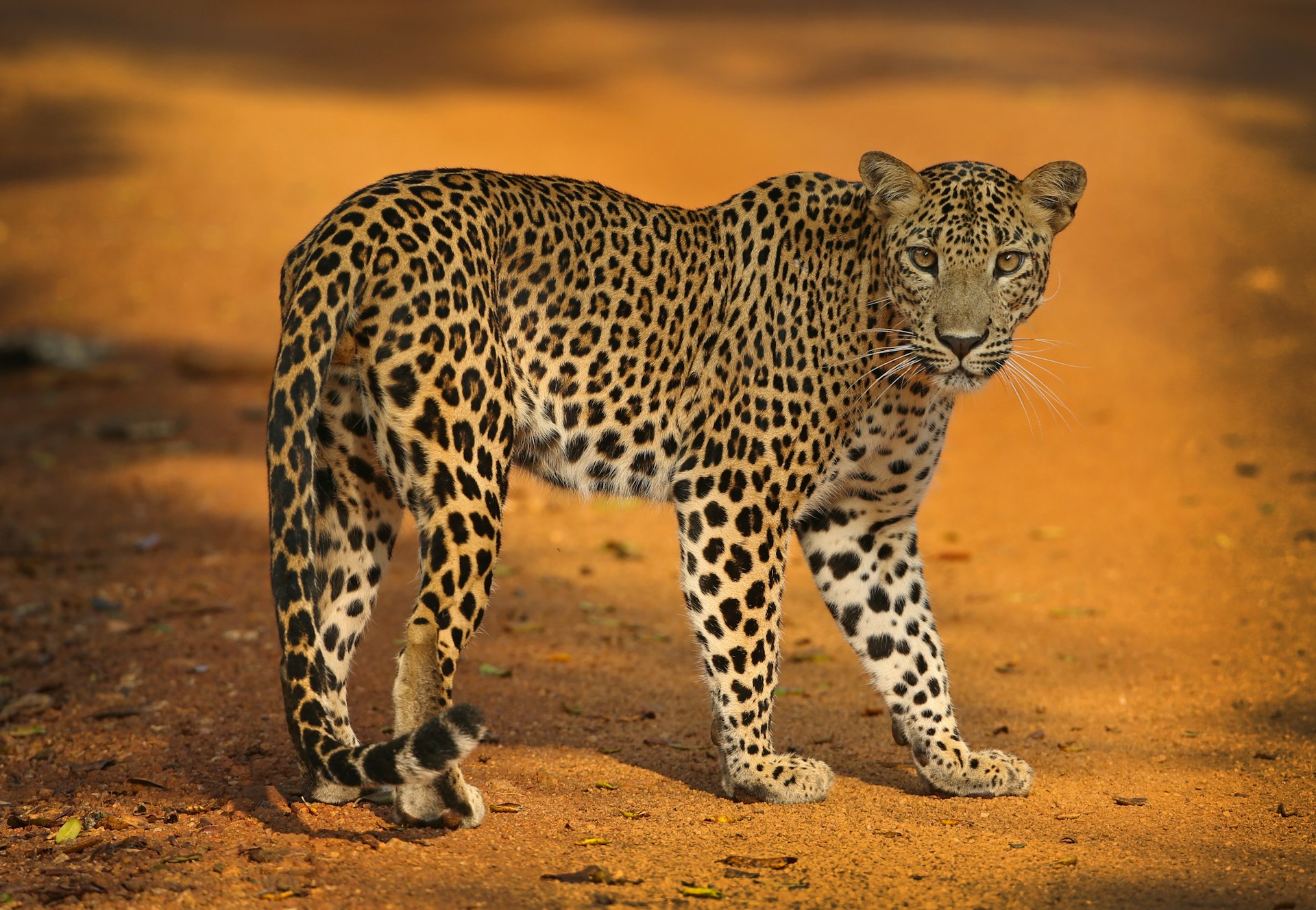
Yala National Park, Southern and Uva Provinces
Best for leopard sightings.
Without a doubt, the most popular national park in Sri Lanka – and arguably one of the best places for big mammal sightings in the whole of Asia – Yala National Park pulls in huge crowds during the tourist season.
Visitors flock here for one reason in particular – the chance of a close encounter with one of Sri Lanka’s elusive leopards. While they’re not easy to spot, the chance of seeing one of these elusive beauties is reasonably good, particularly if you take a safari with a reputable and experienced park operator.
Most tourists only visit Block 1 of Yala, in the south, which makes up around a sixth of the whole park. Blocks 2, 3, 4, and 5 can also be explored with varying degrees of difficulty, taking you away from the day-tripping crowds.
On the western side of the park, Block 5 merges into neighboring Lunugamvehera National Park. It's a beautiful corner of Yala, containing a reservoir full of ghostly, flooded trees. Leopards and sloth bears roam here, and elephants can be spotted further south in Lunugamwehera. The northern sections of Yala (Blocks 2, 3, and 4) are also remote and overlooked by the crowds.
Trips to any part of Yala beyond Block 1 require some planning. Tracks are rough and overgrown, making any visit something of an expedition. Several tour companies (including Kulu Safaris ) specialize in taking guests into these areas and there's accommodation in forest camps such as Tree Tops Jungle Lodge .
The best ways to get around in Sri Lanka at any time of year
Lahugala Kitulana National Park, Eastern Province
Best for combining history with birdwatching.
While Sinharaja Forest Reserve is Sri Lanka's top destination for birders, small Lahugala National Park is well worth visiting for avian encounters. Come in the late afternoon, when you can also watch elephants and buffalo grazing peacefully in the water-logged beru grass. The park's forests of tall satinwood, rosewood, and palu trees are home to dozens of species of forest birds, including the rare red-faced malkoha.
On the outskirts of the park is the enormous, dilapidated Neelagiri Stupa, which is said to date from the 2nd century BC and has never been properly excavated. Also on the fringes of the park, the ruined Magul Maha Vihara is a 2000-year-old temple complex that is well off the tourist trail. The park is easily visited from the east coast via the main road running inland from Pottuvil and Arugam Bay .
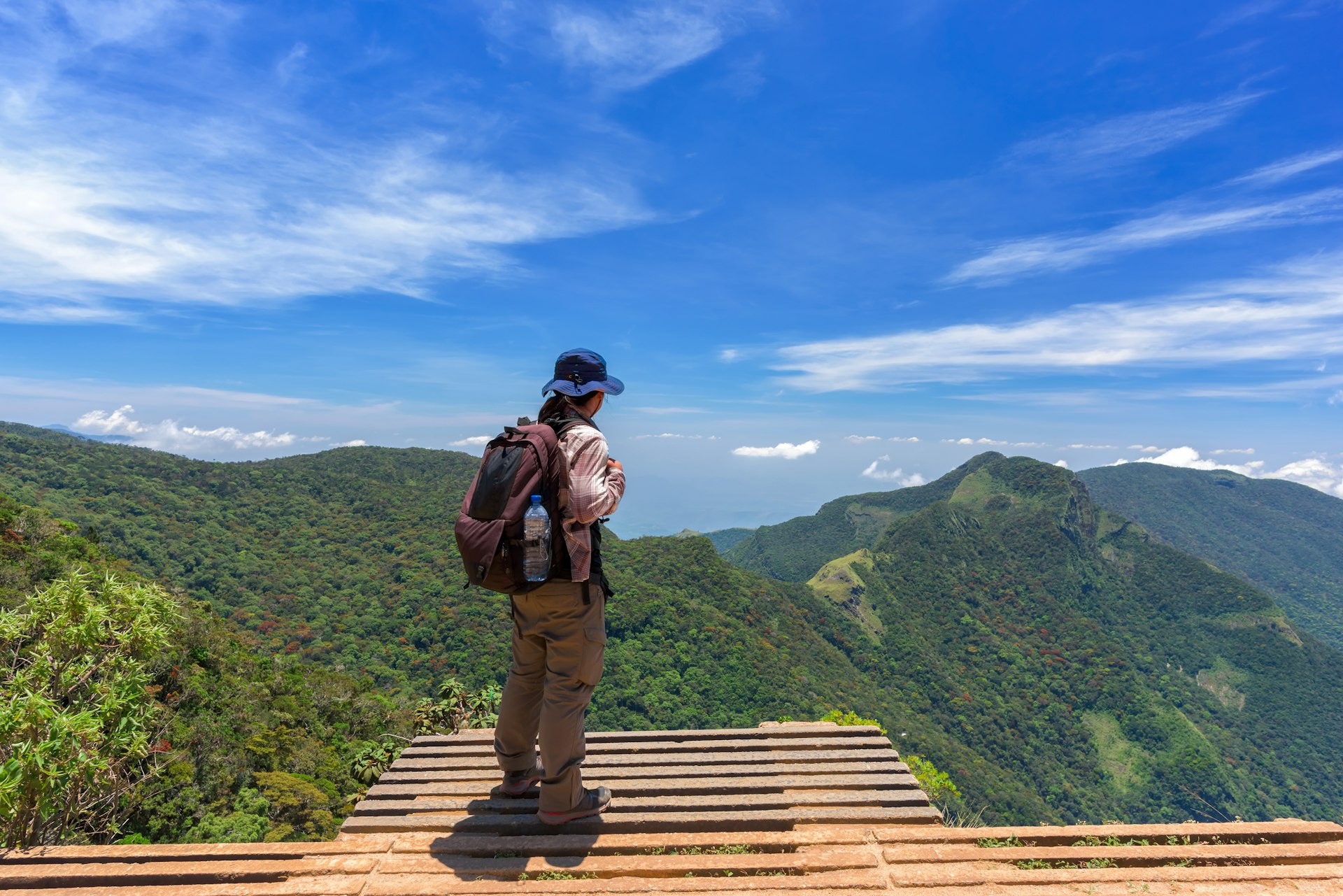
Horton Plains National Park, Central Province
Best for trekking and hiking.
Covering the highest plateau in Sri Lanka, at an elevation of around 2000m (6562ft) above sea level, Horton Plains National Park is a magnificent magnet for birdwatchers and hikers. Whichever camp you fall into, it's worth following the trail from the park’s entrance to World’s End, a blow-you-away lookout with ethereal views, perched on the edge of an 880m (2625ft) drop.
The hike will take you over rivers, past waterfalls, and through lush cloud forests before you arrive at a vantage point that is famed for sightings of whistling thrushes and Sri Lankan bush warblers. You won’t see much in the way of mammalian wildlife up here, but that doesn’t matter when the birdlife and flora are this seductive.
The Horton Plains are usually visited from the nearby hill station of Nuwara Eliya , dubbed 'Little England' for its temperate climate and decidedly English-style colonial buildings. Nuwara Eliya certainly warrants a few days’ stay – as well as local hikes, you can enjoy civilized afternoons taking high tea at the Grand Hotel or visit nearby tea plantations to see how your brew was made.
Nuwara Eliya is also a good base for trips to Adam’s Peak (Sri Pada), Sri Lanka’s fifth largest mountain. A pilgrimage site for millennia, this holy peak is crowned by a rock with a curious depression – Buddhists claim it's the footprint of Buddha himself, while Christians attribute the footprint to Adam from the Bible. The peak is reached by a draining climb up a flight of 5500 steps – grueling and life-affirming at the same time.
Maduru Oya National Park, Eastern and Uva Provinces
Best for birds and indigenous history.
Northwest of Batticaloa , Maduru Oya is one of the least visited national parks in Sri Lanka. At its center is an immense, 500 sq km reservoir full of fish, that attracts water birds including black-necked, painted- and wooly-necked storks, spot-billed pelicans, and great egrets. Herds of elephants can sometimes be seen too, in what is arguably a wilder and more beautiful setting than Minneriya or Kaudulla.
Once a hunting ground of the Veddahs – Sri Lanka's threatened indigenous people – Maduru Oya feels impressively ancient. On the western edge of the park, the Veddah community of Henanigala has a stupa dating from the time of the Anuradhapura Kingdom, set in the shadow of a spectacular rock. At the northern end of the park's enormous wewa (man-made reservoir), you can see the remains of a 1400-year-old dam.
Safaris to Maduru Oya are rare, but several companies run trips. Upscale tented-camp operator Mahoora runs a seasonal eco-camp here as part of its roaming program of national park stays around Sri Lanka. If you do visit, you might find your safari group is the only one in the reserve.

Gal Oya National Park, Eastern Province
Best for boat safaris.
Gal Oya is a wilderness of tumbling mountains and ancient woodland surrounding a huge, island-filled lake. The few tourists who come here are rewarded with unique experiences. The Gal Oya Lodge runs boat safaris where you can spot crocodiles, turtles, and swimming elephants, as well as immersive walks around the forest guided by members of the local Veddah community.
This is not the park to visit for leopard encounters; the animals are out there, but they're wary of humans. However, the forests are teeming with butterflies, geckos, monkeys, and beautiful birds such as golden orioles and paradise flycatchers. For lovers of serene nature, Gal Oya is idyllic.
Angammedilla National Park, North Central Province
Best for overnight camping trips.
East of Dambulla , Anngamedilla only became a national park in 2006, and it's surprisingly beautiful and pristine considering its short history. Within its dense forests are lily-covered lakes and a large wewa (reservoir), the Parakrama Samudra, bookended by an 800-year-old stone weir and a small campsite, mainly used by local families.
The park merges with the northern tip of Wasgamuwa National Park, and elephants can occasionally be seen wandering into the park fringes. Polonnaruwa is just a 30-minute drive away along the edge of the wewa, making this park a good choice if you want to combine history and nature in a single day trip from the coast.
You may also like: The 10 best beaches in Sri Lanka The top 18 things to do in Sri Lanka: Experience the best of this island nation Tea trails, rugged ruins and sacred summits: the best hikes in Sri Lanka
This article was first published March 2021 and updated February 2022
Explore related stories
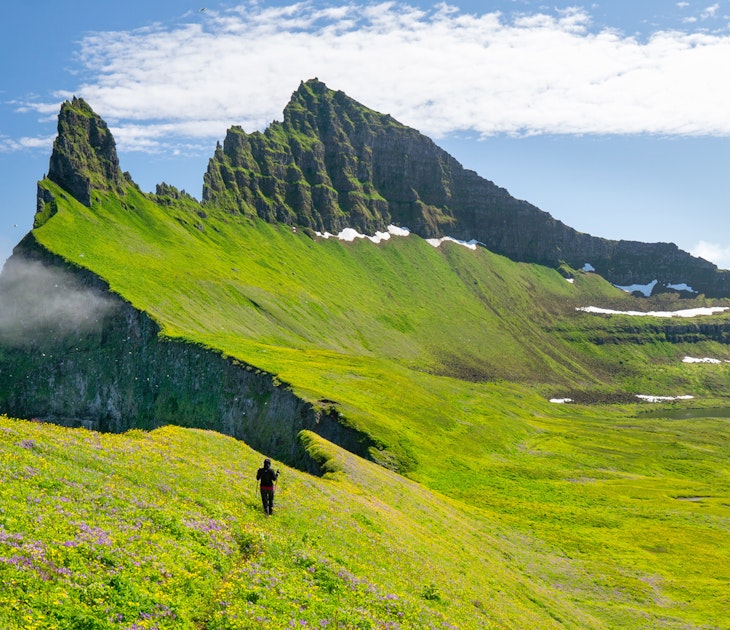
Dec 6, 2022 • 10 min read
Hiking creates a connection to a place and its landscapes. Here are 12 incredible walks from around the world to inspire you.
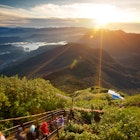
Sep 29, 2022 • 8 min read

Feb 14, 2024 • 8 min read
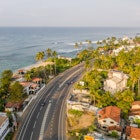
Oct 16, 2023 • 8 min read
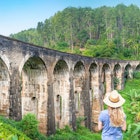
Oct 14, 2023 • 12 min read
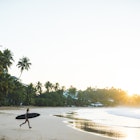
Apr 1, 2022 • 9 min read
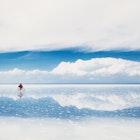
Mar 10, 2022 • 7 min read

Feb 15, 2022 • 5 min read
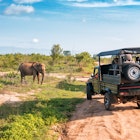
Feb 10, 2022 • 8 min read

Jan 20, 2021 • 6 min read
The Best National Parks in Sri Lanka for a Safari
This might surprise you: Sri Lanka is one of the world’s best places to go on a safari outside of Africa . Famed for its amazing wildlife, known as the ‘Sri Lanka Big Four’ (elephants, leopards, sloth bears, and blue whales), it’s no wonder that safari in Sri Lanka is popular! Because there are many spectacular national parks in Sri Lanka to choose from, it’s not easy to decide where to go on safari. Here’s a breakdown of the best national parks in Sri Lanka.
National Parks in Sri Lanka
There are over 20 national parks in Sri Lanka, with various landscapes, from open plains, beautiful lakes, bushland, grasslands, and even beaches! Where you go on safari is totally dependant on your personal preference. For example, are you keen to spot the elusive leopard, or do you prefer to see herds of elephants? This will be a factor in deciding which national park to choose from.
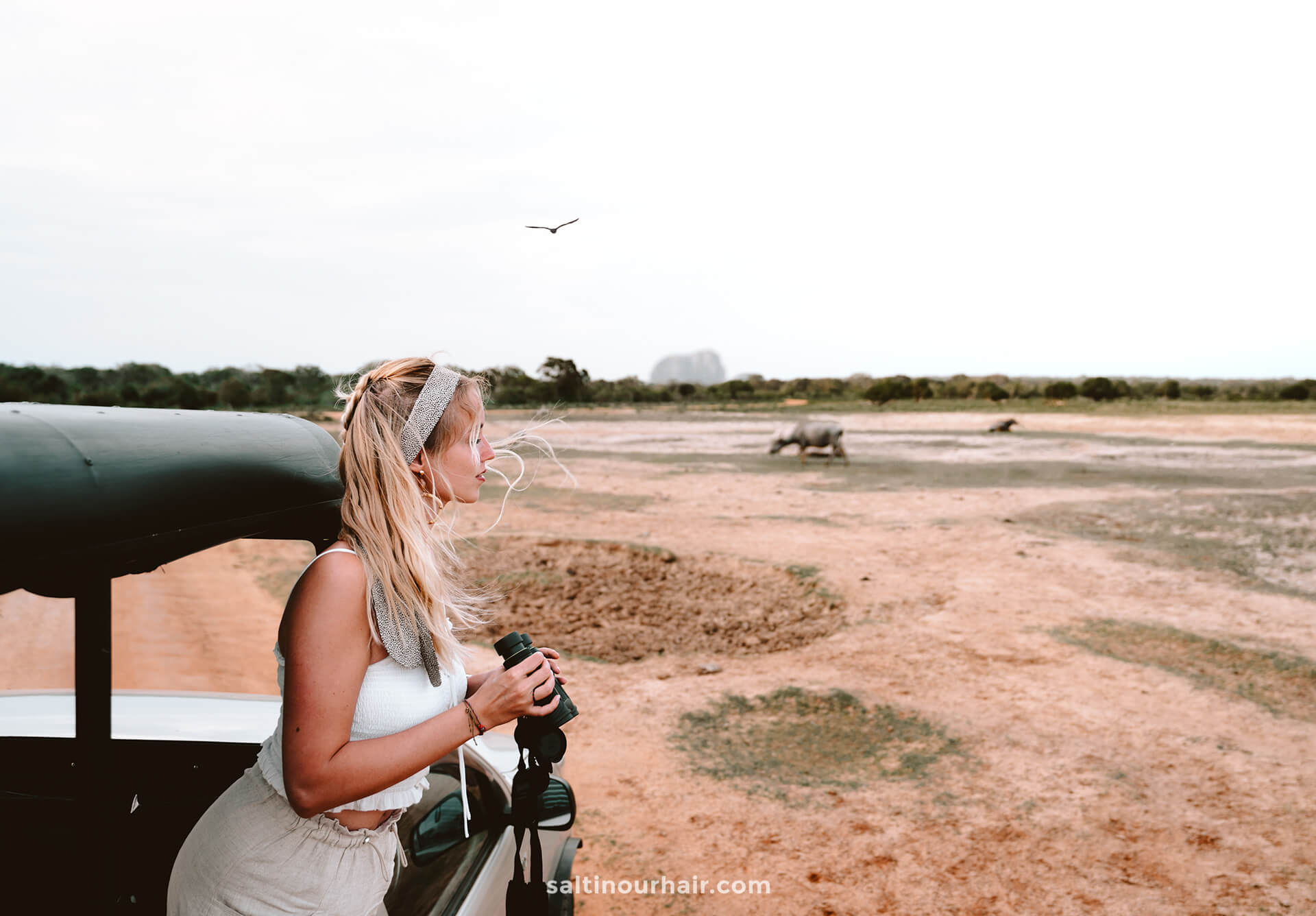
Best Time to go on Safari
There are two monsoon seasons in Sri Lanka: The northeast monsoon season which takes place from October to January and the southwest monsoon season which takes place from May to July. It’s best to avoid these times, as animals will take shelter and be harder to spot during the heavy rains. The dry seasons are an excellent time to visit national parks in Sri Lanka, as the animals come out of cover to search for water.
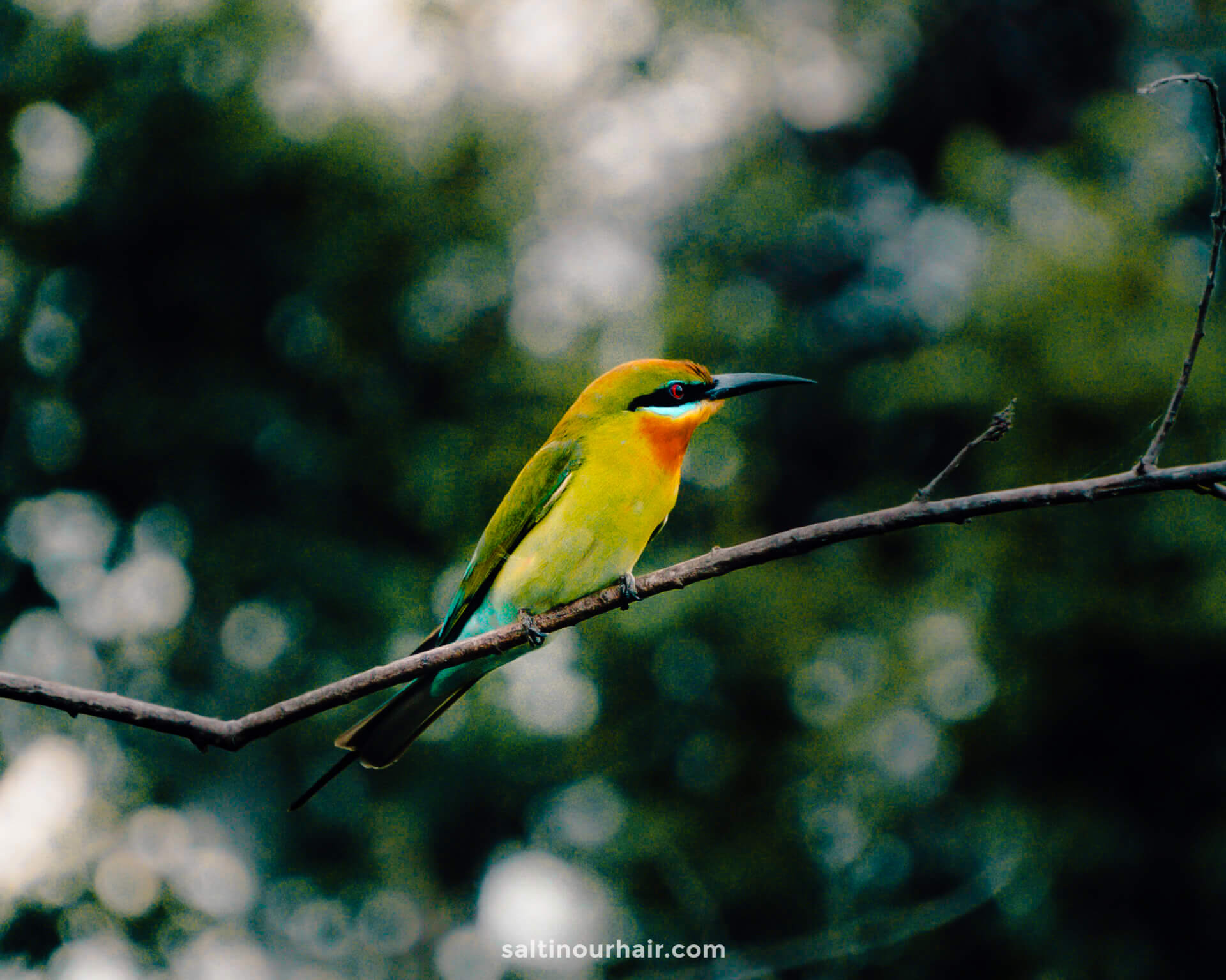
Morning or afternoon Safari in Sri Lanka?
Factor in the time of day you go on safari. This is best done in the morning, or in the evening, as in the midday sun, the animals will also take shelter. Going in the morning or the evening also means you have the opportunity to see a beautiful sunrise/sunset over the magical landscapes of Sri Lanka.
Tip: Find other people to join you on the safari, so you can split the cost of the jeep hire, which can really reduce the price of visiting a national park in Sri Lanka
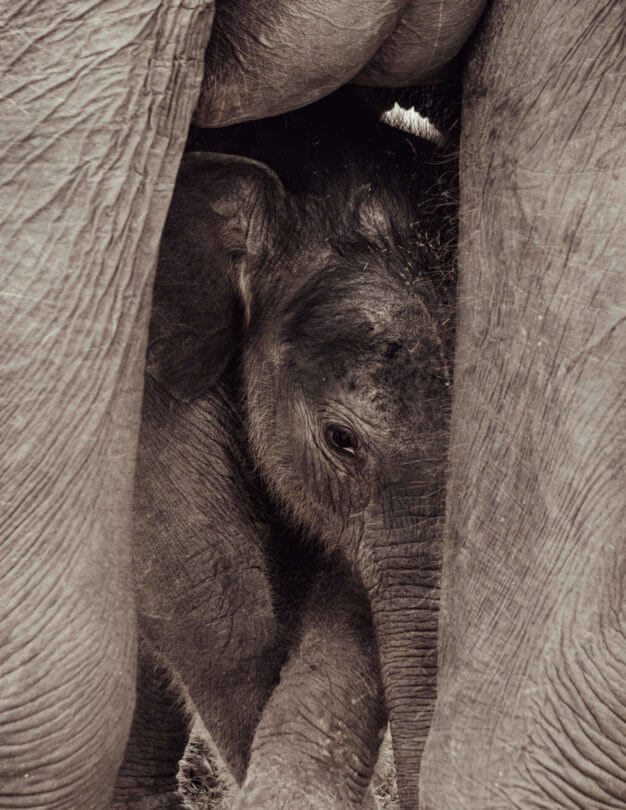
Where to spot Sri Lankan wildlife?
Yala national park in sri lanka.
Yala is the most popular national park in Sri Lanka, and for good reason! It is famous for its high leopard population (40-50 within Yala), which is actually the highest leopard density in the world! Despite this, it’s not guaranteed to see a leopard, as they are very elusive. However, your chances of a leopard sighting are much higher at Yala than in any of the other parks in Sri Lanka.
See availability for a safari tour of Yala National Park
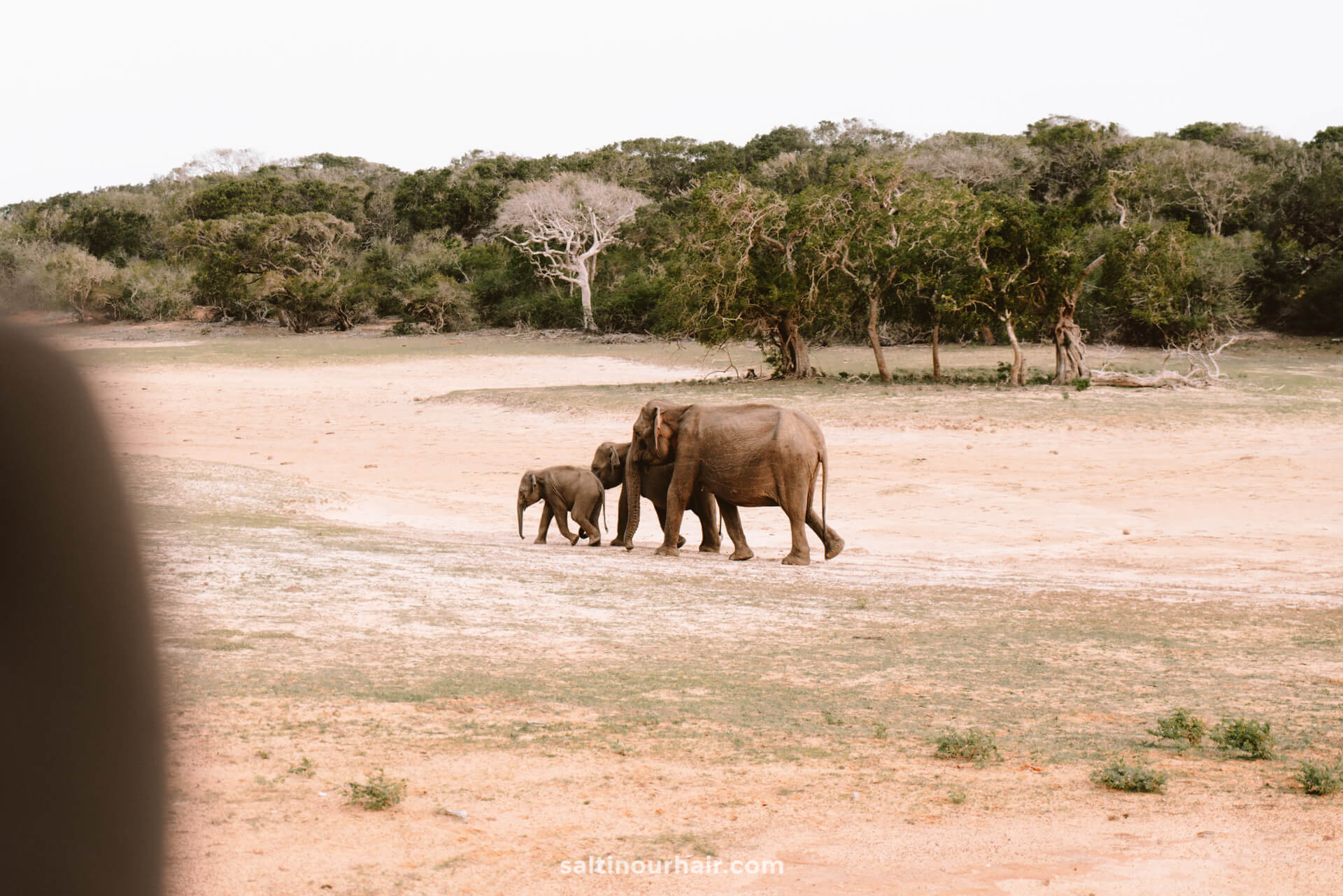
The lagoons, bushlands, and grasslands also make it a breeding ground for tonnes of other wildlife, including herds of beautiful elephants and the unique sloth bear!
Downsides: Because of Yala’s popularity, it can be very crowded. The park is doing its very best to preserve nature and wildlife, so only a few parts of the area are open to the public. Please act responsibly and do your best to be a sustainable traveler at all times.
Read: Easy ways to be a more sustainable traveler
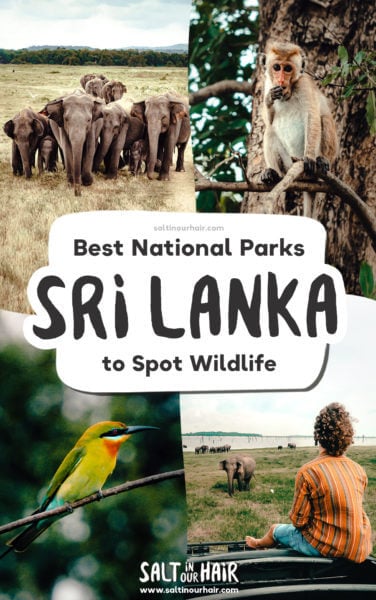
Yala Summary
- Location: On the southeast coast of Sri Lanka.
- Season: February to September (dry season). The best time to see leopards is between February to March. *Note: The park closes during the month of September.
- Animals: Best for seeing leopards. There are also 44 varieties of mammals and 215 species of birds.
- Price: $65 USD for a guided tour (entry to the park, jeep, and guide). For a private tour, you could pay upwards of $100 USD. The price is higher than in other parks in Sri Lanka because of the higher chance of seeing leopards. Book your tour to Yala in advance here .
- Where to stay: Stay in a jungle chalet at Cinnamon Wild ! This was an awesome experience that allowed us to get up close and personal with nature. You can even dine under the stars in the back of a jeep right next to crocodiles in the water.
Read: The ultimate guide to visiting Yala
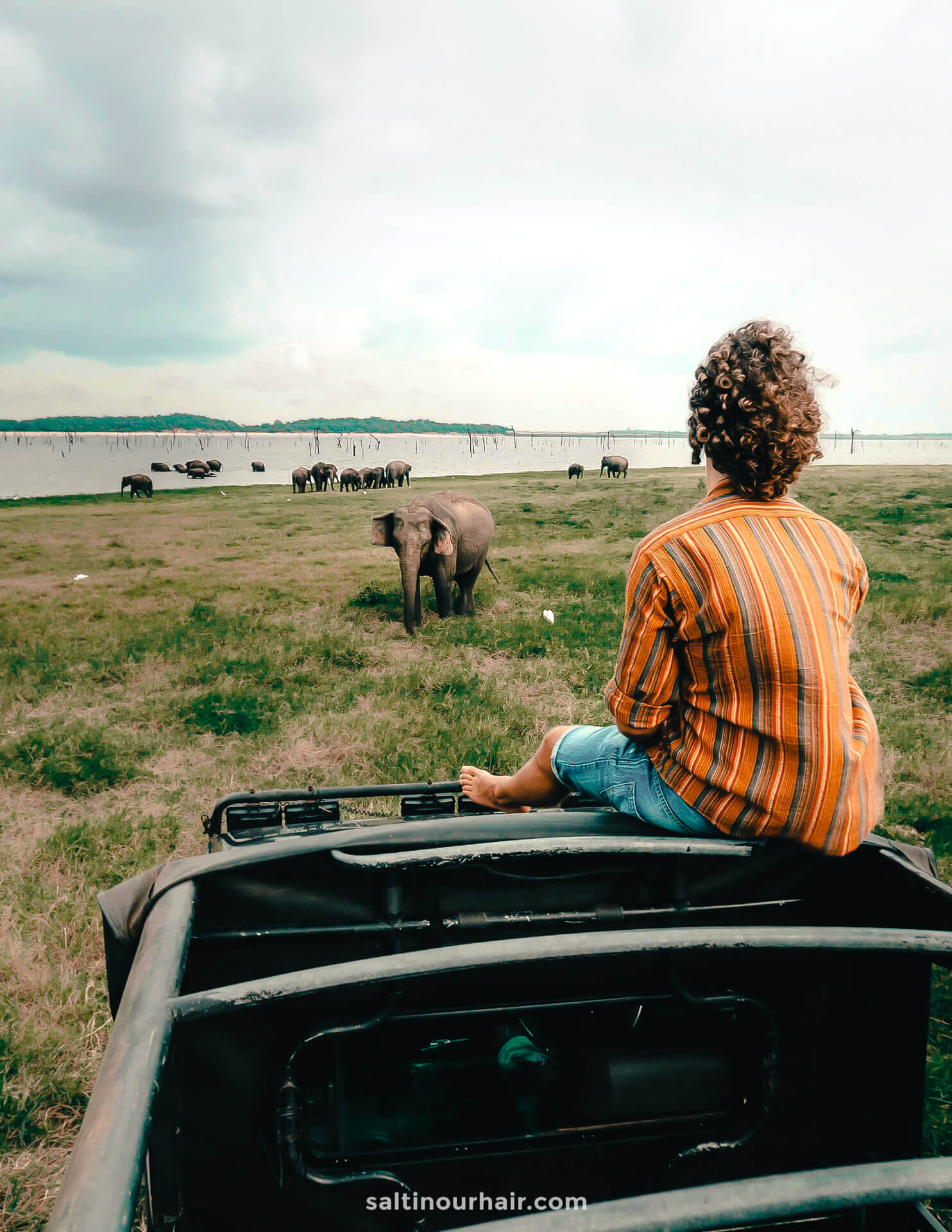
Udawalawe is Yala’s slightly lesser-known neighbor. Although it is less popular, it is still an amazing place to see animals because of its small size and open views. It is particularly good for seeing elephants as there are approximately 400-500 in the park, which is an incredibly high density in such a small area! It is also excellent for birdwatching too; thought to be one of the best birdwatching sites in the whole country!
See tickets and availability for a private safari in Udawalawe
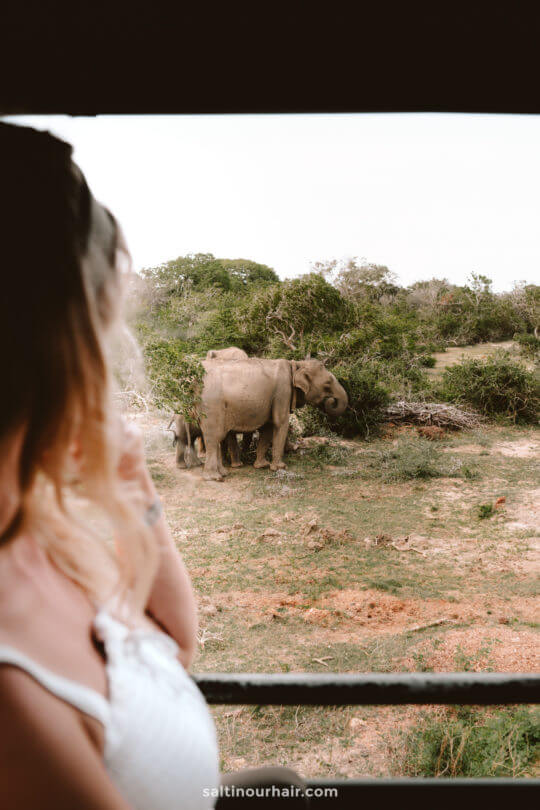
For a personal encounter with elephants, Udawalawe is the best national park in Sri Lanka! This is because the elephants here are quite confident and can get very close to vehicles. The other plus of Udawalawe is that the park is mainly open grassland (not many trees or bushes). Because of this, it is much easier to spot the animals and see beautiful views across the plains of Sri Lanka.
These are the best places to see Elephants in Sri Lanka
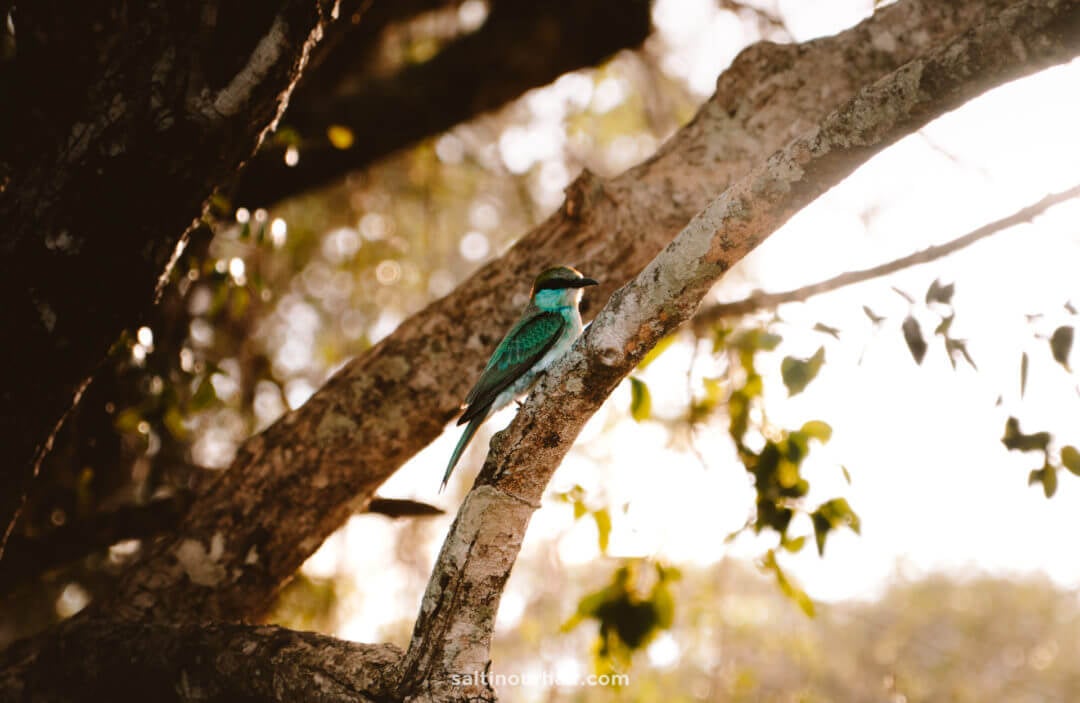
Downsides: It’s difficult to see leopards (there is about half the number of leopards that Yala has), and outside of the excellent bird and elephant watching, there aren’t many other animals to see.
Udawalawe Summary
- Location: Just inland, to the west of Yala, surrounding the huge Udawalawe reservoir.
- Season: Feb to October (dry season). If you’re visiting to see migratory birds, then visit between October and April. October to January is the best time to see baby elephants during the rainy season.
- Animals: Best for elephants and bird watching.
- Price: From 35 USD for a shared jeep to 75 USD for a private tour. Book your private tour to Udawalawe here .
- Where to stay: The park is only 1.5 hour’s drive from Dikwella , a beautiful coastal town in the south of Sri Lanka. Stay at Verse Collective : a trendy collaborative space, popular with digital nomads.
Read: Dikwella ‘The Surf & Beach Gem of Sri Lanka’
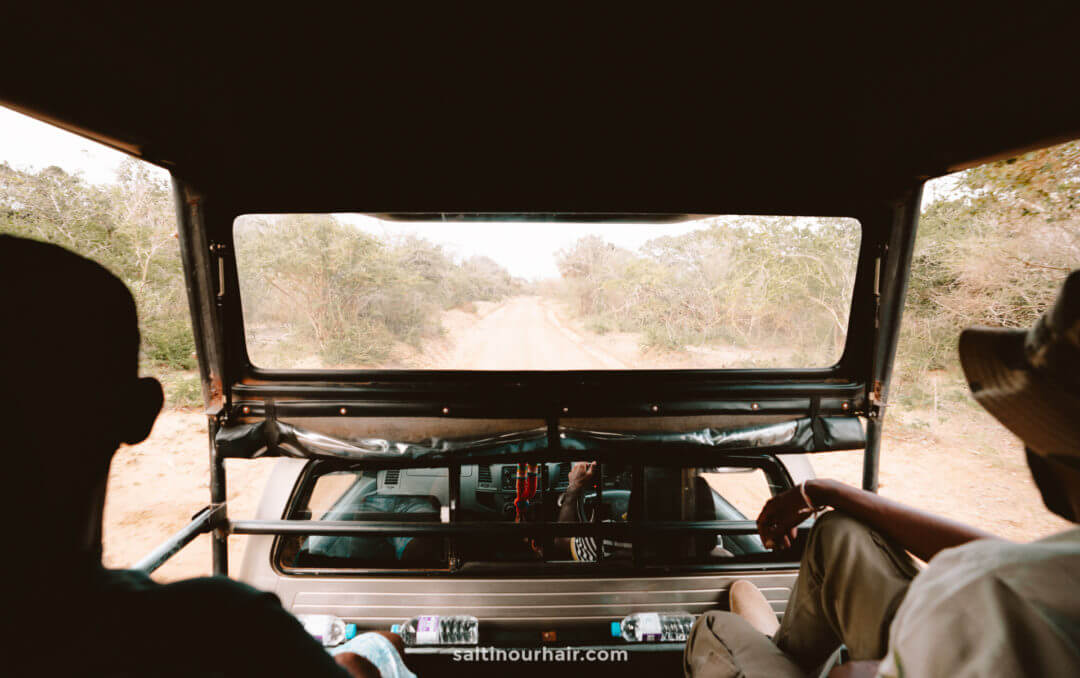
Minnerriya is most famous for the spectacular ‘elephant gathering’. During September/October, the lake dries out, and the elephants gather together around the lake and feed on the grassland. Seeing hundreds of elephants all congregated together in one area is one of the most breathtaking experiences. The lake also attracts an amazing array of birdlife, so it’s excellent for bird lovers too.
Book your jeep safari to Minerriya National Park
Downsides: Apart from elephants and birdlife, visitors are unlikely to see the variety of wildlife you would see in other national parks in Sri Lanka.
Minerriya Summary
- Location: North/Central Sri Lanka. Best to visit from Sigiriya.
- Season: July to October (dry season). Visit in September/October to see the great elephant gathering.
- Animals: Best for elephants. However, it is also possible to see two unique species of monkey, the Purple Faced Langur, and Toque Macaque.
- Price: Varies. However, it’s usually around 40-60 USD for a private tour, including pick up, drop off, and entrance fee. See availability for a jeep safari here .
- Where to stay: The park is only 30 mins from Sigiriya . Because of this, it’s best to combine a visit to the park with a visit to Lion’s Rock.
Here are all your hotel options in Sigiriya.
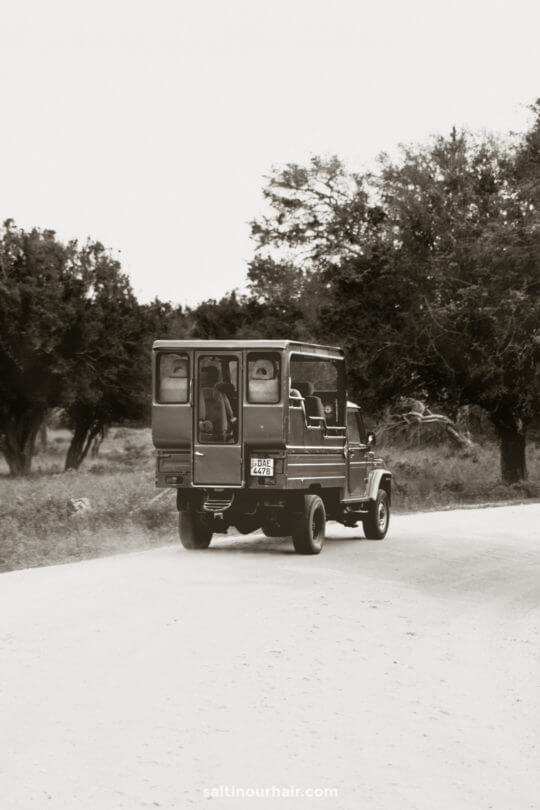
Although Minerriya is much more popular, Kaudulla sits right next door and has amazing wildlife too. Because the elephants move around between the areas, it is also possible to witness large herds of elephants here.
Book a jeep safari to Kaudulla in advance
Because the park isn’t as big or as popular as some others, there are not too many jeeps around, which makes it a much more peaceful experience. It’s even been known, in rare cases, for tourists to spot a leopard!
Downsides: Not a huge variety of animals aside from elephants.
Kaudulla: One of the best Safari Parks in Sri Lanka
Kaudulla Summary
- Location: Between Dambulla and Trincomalee. It’s possible to make a day trip from either place, but Dambulla is a bit closer.
- Season: July to October. The elephant gathering takes place during the months of September/October.
- Animals: Best for elephants (gathering). It’s also possible to see peacocks, bears, and crocodiles.
- Price: Approximately 40-60 USD per person for a private safari. See tickets and availability for a Kaudulla safari .
- Where to stay: Find the best hotels in Dambulla.
Here are all your hotel options in Dambulla.
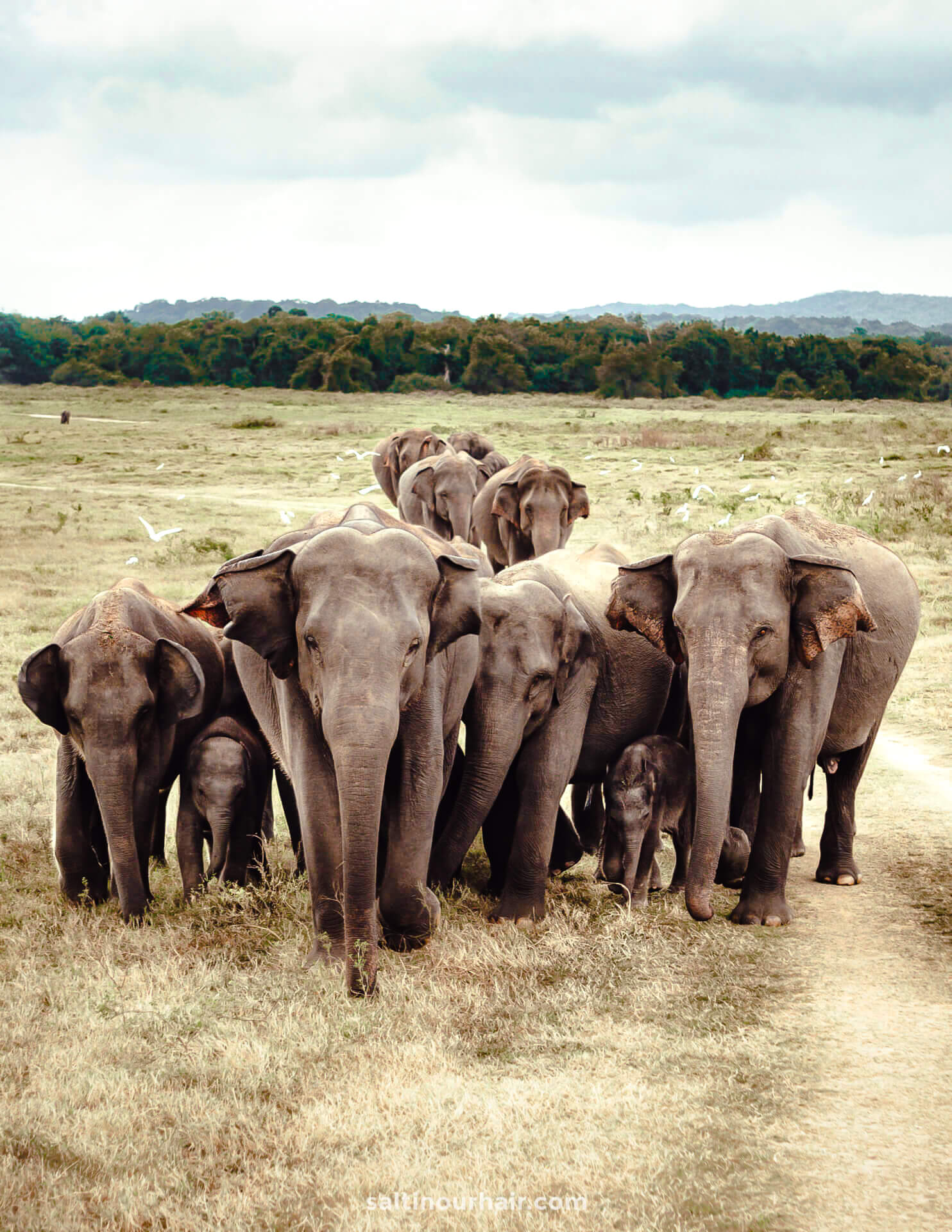
Wilpattu
Wilpattu is the hidden gem of all the national parks in Sri Lanka, famous for sightings of the reclusive sloth bear. It was the first national park created in the country (along with Yala) in 1938 and is the largest national park in Sri Lanka. Although it is relatively unknown, the park is teeming with wildlife, with leopard sightings a close second behind Yala.
Book a private tour of Wilpattu National Park
It perhaps even exceeds Yala in terms of its incredible beauty and peaceful nature. You won’t see many other jeeps here, so it’s easy to feel as if you’re the only one in the park! It also has the best infrastructure, so if you want a more comfortable Jeep ride, then Wilpattu is definitely your best option.
Downsides: Not as many elephants as in some of the other national parks.
Wilpattu Summary
- Location: Northwest of Sri Lanka, close to Anuradhapura
- Season: Feb to October (dry season) or in the summer months May-July, when the sloth bears come out to find fruits on the trees.
- Animals: Best for sightings of the sloth bear.
- Price: 30-40 USD for a half-day, 80-100 USD for a full day. See tickets and availability for a private tour of Wilpattu .
- Where to stay: See all hotels in Anuradhapura .
Which National Park in Sri Lanka is the Best?
Verdict: Wilpattu! The beauty of this park is absolutely breathtaking, made even more special by being relatively unknown and, therefore, peaceful. Because it’s so quiet, it is an excellent place to spot wildlife, and there is a high chance of seeing a multitude of wild animals. The price is reasonable considering all these factors, and with similar chances of seeing leopards as Yala, it is a great deal!
Things to Remember for Your Safari
- Non-bright clothing that is loose and comfortable. Bring layers in case the weather changes
- Shoes you don’t mind getting dirty because you might get out of the vehicle
- Camera + zoom lens
Sri Lanka Visa
In order to visit Sri Lanka, you must purchase an electronic visa online (ETA) before traveling.
How to get a visa for Sri Lanka
By purchasing through our links, you support us at no additional cost. Thank you for your support. ♥️
- Find Hotels via Booking.com
- Find a Rental Car via Sunny Cars
- Find Flights to Sri Lanka via Skyscanner
- Get a Travel Insurance via Heymondo
- Book Tours & Attractions via GetYourGuide
- Book a Bus/Train/Transfer via 12Go
Yapahuwa Rock Fortress: Sri Lanka’s Best Hidden Attraction
Sigiriya lion rock: climb the world-famous landmark, visiting yala national park: the ultimate guide.
Looking for more travel information? Plan a chat with us for personalised travel advice or get an answer from the Salt in our Hair Travel Community on Facebook.
Your email address will not be published. Required fields are marked *
Notify me when new comments are added.

Best Sri Lanka Safari: 8 Park Comparison guide
Sri Lanka might be a small island, but it’s an island that’s absolutely packed with wildlife and wilderness, and it’s fast becoming one of the most popular destinations in the world to go on safari.
Africa might the traditional haunt of safari-goers, but Sri Lanka can easily compete with the best that the African plains or the rainforests or rivers have to offer.
Across Sri Lanka’s many national parks, you can find everything from elephants to leopards, while whales cruise along the coastline and birds migrate in vast numbers to the forests through the year.
A Sri Lanka safari might just be the ultimate experience in the country, and to help you decide which is the best one for you, here’s our ultimate comparison guide!
Don’t leave home without: Lonely Planet Sri Lanka (Travel Guide)
Best Sri Lanka Safari: 8 Park Comparison Guide
Table of Contents

Yala National Park
Yala National Park could easily be the country’s most well known national park, and of course, it’s the perfect place for a Sri Lanka safari . It’s one of the country’s largest nature reserves, as well as being the most visited, and in Yala, you can find the best of Sri Lanka’s wildlife.
The huge national park encompasses several different ecosystems, ranging from semi-arid landscapes to dense wetlands.
That means that a huge variety of wildlife can be spotted here, including elephants, sloth bears, and water buffalo, which are the main mammals that tourists are looking to see on a Sri Lanka safari.
Yala also has the highest density of leopards in the country, making this prime leopard spotting territory.
Yala National Park is located in the south-east of the country, and it’s relatively easy to get here from Colombo, or from other parts of Sri Lanka. The best time to visit the park is generally in the dry season when the roads are open and there’s no chance of flooding.
Wildlife is easier to spot too because they tend to congregate around the watering holes. The dry season runs roughly from February through to June in Yala National Park.
Our top recommended safari’s in Yala National Park:
- Private Day-Trip to Yala National Park Including BBQ Dinner on the Beach
- Private Safari at Yala National Park
- Yala National Park Private Safari

Kumana National Park
Kumana National Park is the rebranded name for what was for many decades known simply as Yala East National Park. Kumana is technically part of the wider Yala area, however, it’s well worth making a trip here for its own sake, to see what a Sri Lanka Safari here has to offer.
The quick answer to that is that a Sri Lanka safari in Kumana National Park has a lot to offer, particularly if you are a lover of birds. This is a nature reserve that’s primarily set up for bird watching, but you can see all other kinds of wildlife here too.
It’s not as well advertised or well known as the traditional safari areas within Yala National Park, but that just makes it a quieter place to visit, with much less tourism.
While you’re less likely to see elephants or leopards in Kumana, you might find the experience more enjoyable on the whole, as the roads are almost empty and the whole park feels much rawer than its neighbors.
May to June is the best time of the year to visit if you’re bird watching, as this is when nesting season is, and you’ll see may rare species flocking here from thousands of miles away during their annual migrations to Sri Lanka.
Our top recommended safari’s in Kumana National Park:
- Kumana National Park Wildlife Safari
- Jeep Safari at Kumana National Park
- Afternoon Safari in Kumana National Park

Udawalawe National Park
Also found in the south of the country, Udawalawe National Park is another popular destination for a Sri Lanka safari. It’s just a few hours drive from Colombo, making this an easy national park to access, particularly if you’re short on time in the country.
Of course, that also means that Udawalawe National Park can be busy, but if you’re looking to find elephants, there are few better places than here to go on safari.
This is elephant country because the reserve is home to a large population of Sri Lankan Elephants that number up to 250, and can frequently be found at the local watering holes within the national park.
While leopards, buffalo and sloth bear also live within the park, they are incredibly rare. If you do see one of these beautiful creatures though, it will make the experience even better.
Elephants can be seen here all through the year, but for your own comfort, it’s best to visit between May and September when there’s little rainfall in Udawalawe.
Our top recommended safari’s in Udawalawe National Park:
- Udawalawe National Park Safari trip from Galle/Mirissa/Ella
- Private Safari: Udawalawe National Park Safari
- Private Day Tour: Udawalawe National Park Safari

Horton Plains National Park
North of Udawalawe, you can find Horton Plains National Park, which is a great place to visit if you are looking to escape the heat and humidity of Sri Lanka’s lowlands. Horton Plains is located high up, at an altitude of just over 2000 meters, meaning it’s much cooler than other national parks.
This is rocky, rugged, mountainous terrain, and it’s a unique place to go on a Sri Lanka Safari. While you can’t find larger animals such as elephants or leopards here, you can find a diverse range of deer species and plenty of birdlife.
It’s a great place for hiking too, given the cool climate and the magnificent views from the mountain tops.
You can visit waterfalls, seeing crashing rivers and even walk to the World’s End, a dramatic clifftop where the rocks literally drop away far below you. It’s cool all year round in Horton Plains National Park, however, the area gets hit hard during the monsoon seasons.
You’re best visiting in the dry, between January and March, to avoid the heavy rainfall that comes for much of the rest of the year.
Our top recommended safari’s in Horton Plains National Park:
- Horton Plains National Park Tour
- Horton Plains National Park : Private Guided Trekking Tour
- Horton Plains National Park Tour With Scenic Train Ride

Kaudulla National Park
For a more traditional Sri Lanka safari, then head to Kaudulla National Park , which is located in the country’s North Central Province. The park is renowned for its elephant safaris, and you’re almost guaranteed to spot them in huge numbers in the wild here.
Kaudulla is harder to get to from Colombo than other national parks, but it’s worth the extra effort and travel time because you’ll find that are far fewer tourists here than in the south of Sri Lanka.
The dry season runs from April through to October, but if you want to see huge herds of elephants moving through the park then head to Kaudulla towards the end of September, when the animals begin migrating through Kaudulla in search of the large water reserves that are found here.
As well as the elephants, you can find a whole range of other animals too, from leopards and sloths to deer and boar.
Our top recommended safari’s in Kaudulla National Park:
- Private Tour: Kaudulla National Park Safari
- Elephant Safari Kaudulla National Park: Private Tour

Minneriya National Park
Also found in North Central Province, Minneriya National Park is a great place to visit after exploring Kaudulla National Park, as they are located incredibly close to one another.
Minneriya National Park is also known for its huge elephant herds, and in fact, the same elephants are found migrating from this national park, into Kaudulla.
If it’s the elephants your after, then head here in the dry season, between April and September, when the herds congregate around the large water reservoirs that are found within the park.
When it comes to the end of September though, they’ve usually drunk those reserves dry, and that’s when they move on into Kaudulla National Park.
Our top recommended safari’s in Minneriya National Park:
- Minneriya National Park Safari
- Visit Sigiriya and Jeep Safari at Minneriya National Park
- Minneriya National Park Day Tour
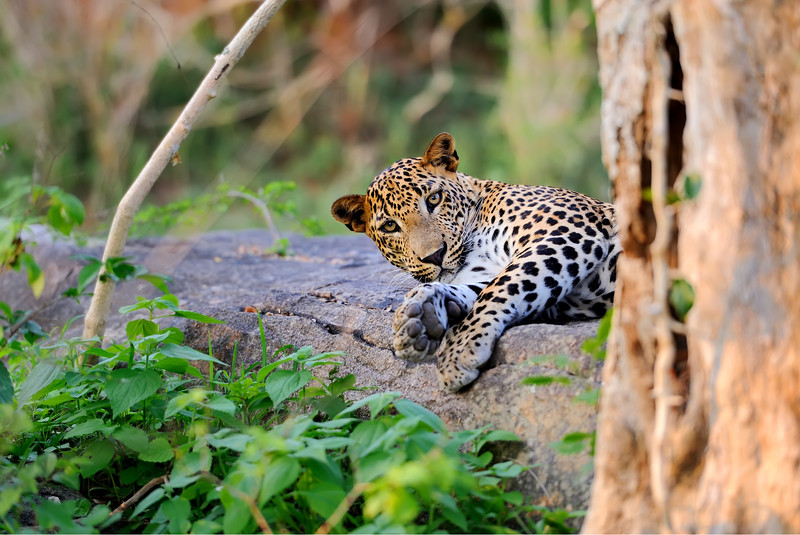
Gal Oya National Park
If you’re looking for a change from the standard jeep safari while you’re in Sri Lanka, then head to Gal Oya National Park, where instead of traveling overland in search of the wildlife, you can take a cruise along the river.
Gal Oya National Park is located on Sri Lanka’s eastern coast, and this is ecotourism at its best in the country. The park protects one of the largest water reservoirs in Sri Lanka, and it’s fed by a network of waterways.
You can stay at riverside lodges, before taking to the water in local boats to experience one of the most exciting Sri Lanka safaris. As you cruise along the quiet rivers you can spot wildlife in the surrounding trees and foliage, and within the national park, you can find deer, buffalo, and even leopards.
The park is also home to a permanent population of elephants, while Bird Island is an important nesting ground for Sri Lankan birds.
Our top recommended safari’s in Gal Oya National Park:
- Gal Oya National Park Boat Safari
- Overnight adventure tour to Gal Oya National Park with Return Transfers
- Afternoon Game Drive in Gal Oya National Park with MICE Team

Whale Watching Safaris
As well as the bountiful national parks that are found on land, the country has a growing reputation for whale watching, and in the right season, along much of the coastline, you can see these beautiful marine mammals on the open ocean.
Whale Watching makes for a great Sri Lanka safari, and you can spot them along the southern and eastern coast at different points throughout the year.
Mirissa, on the south coast, is the most popular spot in Sri Lanka for whale watching, with spectacular, sandy beaches and plenty of great hotels and tourist infrastructure that makes for an all-round excellent experience.
The whales make their first appearance in November, and you can spot them right up until April.
After April, the whales begin to move along the eastern coast, as they migrate north. You can head far north to Trincomalee between June and October. You can see many different species on a whale watching Sri Lanka safari, ranging from Blue Whales and Sperm Whales to Minke Whales and Orcas.
Our top recommended Whale Watching Safari’s:
- Whales Watching at Mirissa
- Mirissa Whale Watching
- Whale Watching Tour
More on Sri Lanka:
- Ultimate Sri Lanka Itinerary: 2 Weeks to 4 Weeks
- The Most Spectacular Places to Visit in Sri Lanka
- 10 Sri Lanka Beaches You’d Be Foolish to Miss
- 11 Epic Reasons to Visit Arugam Bay (Spoiler: Epic Breaches!)
- 10 Epic Things to do in Ella, Sri Lanka
- 9 Epic Reasons to Visit Mirissa, Sri Lanka
- Boogie Boarding in Sri Lanka
Did you like this story? Share it!
Travel planning resources, about lina stock.
Lina is an award-winning photographer and writer that has been exploring the world since 2001. She has traveled to 100 countries on all 7 continents. Member: SATW, NATJA, ATTA, ITWA
Leave a Comment Cancel reply


Places to Visit Travel Guide
Sri lanka wildlife safari: explore 14 national parks in 2023.
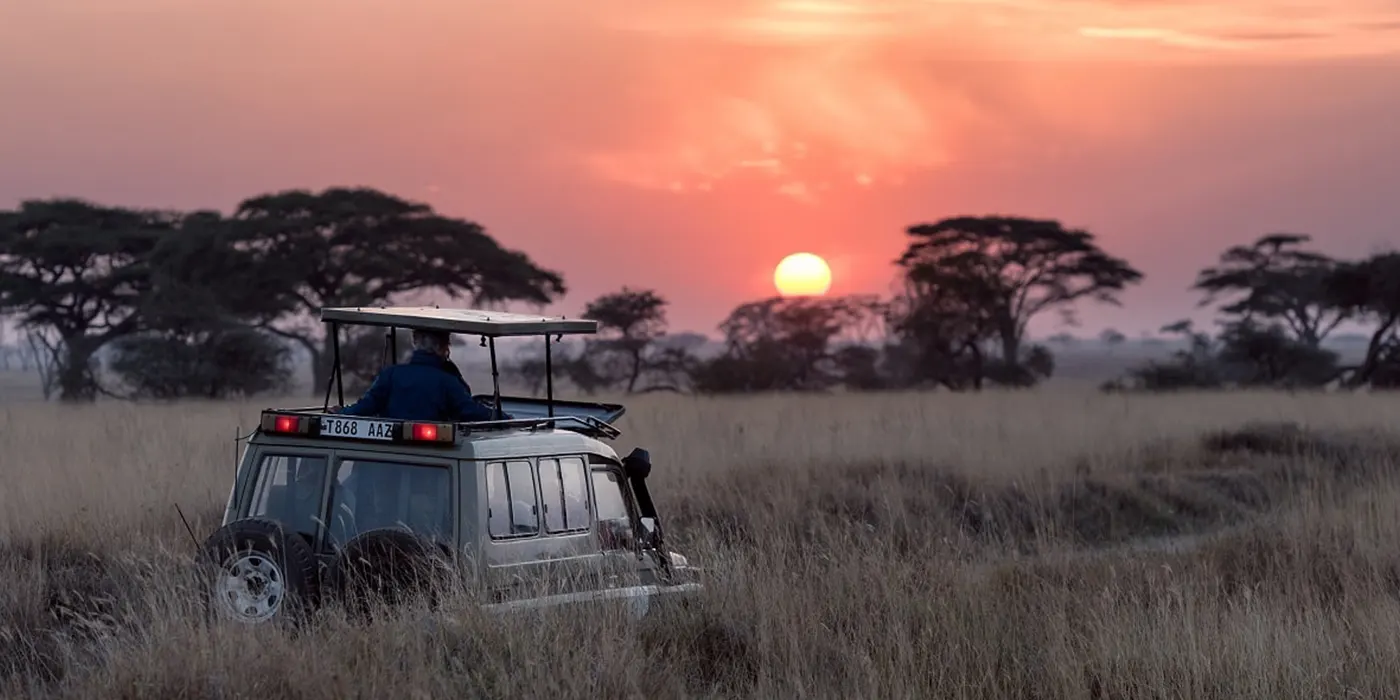
Planning a trip to Sri Lanka? If so, you’re in for a treat! This beautiful island nation is home to a diverse range of wildlife, making it a perfect destination for a safari.
When we think of safaris, we typically think of Africa. But Sri Lanka is home to some of the most incredible wildlife in the world, including the Sri Lankan leopard, elephant, and sloth bear. These animals, along with the blue whale and sperm whale, make up the country’s Big Five, which draw crowds of tourists each year.
In this guide, we will discuss everything you need to know about Sri Lanka safaris, including:
- The best time to go on a safari in Sri Lanka
- The different types of safaris available in Sri Lanka
- The top national parks for safaris in Sri Lanka
- How to book a safari in Sri Lanka
- What to pack for a safari in Sri Lanka
- Tips for enjoying your safari in Sri Lanka
Quick Links To Explore
Why you should go on a Sri Lanka wildlife safari ?

See a wide variety of animals
Sri Lanka is home to over 200 species of mammals, 400 species of birds, and many more. On a wildlife safari, you’ll have the chance to see some of these amazing animals up close, including elephants, leopards, lions, and many more.
Experience the beauty of Sri Lanka’s natural environment
Sri Lanka is a beautiful country with a diverse landscape. On a wildlife safari, you’ll get to explore the lush jungles, dry grasslands, and beaches of Sri Lanka.
Learn about Sri Lanka’s wildlife
On a wildlife safari, you’ll learn about the behavior and ecology of the animals you see. You’ll also learn about the conservation efforts that are being made to protect these animals.
Have an unforgettable adventure
A wildlife safari in Sri Lanka is an unforgettable experience that will leave you feeling connected to nature. You’ll have the chance to see some of the most amazing animals in the world in their natural habitat.
Yala National Park Safari
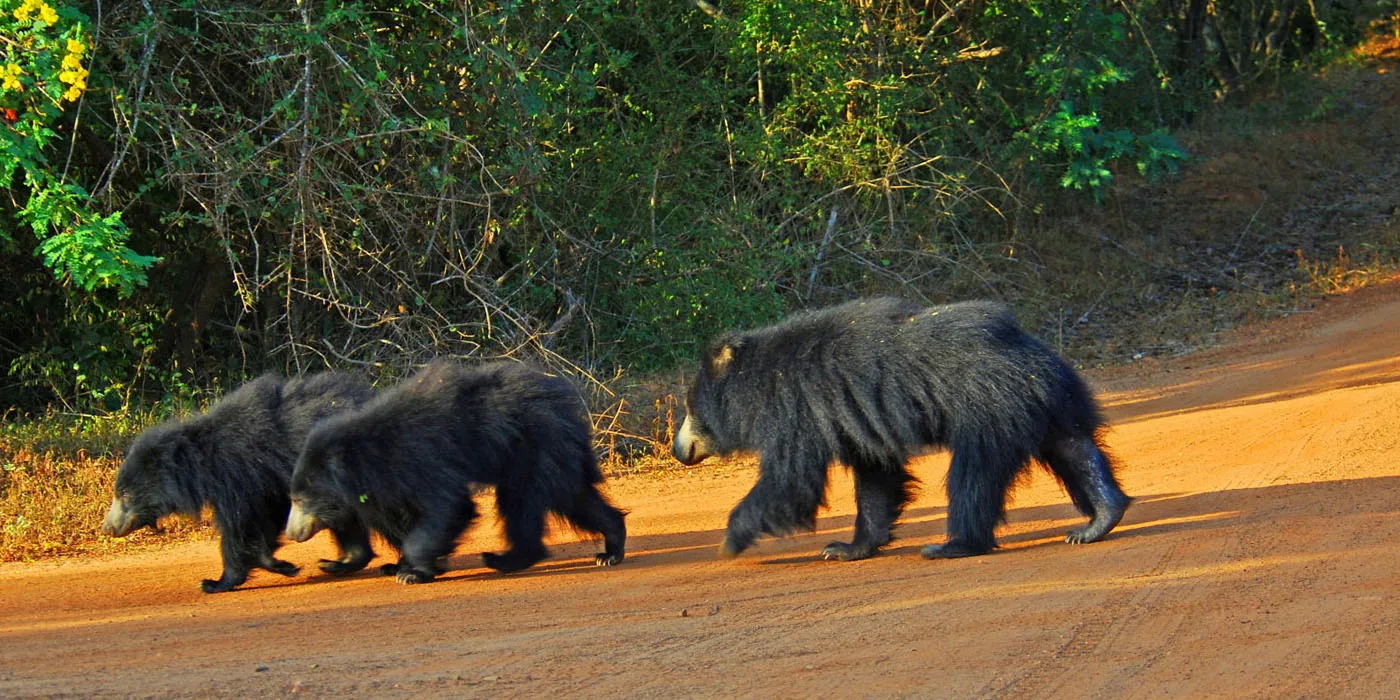
Yala National Park is one of the most popular wildlife destinations in Sri Lanka, and for good reason. The park is home to an incredible variety of animals, including leopards, elephants, sloth bears, crocodiles, and many more. A safari in Yala is a truly unforgettable experience, and it’s the perfect way to see Sri Lanka’s wild side.
What to expect on a Yala National Park safari
A Yala National Park safari is a truly unique experience. You’ll have the chance to see some of the rarest and most elusive animals in the world, up close and in their natural habitat. Some of the animals you might see on a safari include:
Leopards: Yala is home to the highest density of leopards in the world, so you have a good chance of seeing one on your safari. Leopards are elusive creatures, but if you’re lucky, you might see one sunning itself on a rock or stalking its prey.
Elephants: Elephants are another common sight in Yala. You might see them grazing in the grasslands, bathing in the lakes, or even playing with each other.
Sloth bears: Sloth bears are one of the most charismatic animals in Yala. They’re slow-moving and lumbering, but they’re also incredibly powerful. You might see them foraging for food in the grasslands or sleeping in the trees.
Related reading: Sri Lankan Sloth Bear
Crocodiles: Crocodiles are a common sight in the lakes and rivers of Yala. They’re usually well-camouflaged, so you might not see them at first, but if you keep your eyes peeled, you’re sure to spot one.
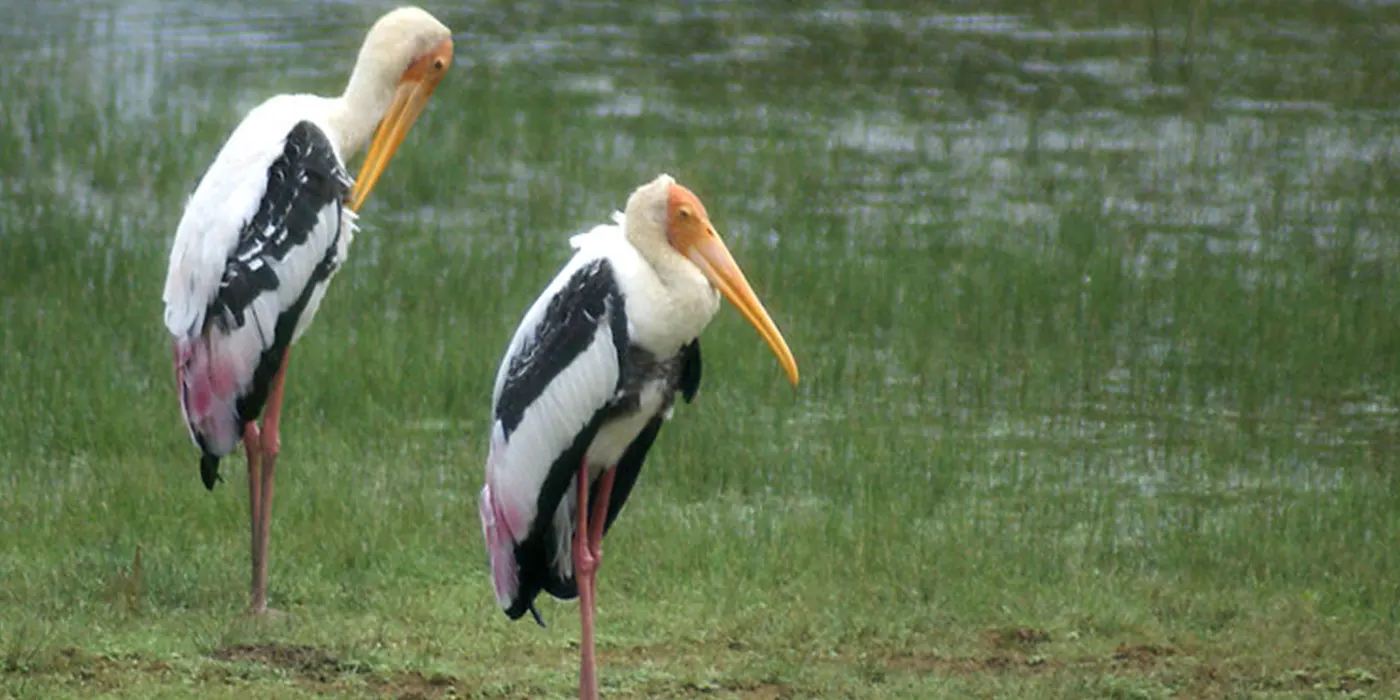
Birds: Yala is also home to a wide variety of birds, including peacocks, eagles, and storks. You might even see some rare birds, such as the Sri Lanka junglefowl.
When to go on a Yala National Park safari
The best time to go on a Yala National Park safari is during the dry season, which runs from December to April. During this time, the animals are more active and easier to see. However, Yala is a beautiful park year-round, so you can go on a safari at any time of year.
Read More About: Yala National Park
How to book a Yala National Park safari
There are a few different ways to book a Yala National Park safari. You can book through a tour operator, such as Lanka Tour Experts, or you can book directly with a safari company.
If you book through us, we will take care of all the arrangements for you, including transportation, accommodation, and the safari itself. We offer a variety of safaris to suit all budgets, from budget-friendly options to more luxurious experiences.
Udawalawe National Park Safari
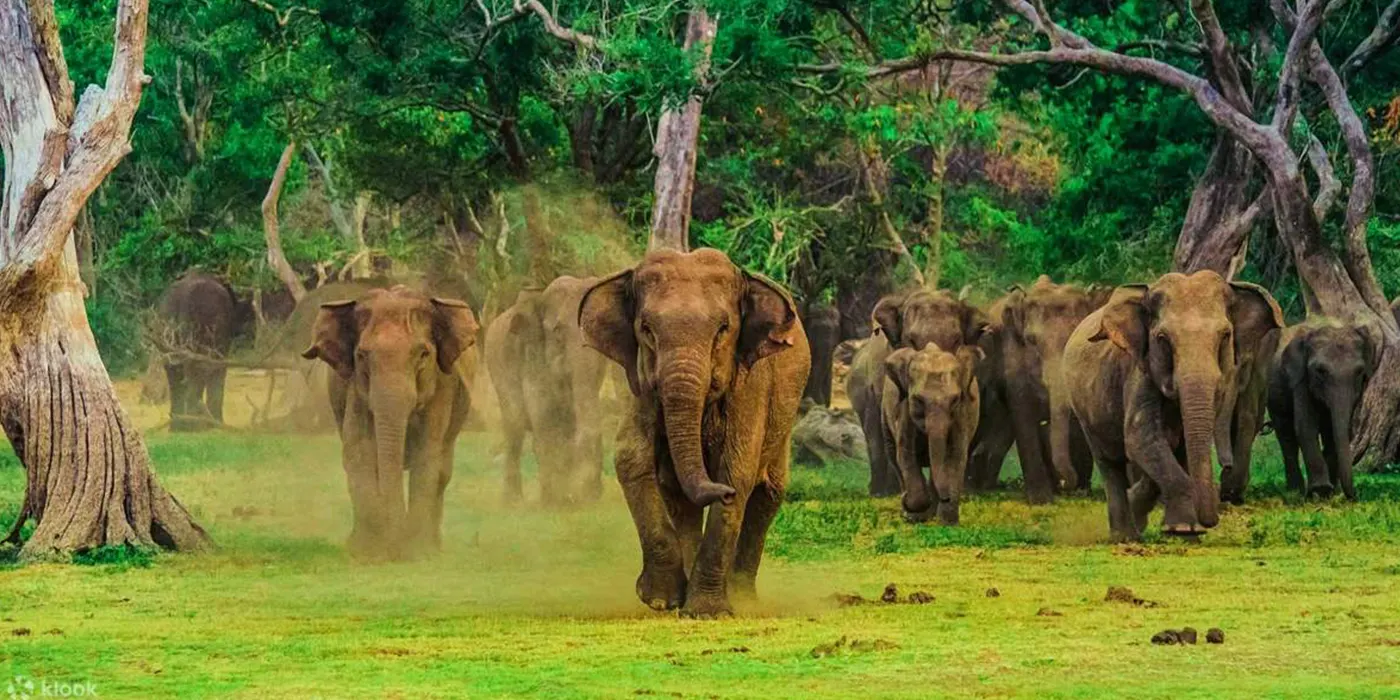
Udawalawe National Park is one of Sri Lanka’s most popular wildlife destinations, and for good reason. The park is home to an incredible variety of animals, including elephants, water buffalo, crocodiles, monkeys, and many more. A safari in Udawalawe is a truly unforgettable experience, and it’s the perfect way to see Sri Lanka’s wild side.
What to expect on an Udawalawe National Park safari
An Udawalawe National Park safari is a truly unique experience. You’ll have the chance to see some of the rarest and most elusive animals in the world, up close and in their natural habitat. Some of the animals you might see on a safari include:
Elephants: Udawalawe is home to a large population of elephants, making it one of the best places in Sri Lanka to see these majestic creatures. You might see them grazing in the grasslands, bathing in the lakes, or even playing with each other.
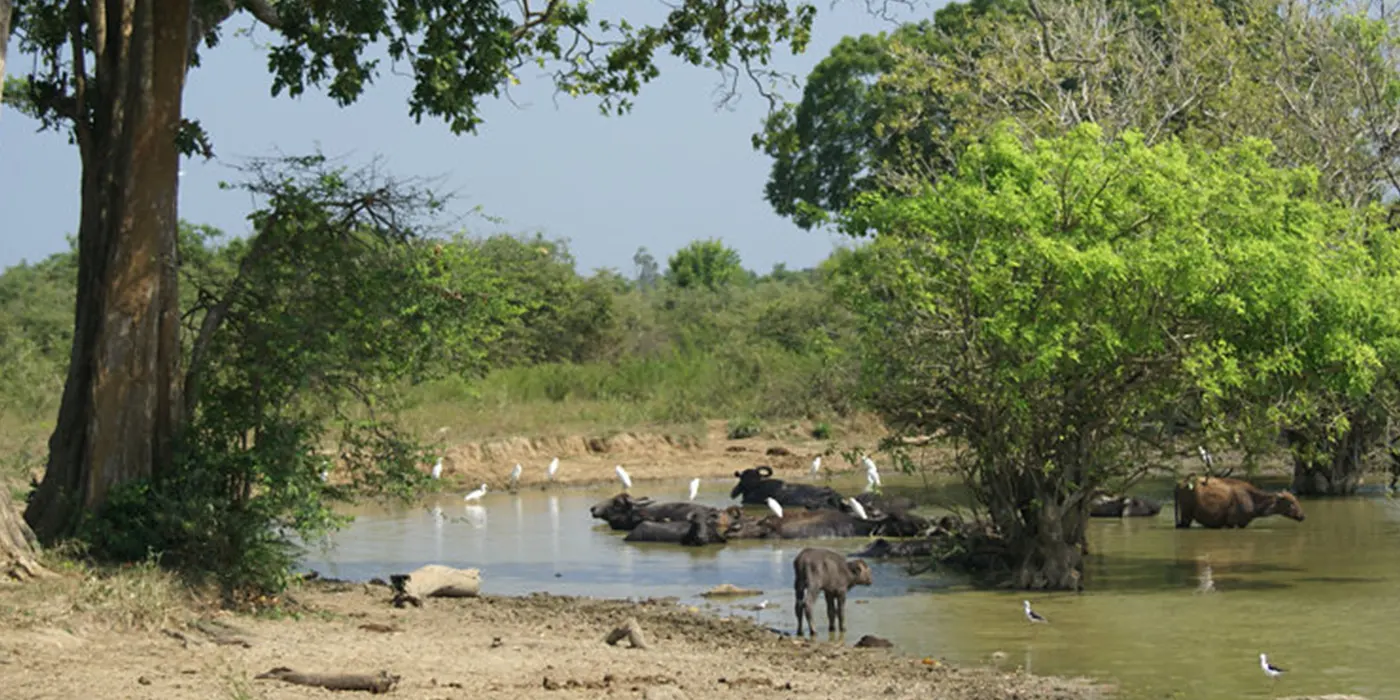
Water buffalo: Water buffalo are another common sight in Udawalawe. These large, powerful animals are often seen grazing in the grasslands or cooling off in the lakes.
Crocodiles: Crocodiles are a common sight in the lakes and rivers of Udawalawe. They’re usually well-camouflaged, so you might not see them at first, but if you keep your eyes peeled, you’re sure to spot one.
Monkeys: Udawalawe is also home to a variety of monkeys, including langurs, macaques, and toque macaques. You might see them swinging through the trees, foraging for food, or playing with each other.
Birds: Udawalawe is also home to a wide variety of birds, including peacocks, eagles, and storks. You might even see some rare birds, such as the Sri Lanka junglefowl.
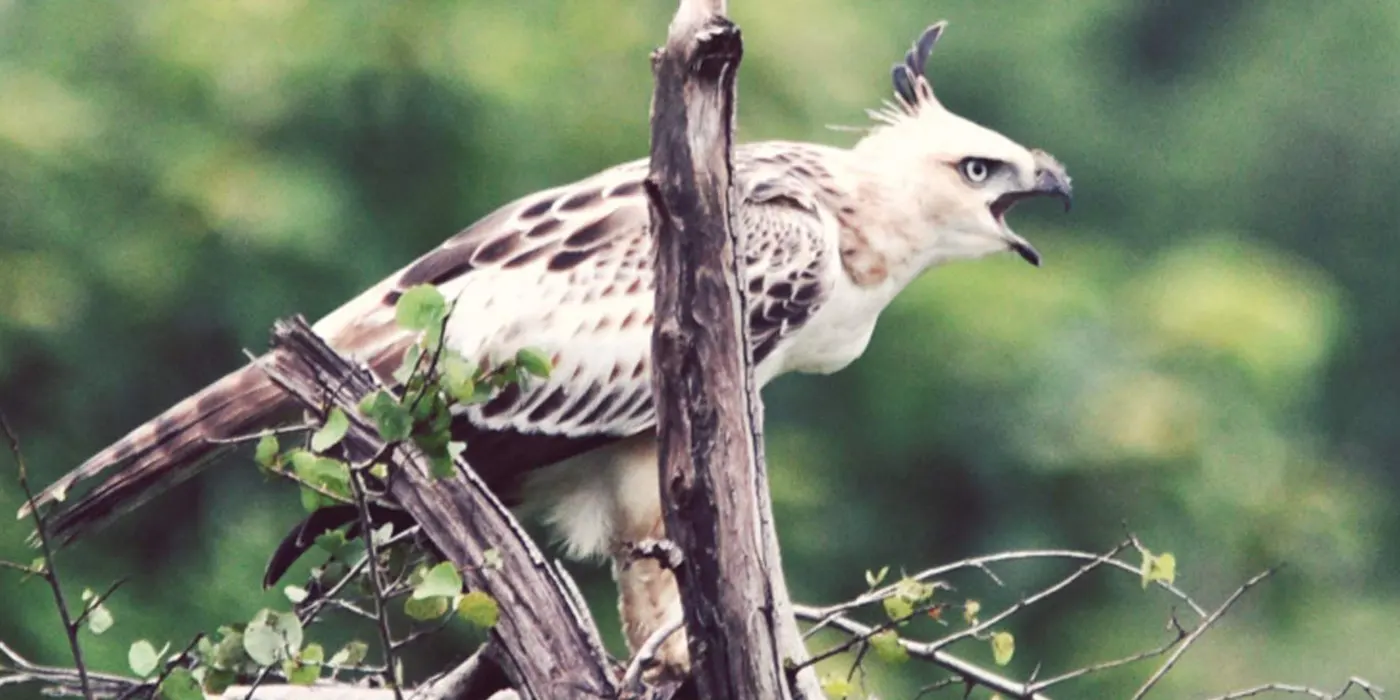
When to go on an Udawalawe National Park safari
The best time to go on an Udawalawe National Park safari is during the dry season, which runs from December to April. During this time, the animals are more active and easier to see. However, Udawalawe is a beautiful park year-round, so you can go on a safari at any time of year.
Read More About: Udawalawe National Park
How to book an Udawalawe National Park safari
There are a few different ways to book an Udawalawe National Park safari. You can book through a tour operator, such as Lanka Tour Experts, or you can book directly with a safari company.
Wilpattu National Park Safari
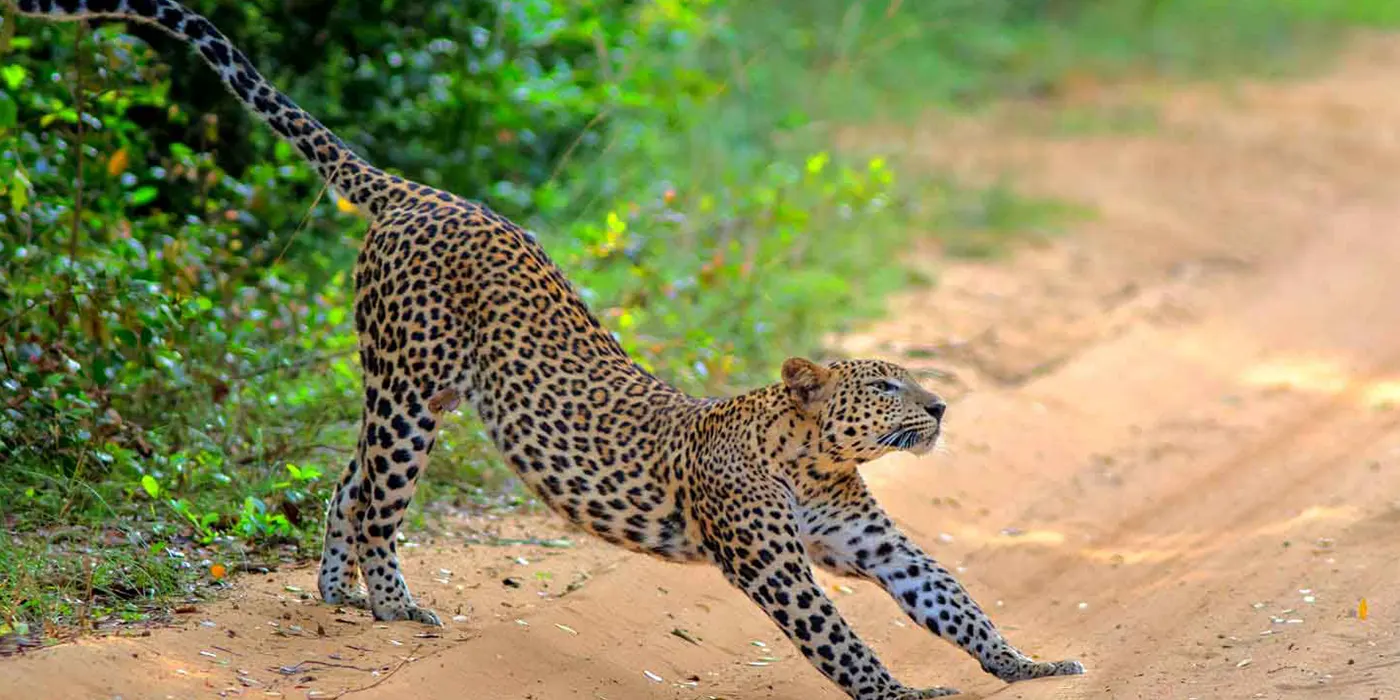
Wilpattu National Park is one of the largest and most biodiverse national parks in Sri Lanka. It is home to an incredible variety of animals, including leopards, elephants, sloth bears, crocodiles, and many more. A safari in Wilpattu is a truly unforgettable experience, and it’s the perfect way to see Sri Lanka’s wild side.
What to expect on a Wilpattu National Park safari
A Wilpattu National Park safari is a truly unique experience. You’ll have the chance to see some of the rarest and most elusive animals in the world, up close and in their natural habitat. Some of the animals you might see on a safari include:
Leopards: Wilpattu is home to the highest density of leopards in the world, so you have a good chance of seeing one on your safari. Leopards are elusive creatures, but if you’re lucky, you might see one sunning itself on a rock or stalking its prey.
Elephants: Elephants are another common sight in Wilpattu. You might see them grazing in the grasslands, bathing in the lakes, or even playing with each other.
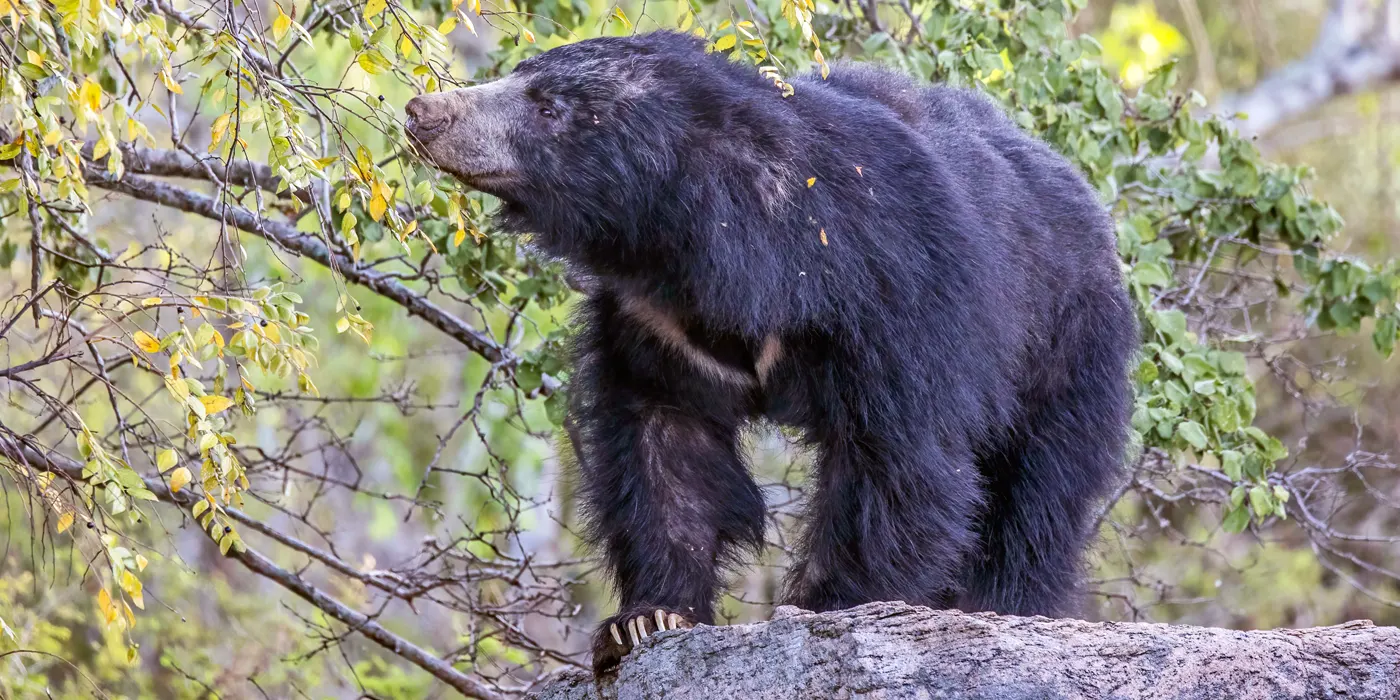
Sloth bears: Sloth bears are one of the most charismatic animals in Wilpattu. They’re slow-moving and lumbering, but they’re also incredibly powerful. You might see them foraging for food in the grasslands or sleeping in the trees.
Crocodiles: Crocodiles are a common sight in the lakes and rivers of Wilpattu. They’re usually well-camouflaged, so you might not see them at first, but if you keep your eyes peeled, you’re sure to spot one.
Birds: Wilpattu is also home to a wide variety of birds, including peacocks, eagles, and storks. You might even see some rare birds, such as the Sri Lanka junglefowl.
When to go on a Wilpattu National Park safari
The best time to go on a Wilpattu National Park safari is during the dry season, which runs from December to April. During this time, the animals are more active and easier to see. However, Wilpattu is a beautiful park year-round, so you can go on a safari at any time of year.
How to book a Wilpattu National Park safari
There are a few different ways to book a Wilpattu National Park safari. You can book through a tour operator, such as Lanka Tour Experts, or you can book directly with a safari company.
Kumana National Park Safari
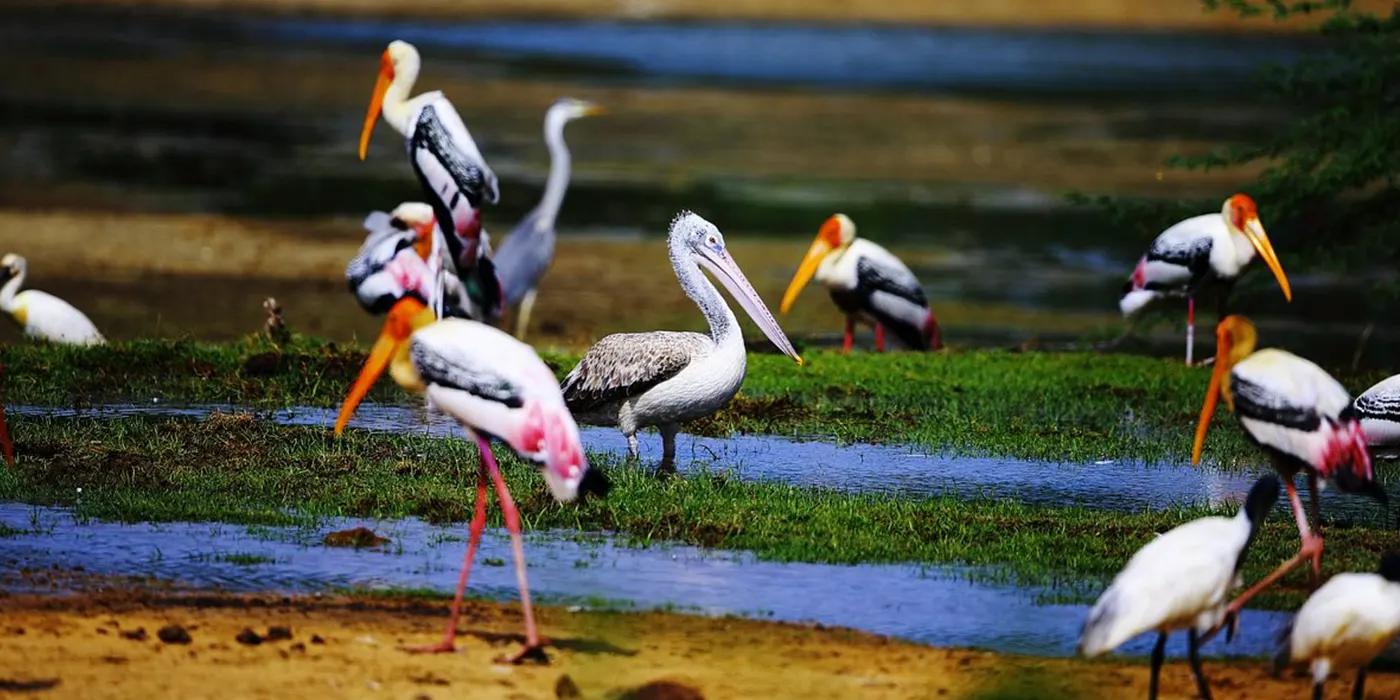
Kumana National Park is one of Sri Lanka’s most beautiful and biodiverse national parks. It is home to an incredible variety of animals, including elephants, leopards, sloth bears, crocodiles, and many more. However, Kumana is also a birdwatcher’s paradise, with over 200 species of birds calling the park home. A safari in Kumana is a truly unforgettable experience, and it’s the perfect way to see Sri Lanka’s wild side.
What to expect on a Kumana National Park safari
A Kumana National Park safari is a truly unique experience. You’ll have the chance to see some of the rarest and most elusive animals in the world, up close and in their natural habitat. Some of the animals you might see on a safari include:
Elephants: Elephants are another common sight in Kumana. You might see them grazing in the grasslands, bathing in the lakes, or even playing with each other.
Leopards: Leopards are one of the most sought-after animals to see in Kumana, but they are also one of the most elusive. If you’re lucky, you might spot one sunning itself on a rock or stalking its prey.
Sloth bears: Sloth bears are one of the most charismatic animals in Kumana. They’re slow-moving and lumbering, but they’re also incredibly powerful. You might see them foraging for food in the grasslands or sleeping in the trees.
Crocodiles: Crocodiles are a common sight in the lakes and rivers of Kumana. They’re usually well-camouflaged, so you might not see them at first, but if you keep your eyes peeled, you’re sure to spot one.
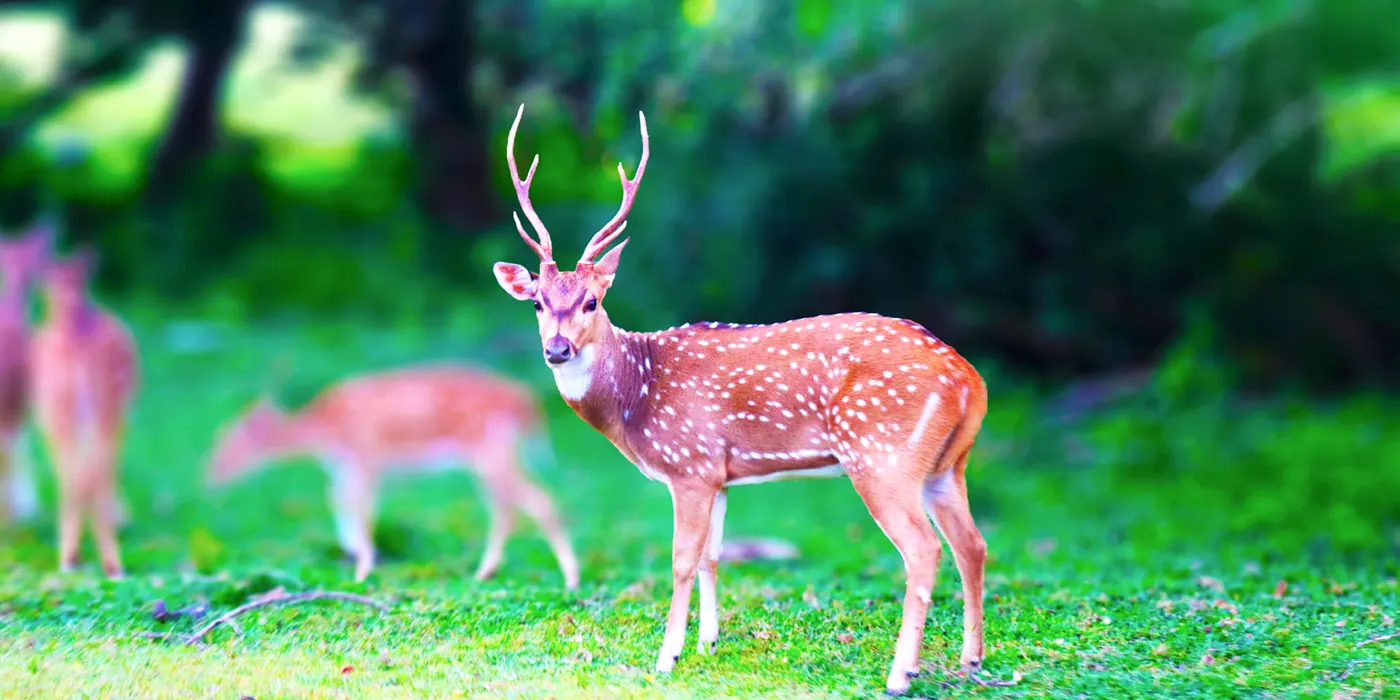
Birds: Kumana is a birdwatcher’s paradise, with over 200 species of birds calling the park home. You might see anything from storks and eagles to kingfishers and warblers.
When to go on a Kumana National Park safari
The best time to go on a Kumana National Park safari is during the dry season, which runs from December to April. During this time, the animals are more active and easier to see. However, Kumana is a beautiful park year-round, so you can go on a safari at any time of year.
How to book a Kumana National Park safari
There are a few different ways to book a Kumana National Park safari. You can book through a tour operator, such as Lanka Tour Experts, or you can book directly with a safari company.
Wasgamuwa National Park Safari
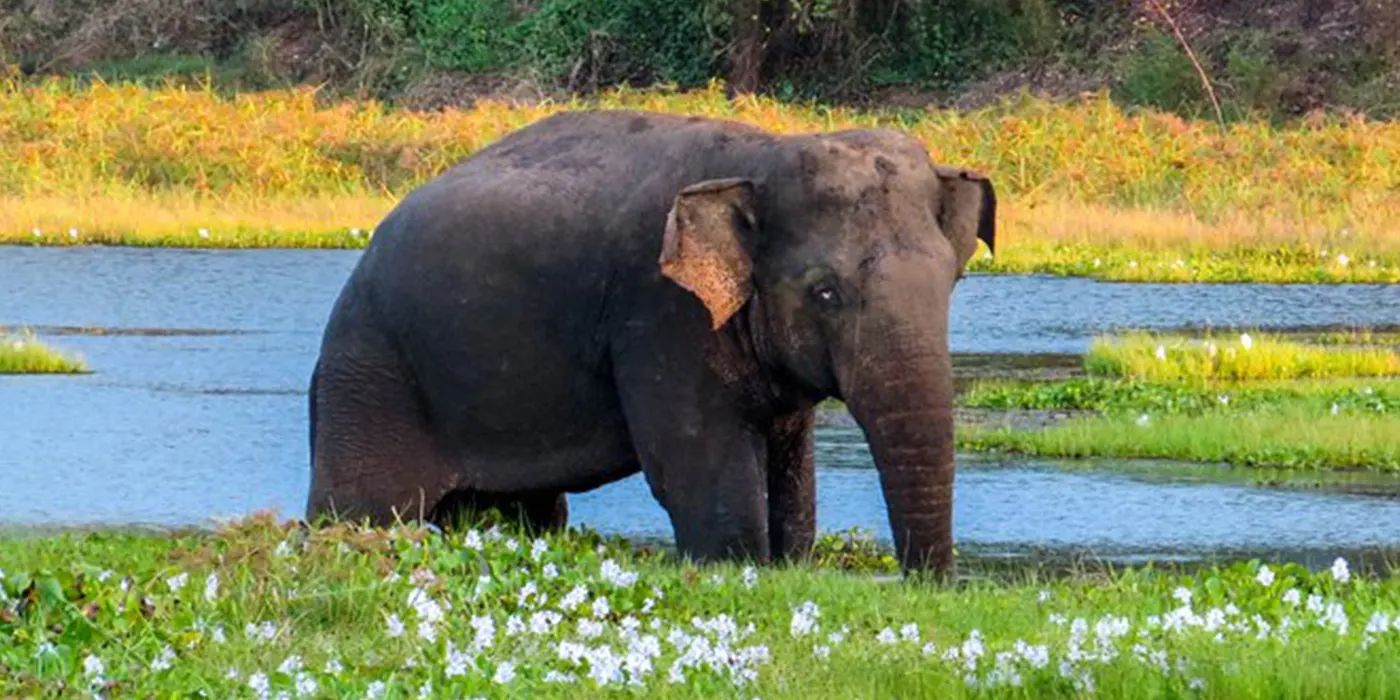
Wasgamuwa National Park is one of Sri Lanka’s most popular wildlife destinations, and for good reason. The park is home to an incredible variety of animals, including elephants, water buffalo, crocodiles, monkeys, and many more. A safari in Wasgamuwa is a truly unforgettable experience, and it’s the perfect way to see Sri Lanka’s wild side.
What to expect on a Wasgamuwa National Park safari
A Wasgamuwa National Park safari is a truly unique experience. You’ll have the chance to see some of the rarest and most elusive animals in the world, up close and in their natural habitat. Some of the animals you might see on a safari include:
Elephants: Wasgamuwa is home to a large population of elephants, making it one of the best places in Sri Lanka to see these majestic creatures. You might see them grazing in the grasslands, bathing in the lakes, or even playing with each other.
Water buffalo: Water buffalo are another common sight in Wasgamuwa. These large, powerful animals are often seen grazing in the grasslands or cooling off in the lakes.
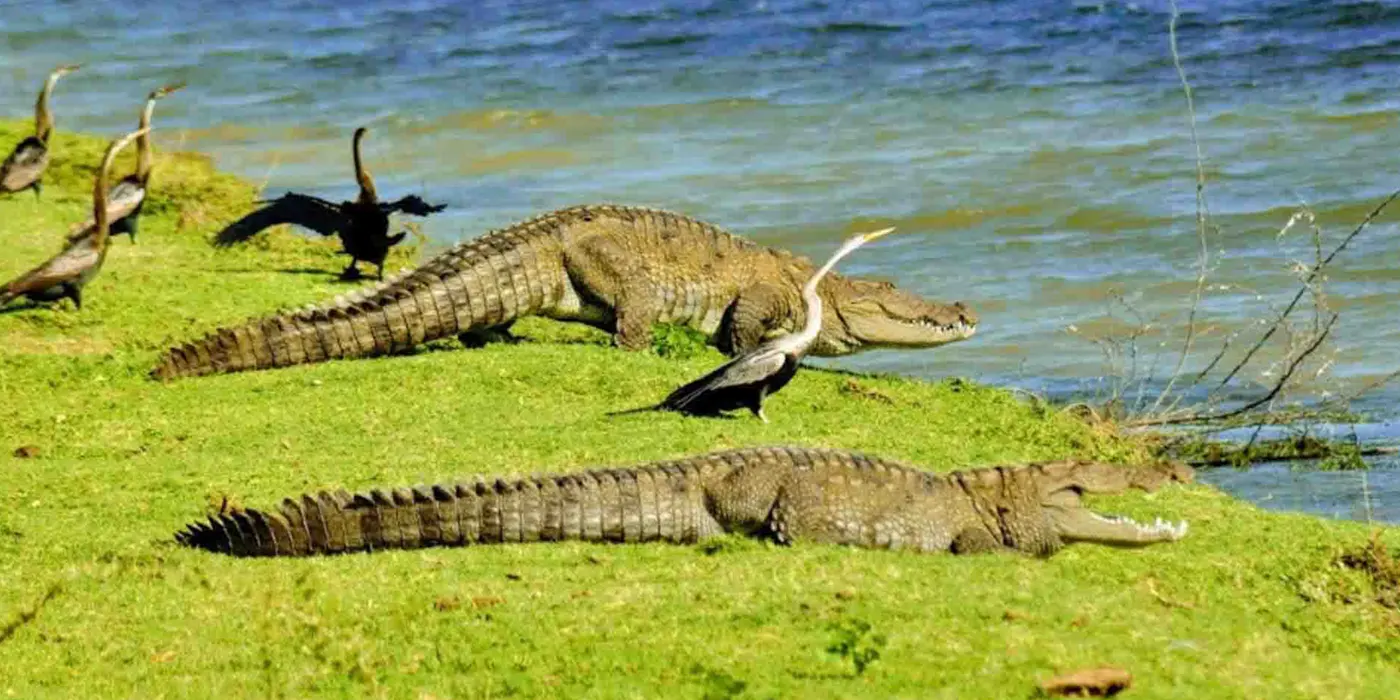
Crocodiles: Crocodiles are a common sight in the lakes and rivers of Wasgamuwa. They’re usually well-camouflaged, so you might not see them at first, but if you keep your eyes peeled, you’re sure to spot one.
Monkeys: Wasgamuwa is also home to a variety of monkeys, including langurs, macaques, and toque macaques. You might see them swinging through the trees, foraging for food, or playing with each other.
Birds: Wasgamuwa is also home to a wide variety of birds, including peacocks, eagles, and storks. You might even see some rare birds, such as the Sri Lanka junglefowl.
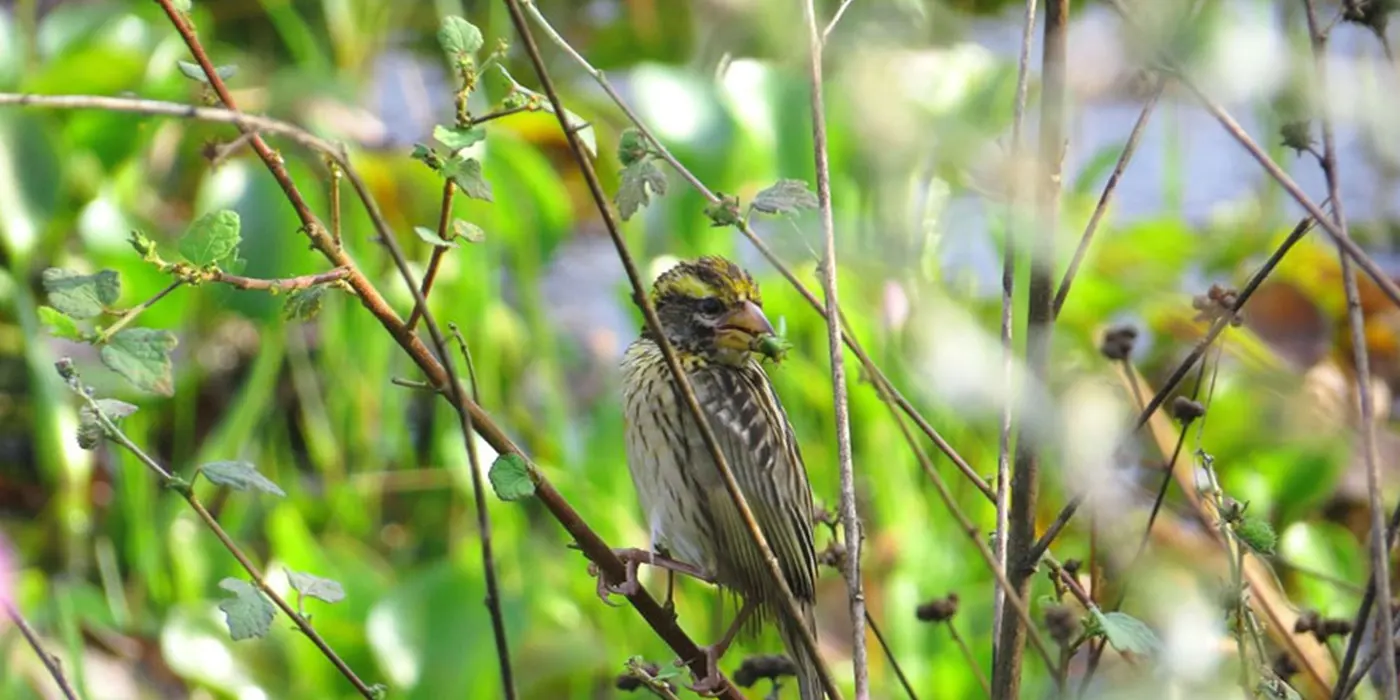
When to go on a Wasgamuwa National Park safari
The best time to go on a Wasgamuwa National Park safari is during the dry season, which runs from December to April. During this time, the animals are more active and easier to see. However, Wasgamuwa is a beautiful park year-round, so you can go on a safari at any time of year.
How to book a Wasgamuwa National Park safari
There are a few different ways to book a Wasgamuwa National Park safari. You can book through a tour operator, such as Lanka Tour Experts, or you can book directly with a safari company.
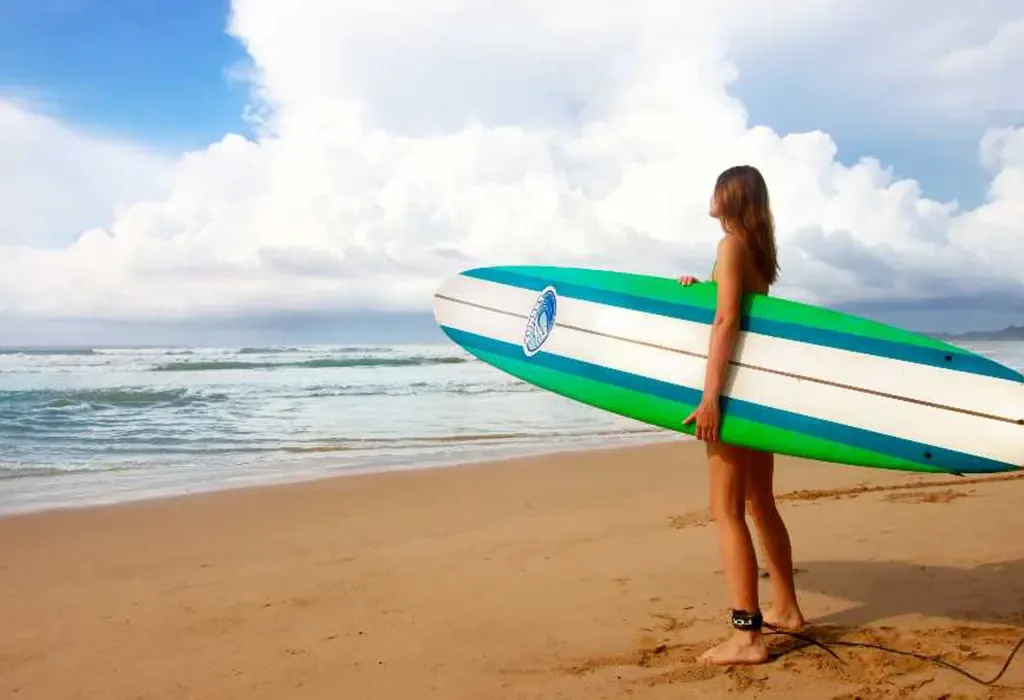
Sri Lanka Tour Packages
Our Sri Lanka tour packages offer the perfect way to explore this beautiful island. We have a variety of packages to choose from, so you can find one that fits your interests and budget. We can also create a custom itinerary for you.
Maduru Oya National Park Safari
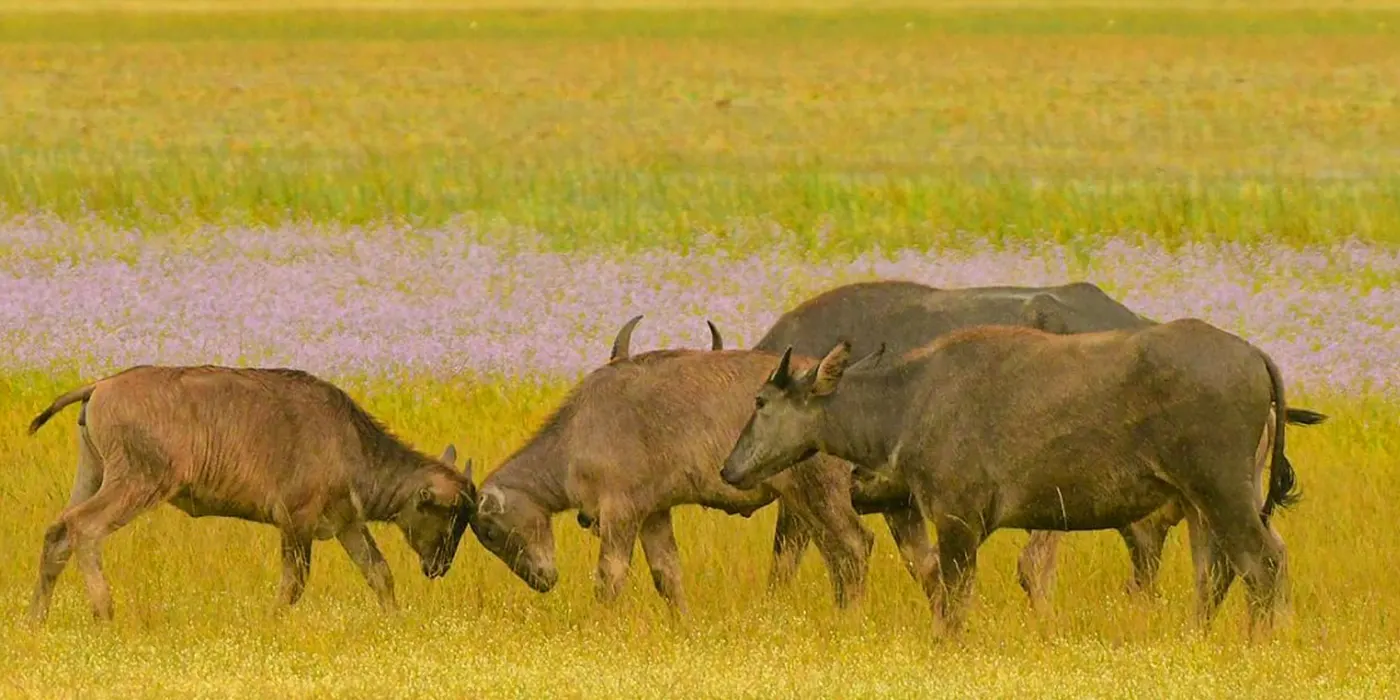
Maduru Oya National Park is one of Sri Lanka’s most popular wildlife destinations, and for good reason. The park is home to an incredible variety of animals, including elephants, water buffalo, crocodiles, monkeys, and many more. A safari in Maduru Oya is a truly unforgettable experience, and it’s the perfect way to see Sri Lanka’s wild side.
What to expect on a Maduru Oya National Park safari
A Maduru Oya National Park safari is a truly unique experience. You’ll have the chance to see some of the rarest and most elusive animals in the world, up close and in their natural habitat. Some of the animals you might see on a safari include:
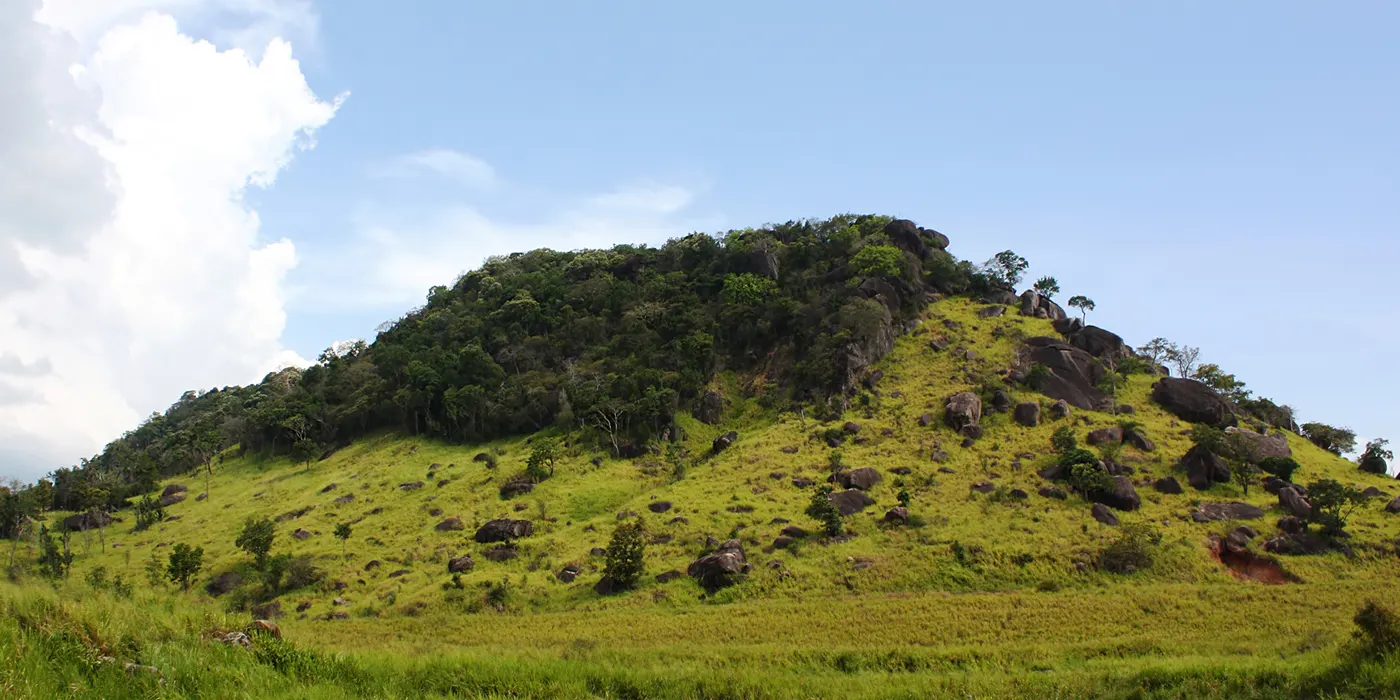
Elephants: Maduru Oya is home to a large population of elephants, making it one of the best places in Sri Lanka to see these majestic creatures. You might see them grazing in the grasslands, bathing in the lakes, or even playing with each other.
Water buffalo: Water buffalo are another common sight in Maduru Oya. These large, powerful animals are often seen grazing in the grasslands or cooling off in the lakes.
Crocodiles: Crocodiles are a common sight in the lakes and rivers of Maduru Oya. They’re usually well-camouflaged, so you might not see them at first, but if you keep your eyes peeled, you’re sure to spot one.
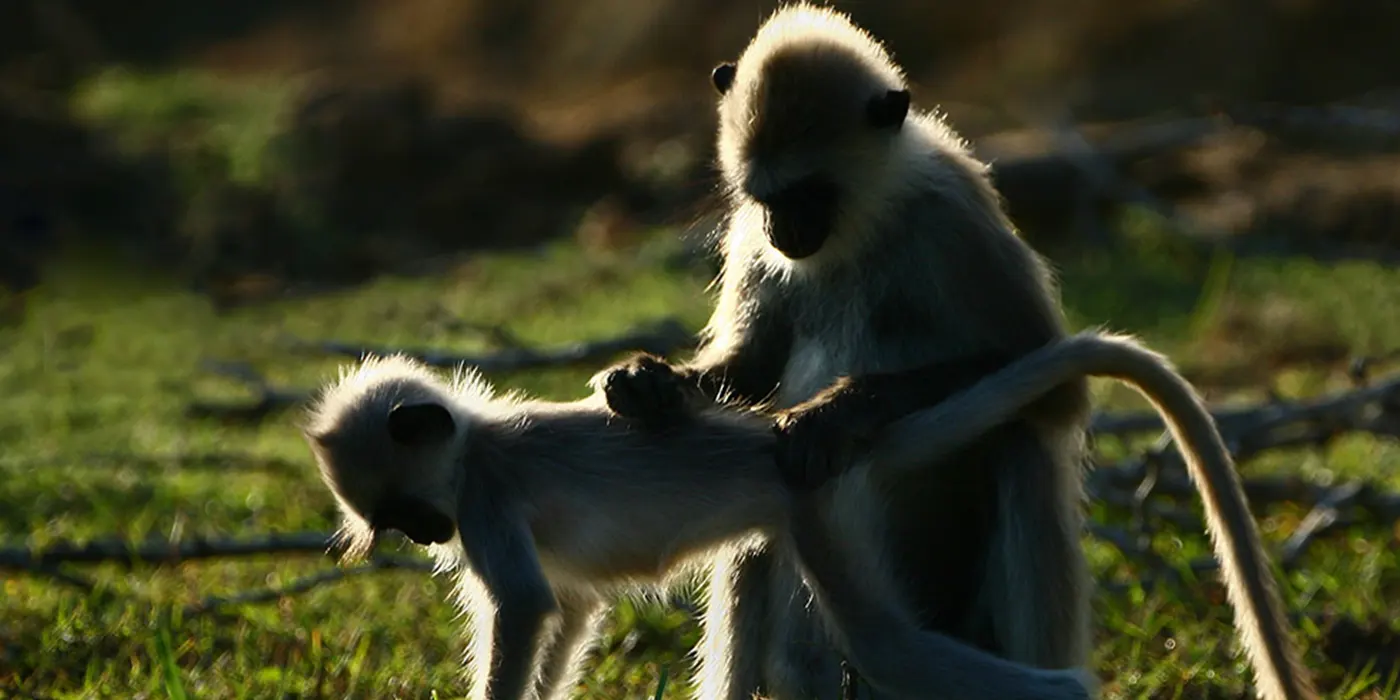
Monkeys: Maduru Oya is also home to a variety of monkeys, including langurs, macaques, and toque macaques. You might see them swinging through the trees, foraging for food, or playing with each other.
Birds: Maduru Oya is also home to a wide variety of birds, including peacocks, eagles, and storks. You might even see some rare birds, such as the Sri Lanka junglefowl.
When to go on a Maduru Oya National Park safari
The best time to go on a Maduru Oya National Park safari is during the dry season, which runs from December to April. During this time, the animals are more active and easier to see. However, Maduru Oya is a beautiful park year-round, so you can go on a safari at any time of year.
How to book a Maduru Oya National Park safari
There are a few different ways to book a Maduru Oya National Park safari. You can book through a tour operator, such as Lanka Tour Experts, or you can book directly with a safari company.
Gal Oya National Park Safari
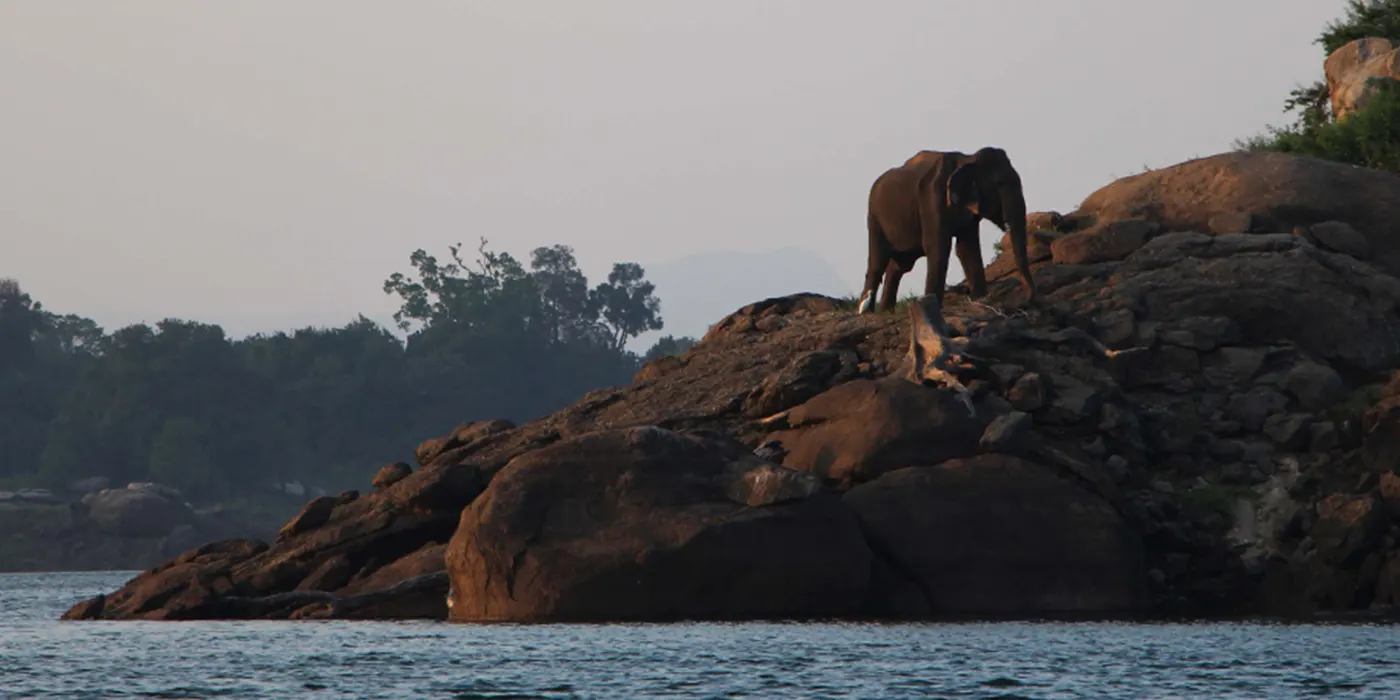
Gal Oya National Park is one of Sri Lanka’s most biodiverse national parks, and it is home to an incredible variety of animals. The park is also home to a number of ancient ruins, making it a popular destination for both wildlife enthusiasts and history buffs. A safari in Gal Oya is a truly unique experience, and it is the perfect way to see Sri Lanka’s wild side.
What to expect on a Gal Oya National Park safari
A Gal Oya National Park safari is a truly unique experience. You’ll have the chance to see some of the rarest and most elusive animals in the world, up close and in their natural habitat. Some of the animals you might see on a safari include:
Elephants: Gal Oya is home to a large population of elephants, making it one of the best places in Sri Lanka to see these majestic creatures. You might see them grazing in the grasslands, bathing in the lakes, or even playing with each other.
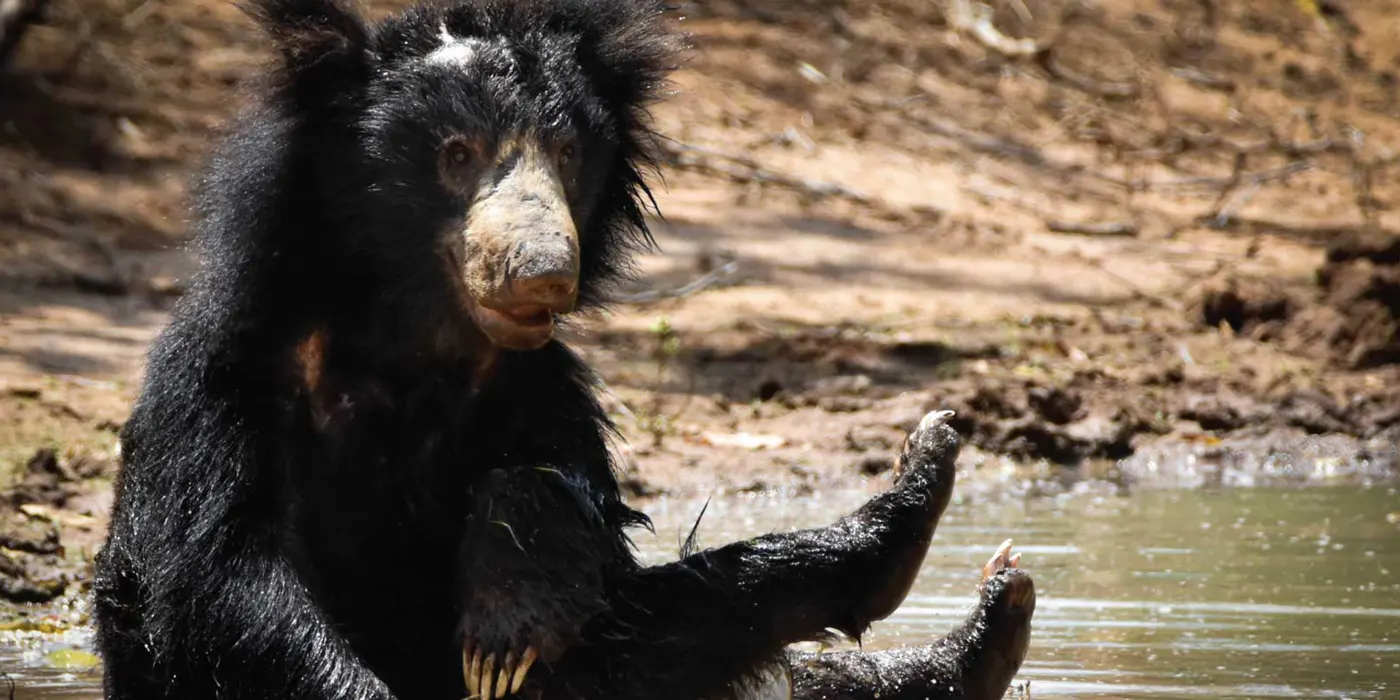
Sloth bears: Sloth bears are one of the most charismatic animals in Gal Oya. They’re slow-moving and lumbering, but they’re also incredibly powerful. You might see them foraging for food in the grasslands or sleeping in the trees.
Crocodiles: Crocodiles are a common sight in the lakes and rivers of Gal Oya. They’re usually well-camouflaged, so you might not see them at first, but if you keep your eyes peeled, you’re sure to spot one.
Birds: Gal Oya is also home to a wide variety of birds, including peacocks, eagles, and storks. You might even see some rare birds, such as the Sri Lanka junglefowl.
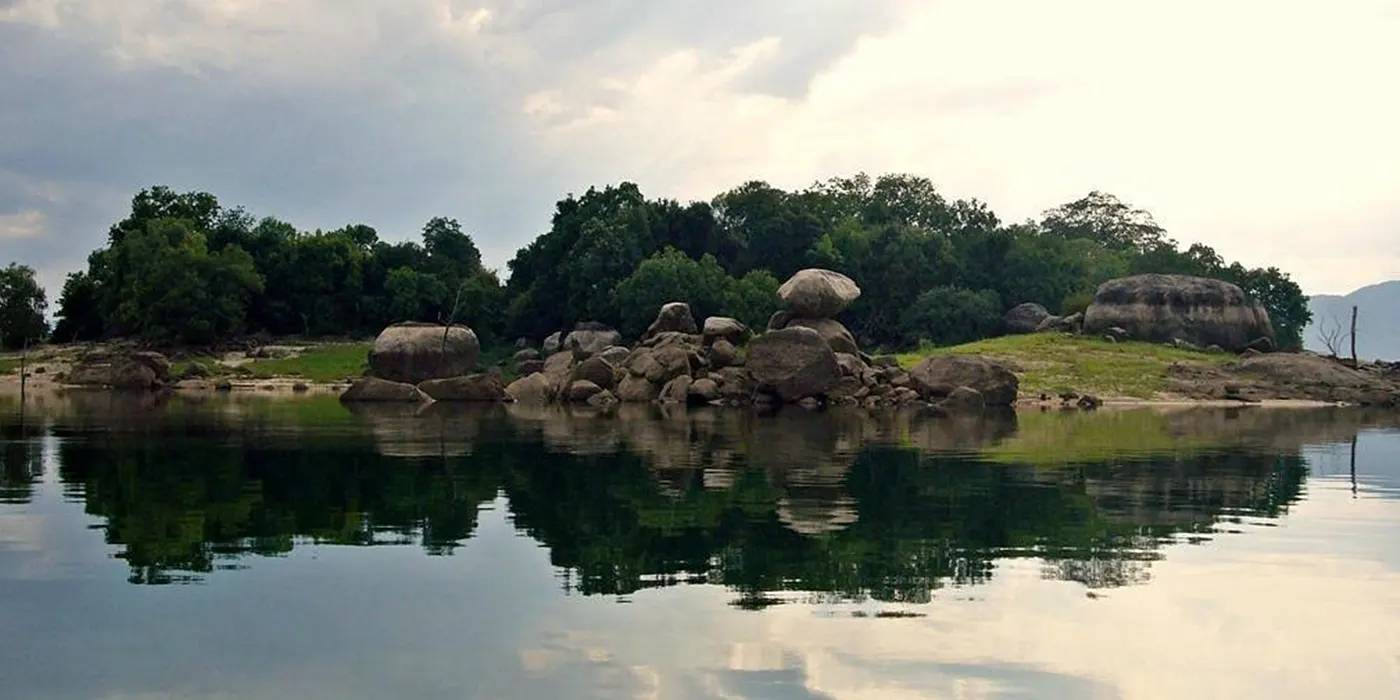
Ruins: Gal Oya is also home to a number of ancient ruins, including the ruins of a Buddhist monastery and a Hindu temple. These ruins are a reminder of the rich history of the area.
When to go on a Gal Oya National Park safari
The best time to go on a Gal Oya National Park safari is during the dry season, which runs from December to April. During this time, the animals are more active and easier to see. However, Gal Oya is a beautiful park year-round, so you can go on a safari at any time of year.
How to book a Gal Oya National Park safari
There are a few different ways to book a Gal Oya National Park safari. You can book through a tour operator, such as Lanka Tour Experts, or you can book directly with a safari company.
Bundala National Park Safari
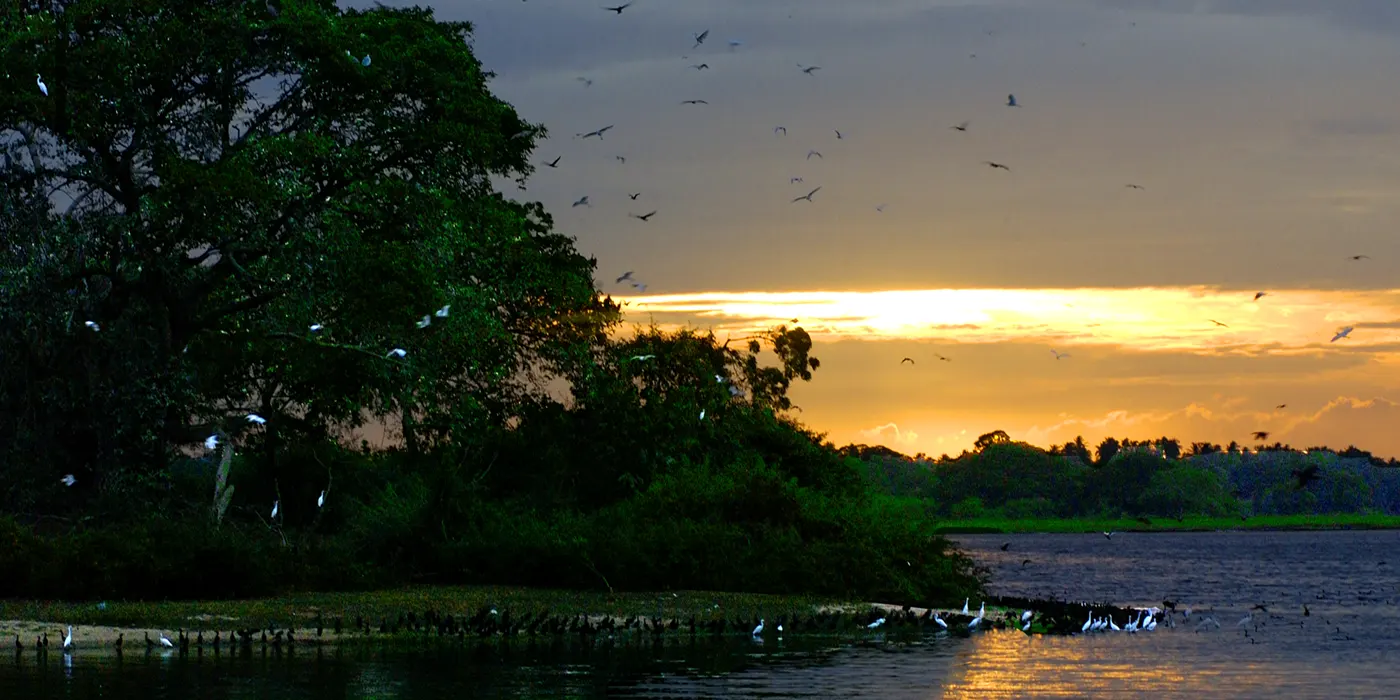
Bundala National Park is one of Sri Lanka’s most important birding destinations, and it is home to over 200 species of birds. The park is also home to a variety of other animals, including elephants, water buffalo, and crocodiles. A safari in Bundala is a truly unforgettable experience, and it is the perfect way to see Sri Lanka’s wild side.
What to expect on a Bundala National Park safari
A Bundala National Park safari is a truly unique experience. You’ll have the chance to see some of the rarest and most elusive birds in the world, up close and in their natural habitat. Some of the birds you might see on a safari include:

Greater flamingos: Bundala is one of the best places in the world to see greater flamingos. These beautiful birds gather in large flocks in the park’s wetlands.
Waterfowl: Bundala is also home to a variety of waterfowl, including pelicans, ducks, and geese. You might see them flying overhead or swimming in the park’s lakes and rivers.
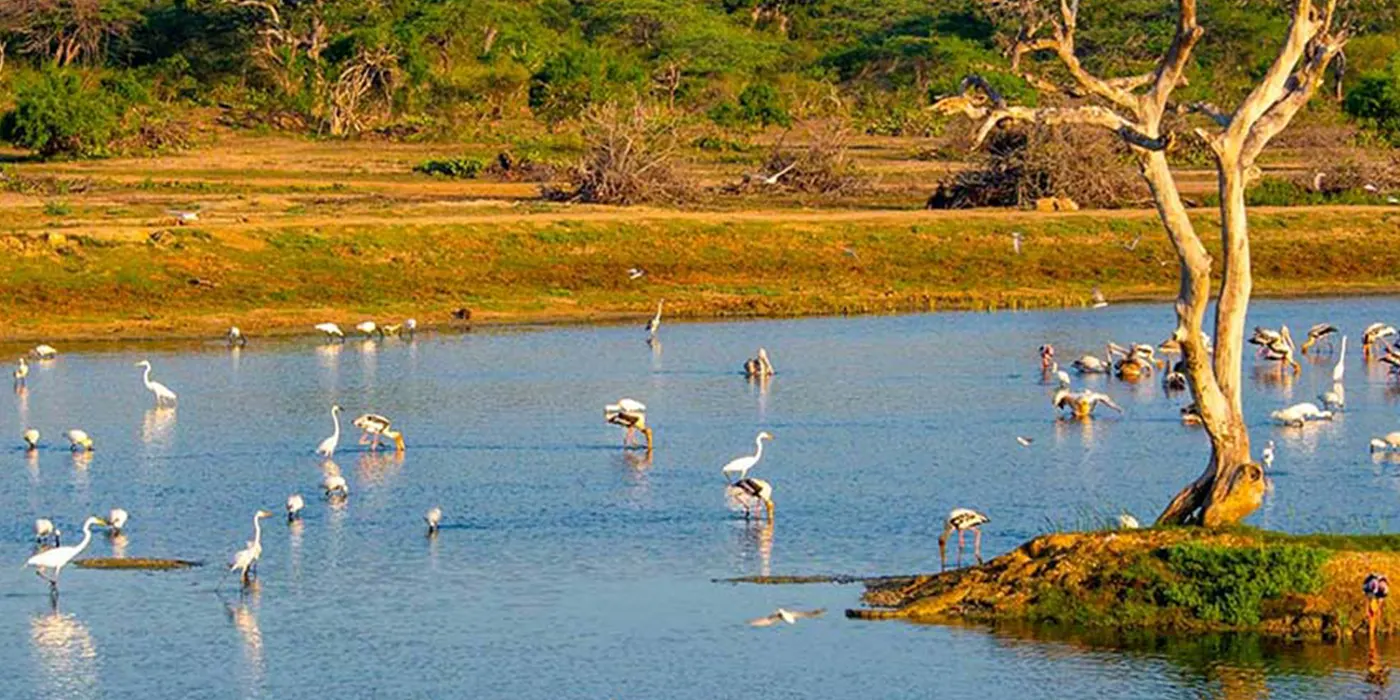
Other birds: Bundala is also home to a variety of other birds, including eagles, owls, and kingfishers. You might even see some rare birds, such as the Sri Lanka junglefowl.
Elephants: Bundala is also home to a small population of elephants. You might see them grazing in the grasslands or bathing in the lakes.
Water buffalo: Water buffalo are another common sight in Bundala. These large, powerful animals are often seen grazing in the grasslands or cooling off in the lakes.
Crocodiles: Crocodiles are a common sight in the lakes and rivers of Bundala. They’re usually well-camouflaged, so you might not see them at first, but if you keep your eyes peeled, you’re sure to spot one.
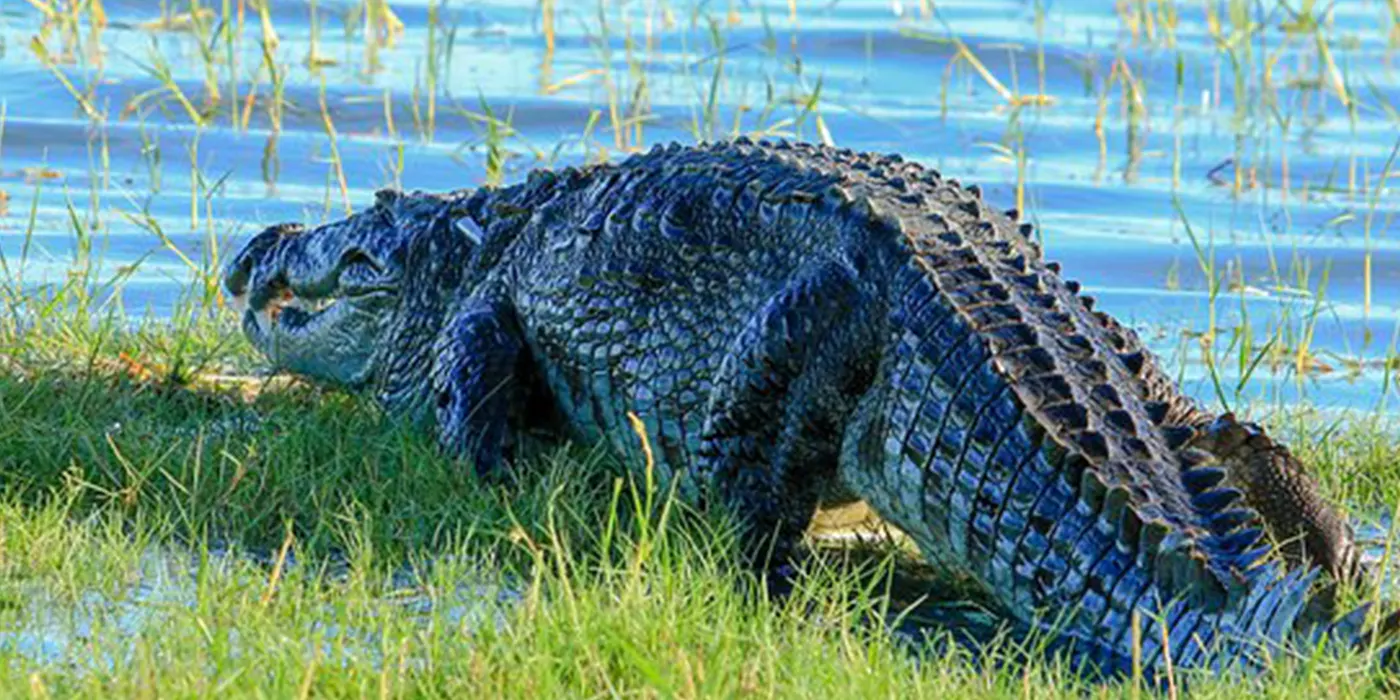
When to go on a Bundala National Park safari
The best time to go on a Bundala National Park safari is during the dry season, which runs from December to April. During this time, the animals are more active and easier to see. However, Bundala is a beautiful park year-round, so you can go on a safari at any time of year.
How to book a Bundala National Park safari
There are a few different ways to book a Bundala National Park safari. You can book through a tour operator, such as Lanka Tour Experts, or you can book directly with a safari company.
Minneriya National Park Safari
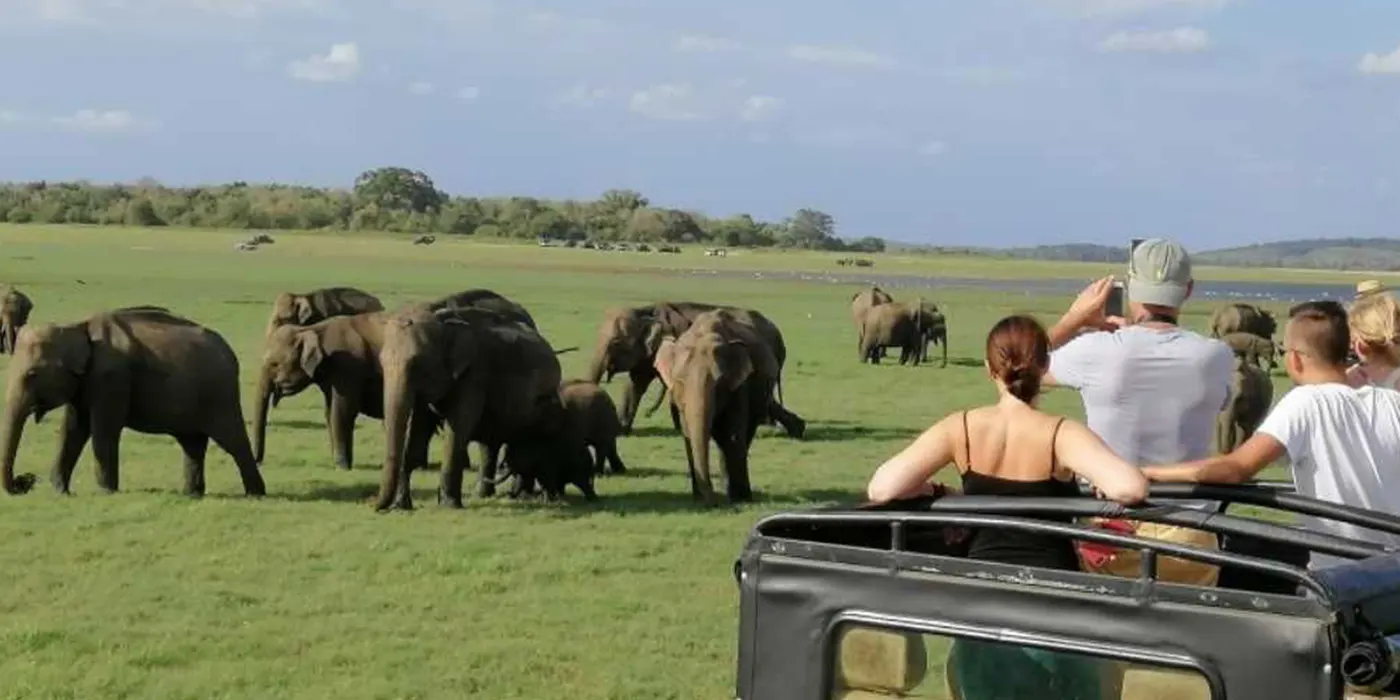
Minneriya National Park is one of Sri Lanka’s most popular wildlife destinations, and for good reason. The park is home to an incredible number of elephants, making it one of the best places in the world to see these majestic creatures. A safari in Minneriya is a truly unforgettable experience, and it’s the perfect way to see Sri Lanka’s wild side.
What to expect on a Minneriya National Park safari
A Minneriya National Park safari is a truly unique experience. You’ll have the chance to see some of the rarest and most elusive animals in the world, up close and in their natural habitat. Some of the animals you might see on a safari include:
Elephants: Minneriya is home to a large population of elephants, making it one of the best places in Sri Lanka to see these majestic creatures. You might see them grazing in the grasslands, bathing in the lakes, or even playing with each other.
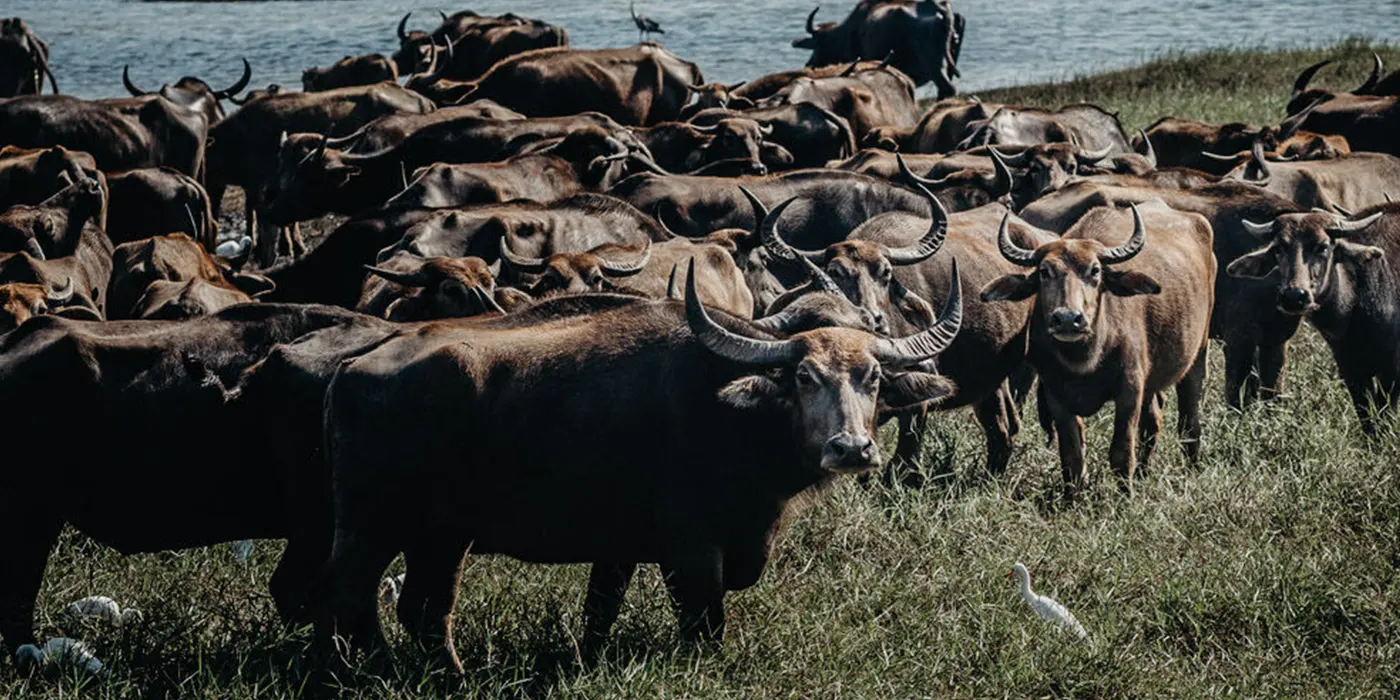
Water buffalo: Water buffalo are another common sight in Minneriya. These large, powerful animals are often seen grazing in the grasslands or cooling off in the lakes.
Crocodiles: Crocodiles are a common sight in the lakes and rivers of Minneriya. They’re usually well-camouflaged, so you might not see them at first, but if you keep your eyes peeled, you’re sure to spot one.
Birds: Minneriya is also home to a wide variety of birds, including eagles, owls, and kingfishers. You might even see some rare birds, such as the Sri Lanka junglefowl.
The Gathering: One of the most popular attractions in Minneriya National Park is the “Gathering,” which is a seasonal event when hundreds of elephants gather at the Minneriya Tank to drink and bathe. This is a truly amazing sight to see, and it’s one of the reasons why Minneriya is such a popular safari destination.
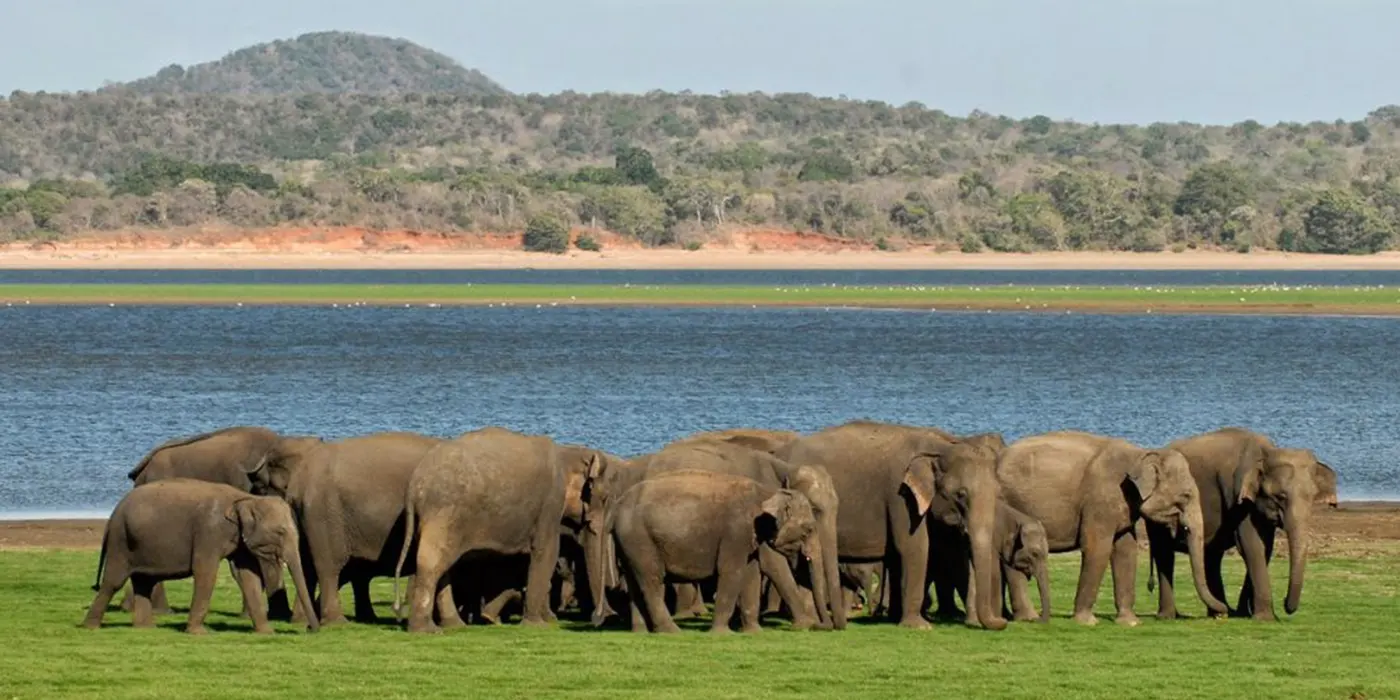
When to go on a Minneriya National Park safari
The best time to go on a Minneriya National Park safari is during the dry season, which runs from December to April. During this time, the animals are more active and easier to see. However, Minneriya is a beautiful park year-round, so you can go on a safari at any time of year.
How to book a Minneriya National Park safari
There are a few different ways to book a Minneriya National Park safari. You can book through a tour operator, such as Lanka Tour Experts, or you can book directly with a safari company.
Hurulu Eco Park Safari
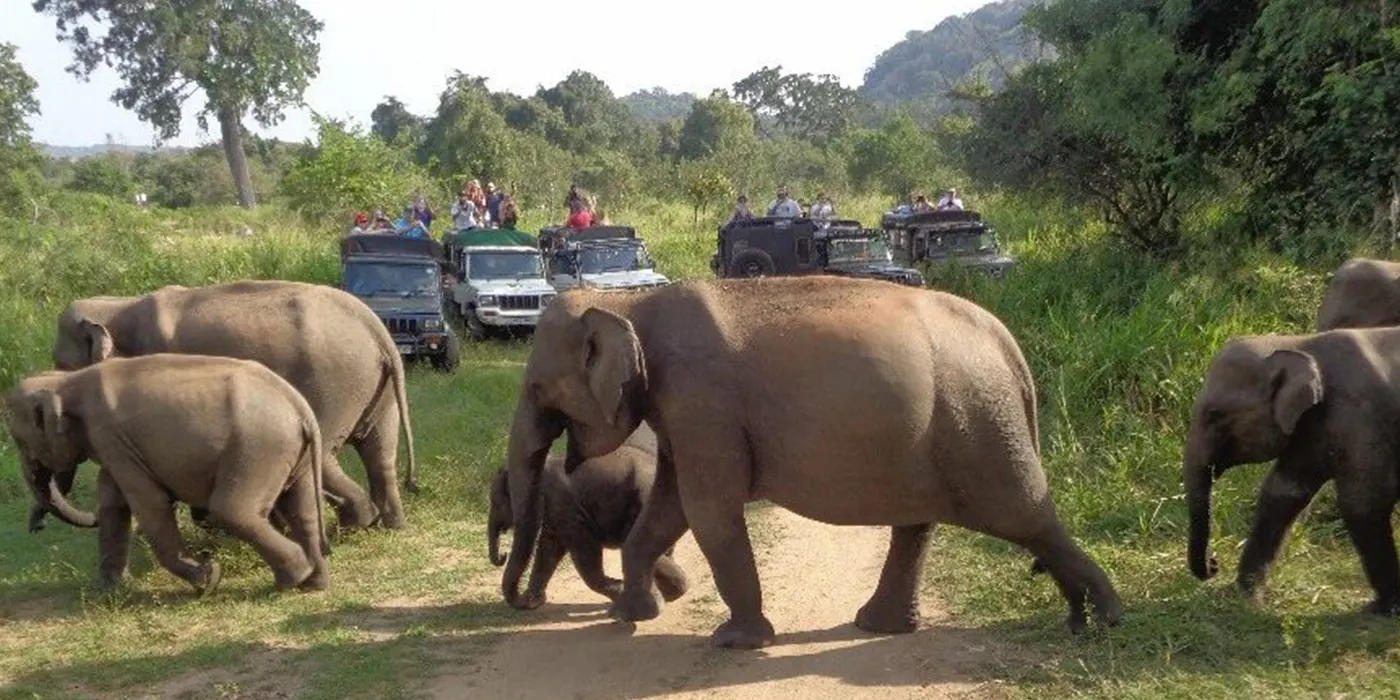
Hurulu Eco Park is a beautiful wildlife sanctuary located in Sri Lanka. The park is home to a variety of animals, including elephants, water buffalo, monkeys, and birds. A safari in Hurulu Eco Park is a truly unique experience, and it is the perfect way to see Sri Lanka’s wild side.
What to expect on a Hurulu Eco Park safari
A Hurulu Eco Park safari is a truly unique experience. You’ll have the chance to see some of the rarest and most elusive animals in the world, up close and in their natural habitat. Some of the animals you might see on a safari include:
Elephants: Hurulu Eco Park is home to a large population of elephants, making it one of the best places in Sri Lanka to see these majestic creatures. You might see them grazing in the grasslands, bathing in the lakes, or even playing with each other.
Water buffalo: Water buffalo are another common sight in Hurulu Eco Park. These large, powerful animals are often seen grazing in the grasslands or cooling off in the lakes.
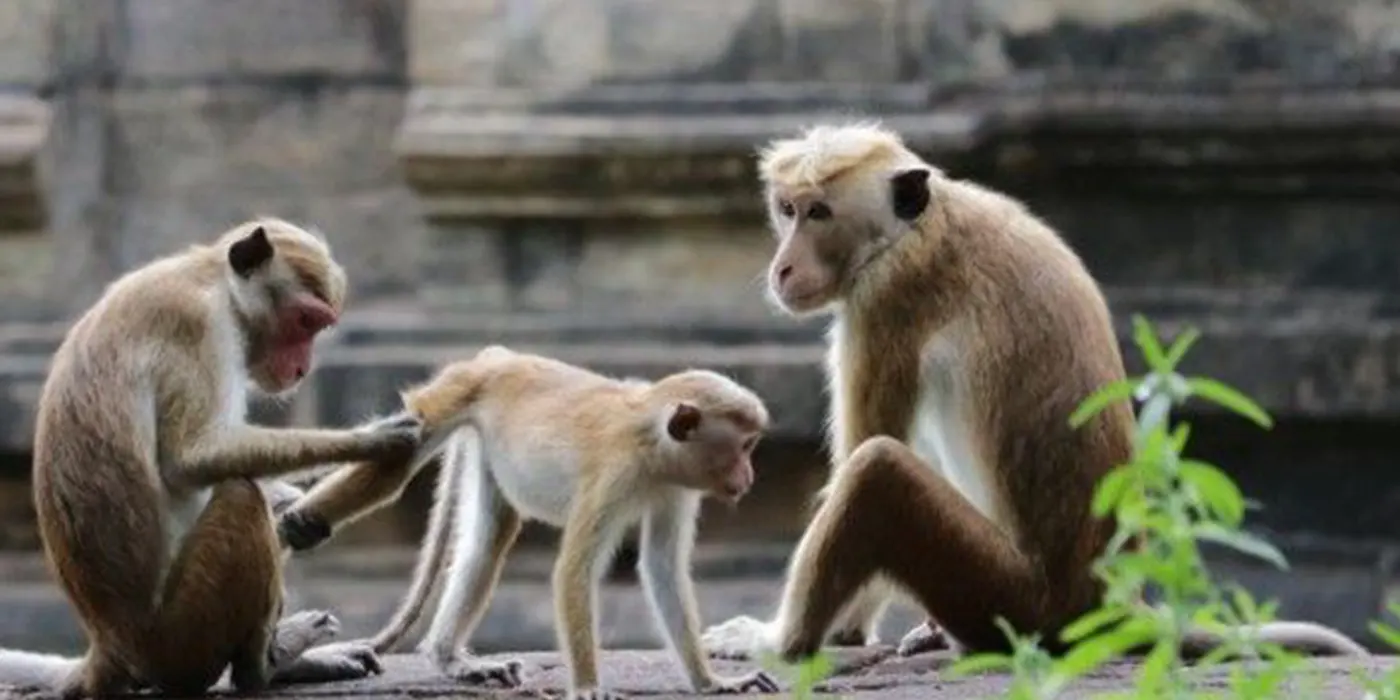
Monkeys: Hurulu Eco Park is also home to a variety of monkeys, including langurs, macaques, and toque macaques. You might see them swinging through the trees, foraging for food, or playing with each other.
Birds: Hurulu Eco Park is also home to a wide variety of birds, including peacocks, eagles, and storks. You might even see some rare birds, such as the Sri Lanka junglefowl.
When to go on a Hurulu Eco Park safari
The best time to go on a Hurulu Eco Park safari is during the dry season, which runs from December to April. During this time, the animals are more active and easier to see. However, Hurulu Eco Park is a beautiful park year-round, so you can go on a safari at any time of year.
How to book a Hurulu Eco Park safari
There are a few different ways to book a Hurulu Eco Park safari. You can book through a tour operator, such as Lanka Tour Experts, or you can book directly with a safari company.
Lahugala Kitulana National Park Safari
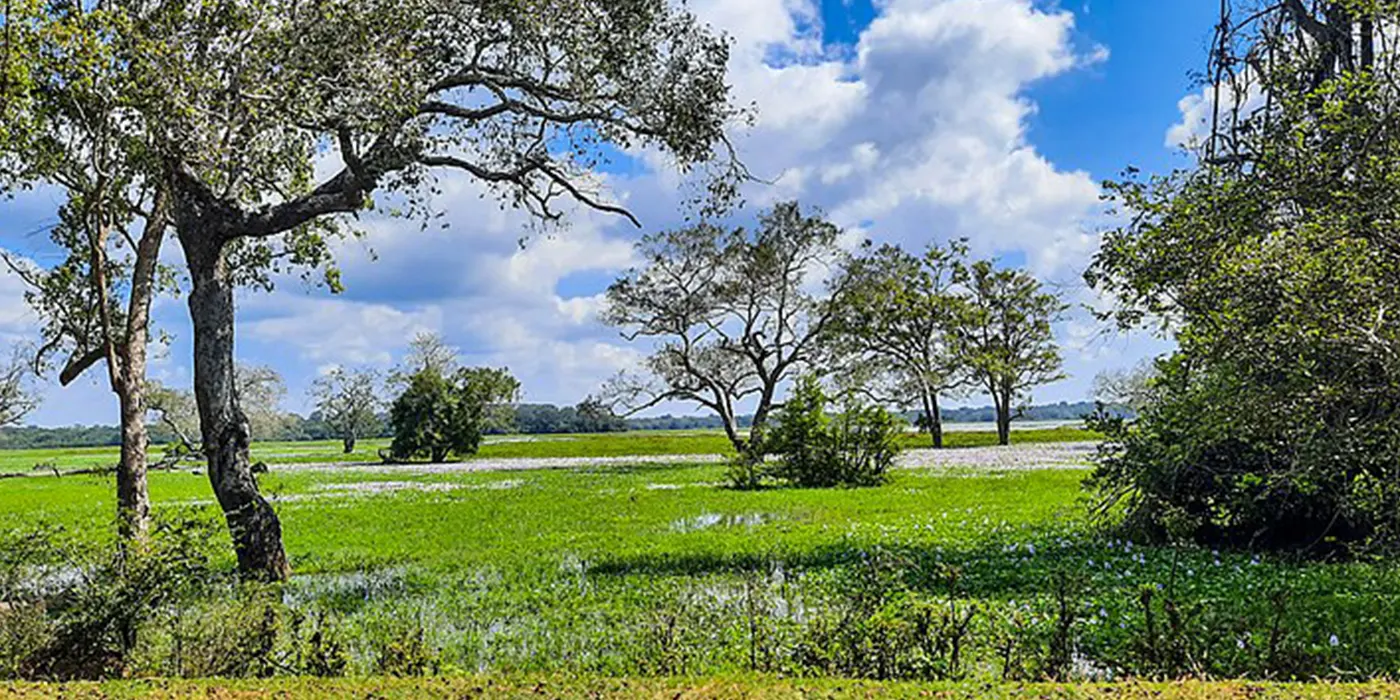
Lahugala Kitulana National Park is one of Sri Lanka’s smallest national parks, but it is also one of its most unique. The park is home to a variety of animals, including elephants, water buffalo, and crocodiles. However, what makes Lahugala Kitulana National Park truly special is its dry zone ecosystem.
What to expect on a Lahugala Kitulana National Park safari
A Lahugala Kitulana National Park safari is a truly unique experience. You’ll have the chance to see some of the rarest and most elusive animals in the world, up close and in their natural habitat. Some of the animals you might see on a safari include:
Elephants: Lahugala Kitulana National Park is home to a small population of elephants, making it one of the best places in Sri Lanka to see these majestic creatures. You might see them grazing in the grasslands, bathing in the lakes, or even playing with each other.
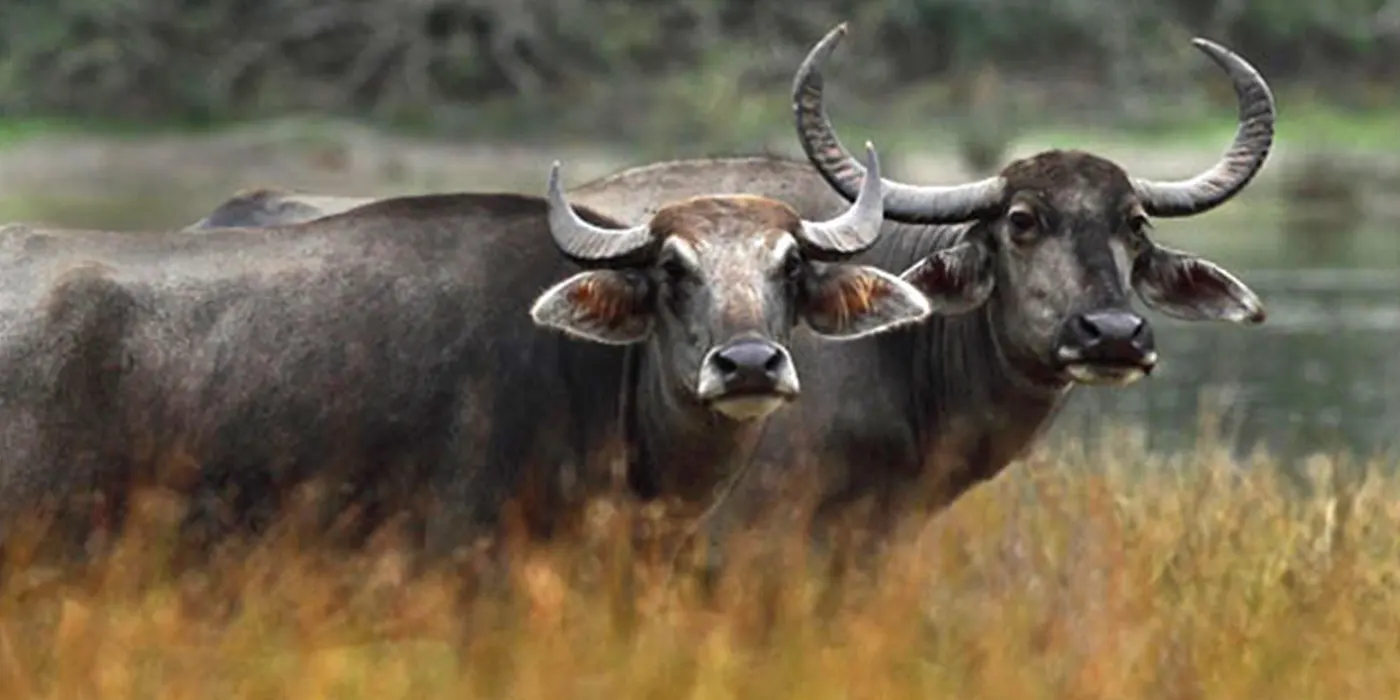
Water buffalo: Water buffalo are another common sight in Lahugala Kitulana National Park. These large, powerful animals are often seen grazing in the grasslands or cooling off in the lakes.
Crocodiles: Crocodiles are a common sight in the lakes and rivers of Lahugala Kitulana National Park. They’re usually well-camouflaged, so you might not see them at first, but if you keep your eyes peeled, you’re sure to spot one.
Birds: Lahugala Kitulana National Park is also home to a wide variety of birds, including peacocks, eagles, and storks. You might even see some rare birds, such as the Sri Lanka junglefowl.
Dry zone ecosystem: Lahugala Kitulana National Park is home to a unique dry zone ecosystem. This ecosystem is characterized by its dry grasslands, scrub forests, and lakes. The park is also home to a number of endemic plants and animals, including the Lahugala Kitulana tree.
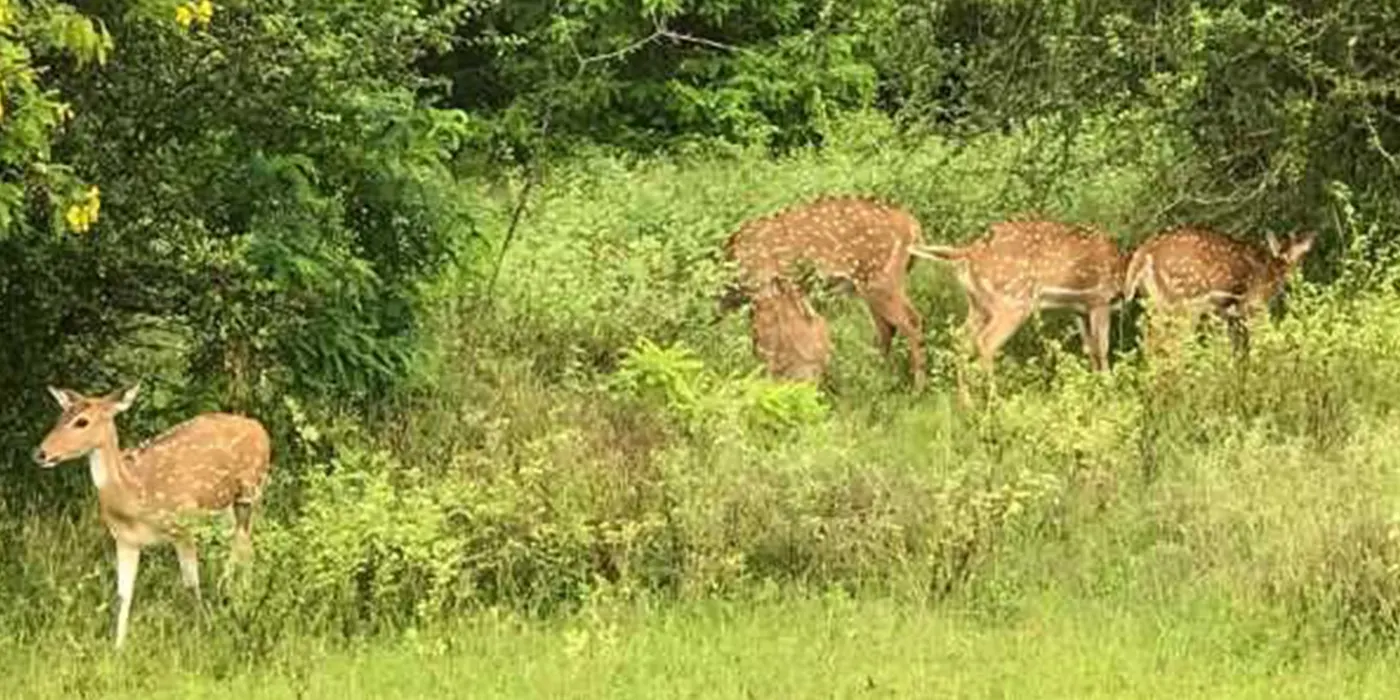
When to go on a Lahugala Kitulana National Park safari
The best time to go on a Lahugala Kitulana National Park safari is during the dry season, which runs from October to April. During this time, the animals are more active and easier to see. However, Lahugala Kitulana National Park is a beautiful park year-round, so you can go on a safari at any time of year.
How to book a Lahugala Kitulana National Park safari
There are a few different ways to book a Lahugala Kitulana National Park safari. You can book through a tour operator, such as Lanka Tour Experts, or you can book directly with a safari company.
Horton Plains National Park Safari
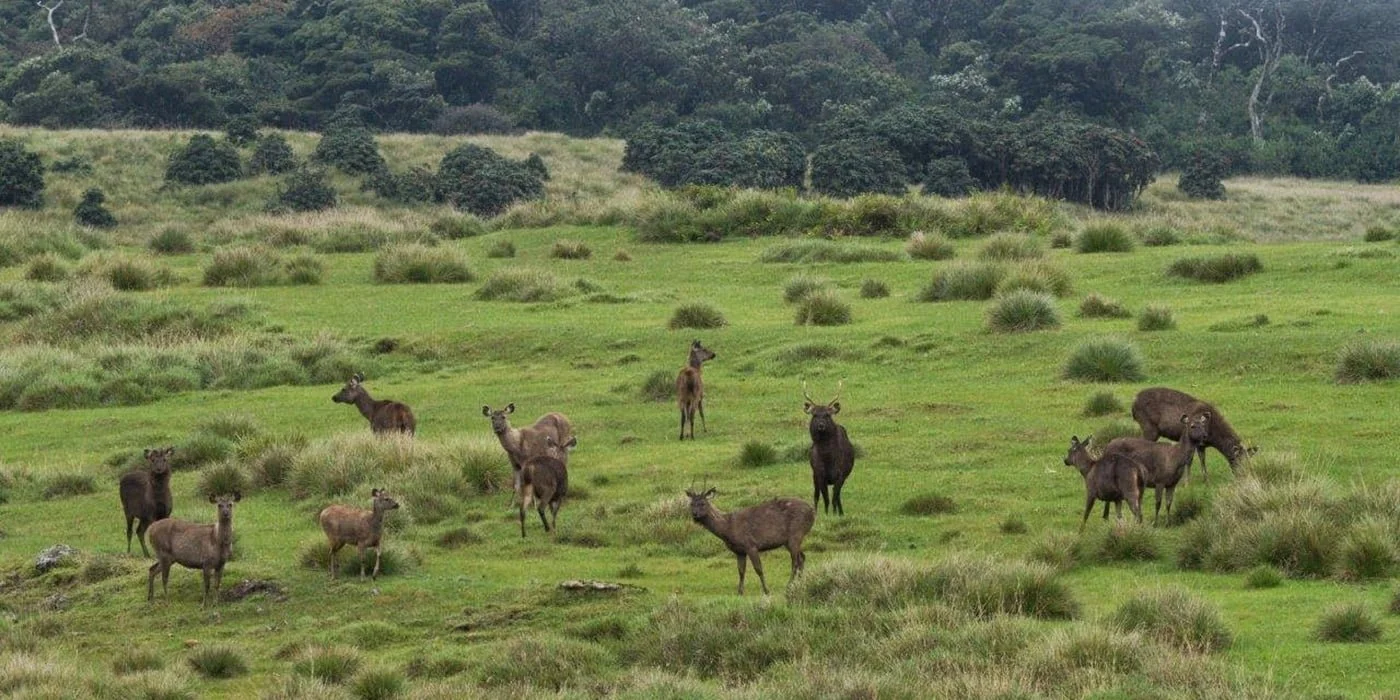
Horton Plains National Park is one of Sri Lanka’s most popular tourist destinations, and for good reason. The park is home to a variety of stunning scenery, including rolling hills, lush grasslands, and cascading waterfalls. It is also home to a number of wild animals, including elephants, leopards, and sloth bears.
What to expect on a Horton Plains National Park safari
A Horton Plains National Park safari is a truly unique experience. You’ll have the chance to see some of the rarest and most elusive animals in the world, up close and in their natural habitat. Some of the animals you might see on a safari include:
Leopards: Horton Plains is also home to a small population of leopards, making it one of the best places in Sri Lanka to see these elusive cats. Leopards are very difficult to spot, but if you’re lucky, you might catch a glimpse of one prowling through the forest.
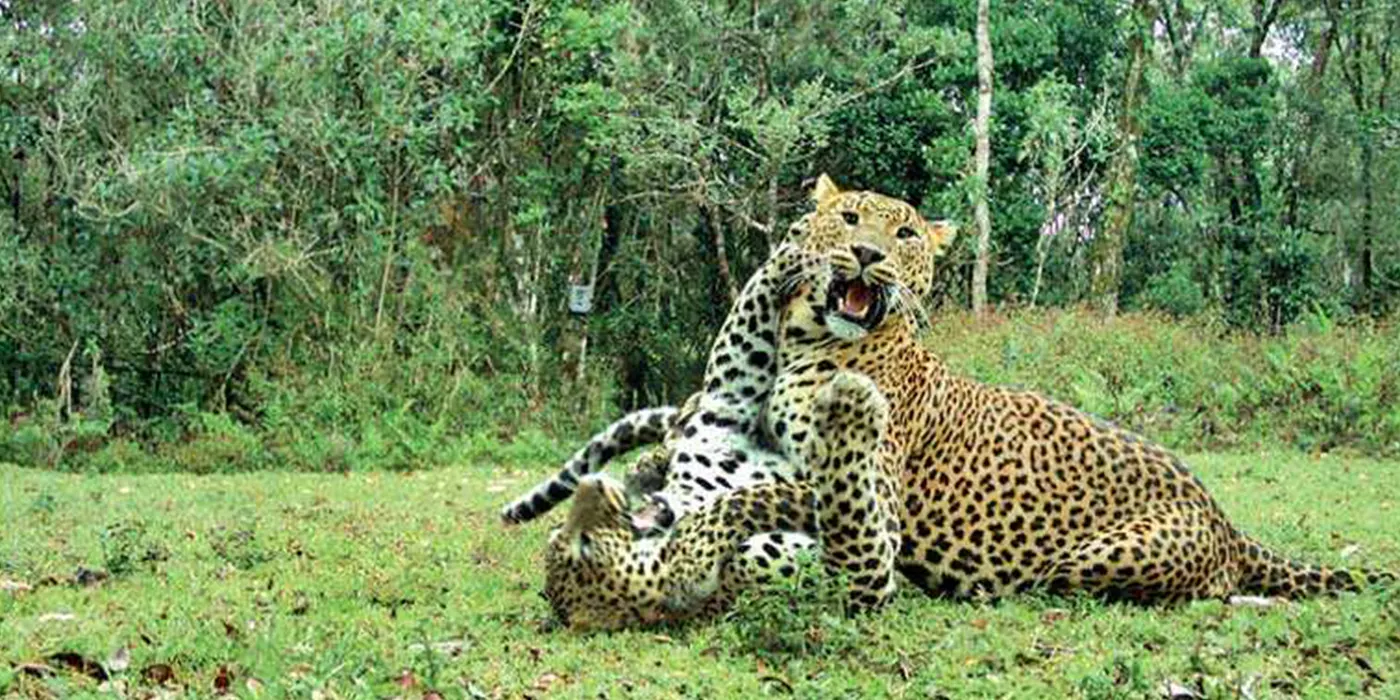
Sloth bears: Sloth bears are another rare animal that can be found in Horton Plains. Sloth bears are slow-moving and lumbering, but they are also incredibly powerful. You might see them foraging for food in the grasslands or sleeping in the trees.
Birds: Horton Plains is also home to a wide variety of birds, including peacocks, eagles, and storks. You might even see some rare birds, such as the Sri Lanka hill whistling-thrush.
World’s End: One of the most popular attractions in Horton Plains National Park is World’s End, a sheer cliff that drops over 1,000 meters (3,300 feet) to the valley below. The views from World’s End are simply stunning, and it is a truly unforgettable experience.
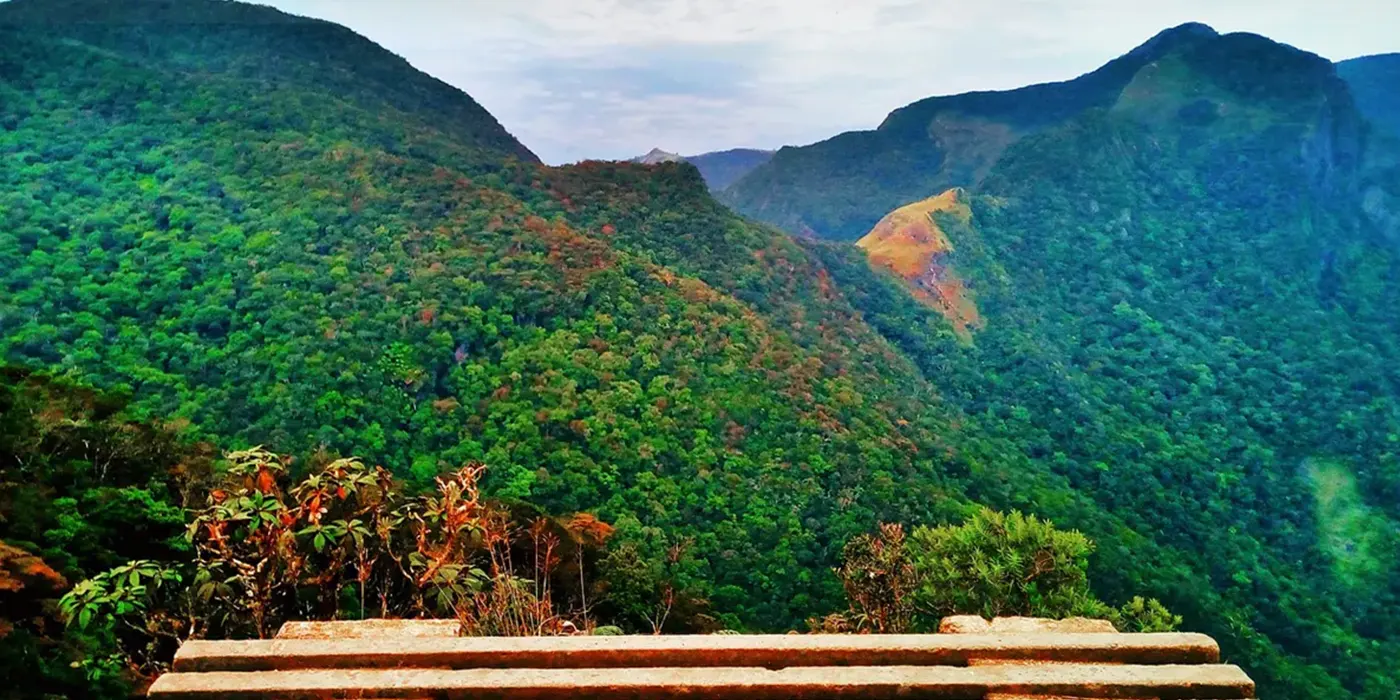
When to go on a Horton Plains National Park safari
The best time to go on a Horton Plains National Park safari is during the dry season, which runs from December to April. During this time, the animals are more active and easier to see. However, Horton Plains is a beautiful park year-round, so you can go on a safari at any time of year.
Read More About : Horton Plains National Park
How to book a Horton Plains National Park safari
There are a few different ways to book a Horton Plains National Park safari. You can book through a tour operator, such as Lanka Tour Experts, or you can book directly with a safari company.
Kala Wewa National Park Safari
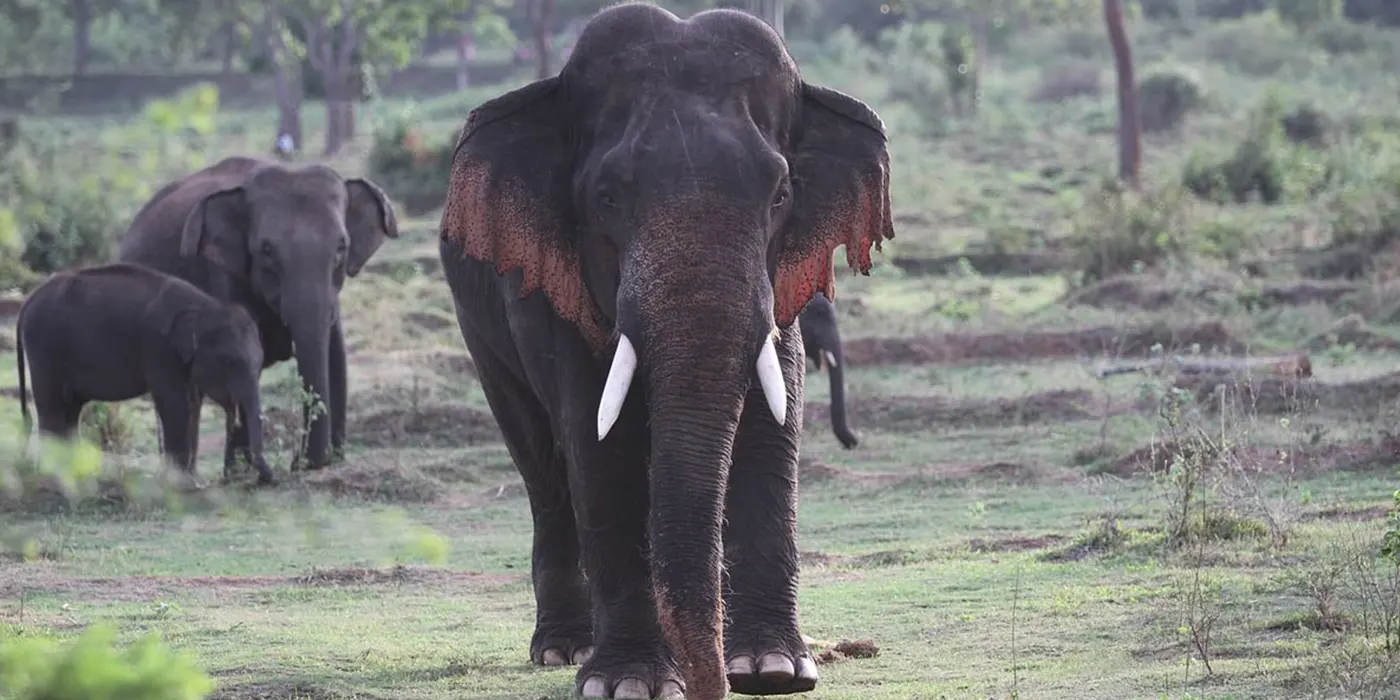
Kala Wewa National Park is a beautiful wildlife sanctuary located in Sri Lanka. The park is home to a variety of animals, including elephants, water buffalo, monkeys, and birds. A safari in Kala Wewa National Park is a truly unique experience, and it is the perfect way to see Sri Lanka’s wild side.
What to expect on a Kala Wewa National Park safari
A Kala Wewa National Park safari is a truly unique experience. You’ll have the chance to see some of the rarest and most elusive animals in the world, up close and in their natural habitat. Some of the animals you might see on a safari include:
Elephants: Kala Wewa is home to a large population of elephants, making it one of the best places in Sri Lanka to see these majestic creatures. You might see them grazing in the grasslands, bathing in the lakes, or even playing with each other.
Water buffalo: Water buffalo are another common sight in Kala Wewa National Park. These large, powerful animals are often seen grazing in the grasslands or cooling off in the lakes.
Monkeys: Kala Wewa National Park is also home to a variety of monkeys, including langurs, macaques, and toque macaques. You might see them swinging through the trees, foraging for food, or playing with each other.
Birds: Kala Wewa National Park is also home to a wide variety of birds, including peacocks, eagles, and storks. You might even see some rare birds, such as the Sri Lanka junglefowl.
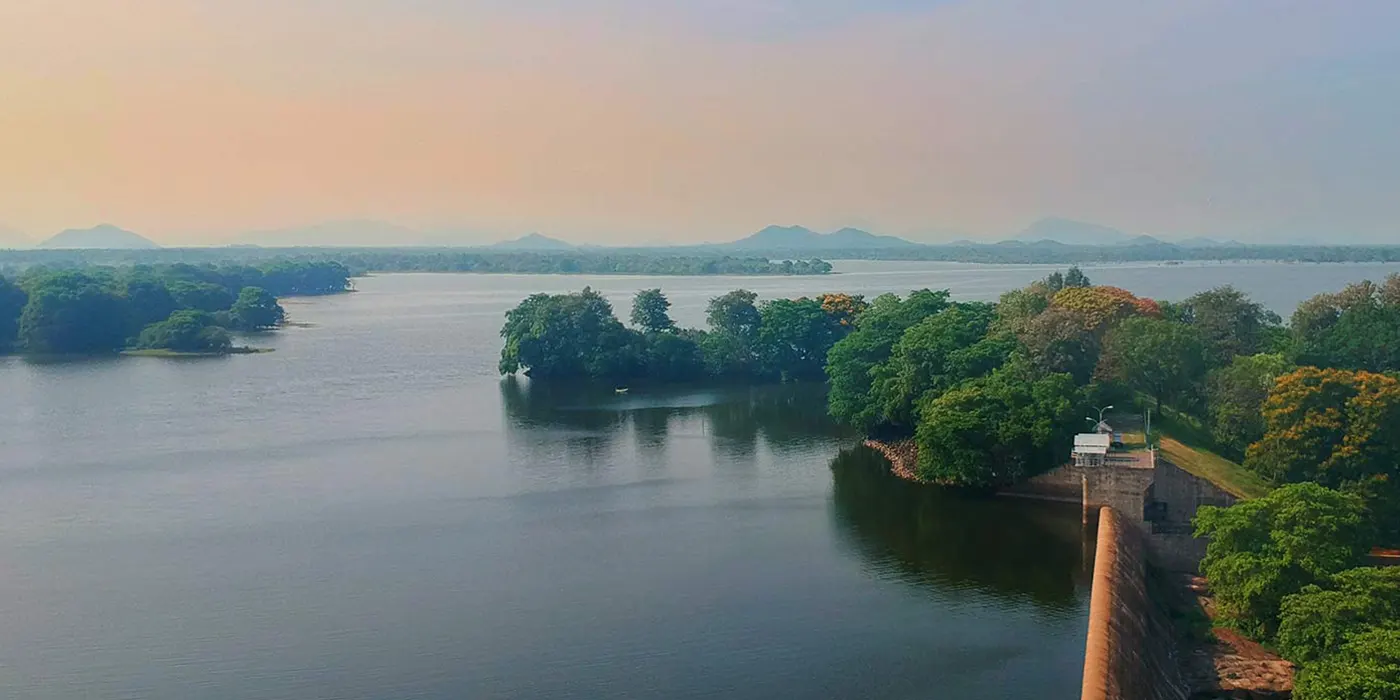
Kala Wewa: The park is also home to the Kala Wewa reservoir, which is one of the largest reservoirs in Sri Lanka. The reservoir is a popular spot for birdwatching, and you can often see a variety of waterfowl, including pelicans, ducks, and geese.
When to go on a Kala Wewa National Park safari
The best time to go on a Kala Wewa National Park safari is during the dry season, which runs from December to April. During this time, the animals are more active and easier to see. However, Kala Wewa is a beautiful park year-round, so you can go on a safari at any time of year.
How to book a Kala Wewa National Park safari
There are a few different ways to book a Kala Wewa National Park safari. You can book through a tour operator, such as Lanka Tour Experts, or you can book directly with a safari company.
Kaudulla National Park Safari
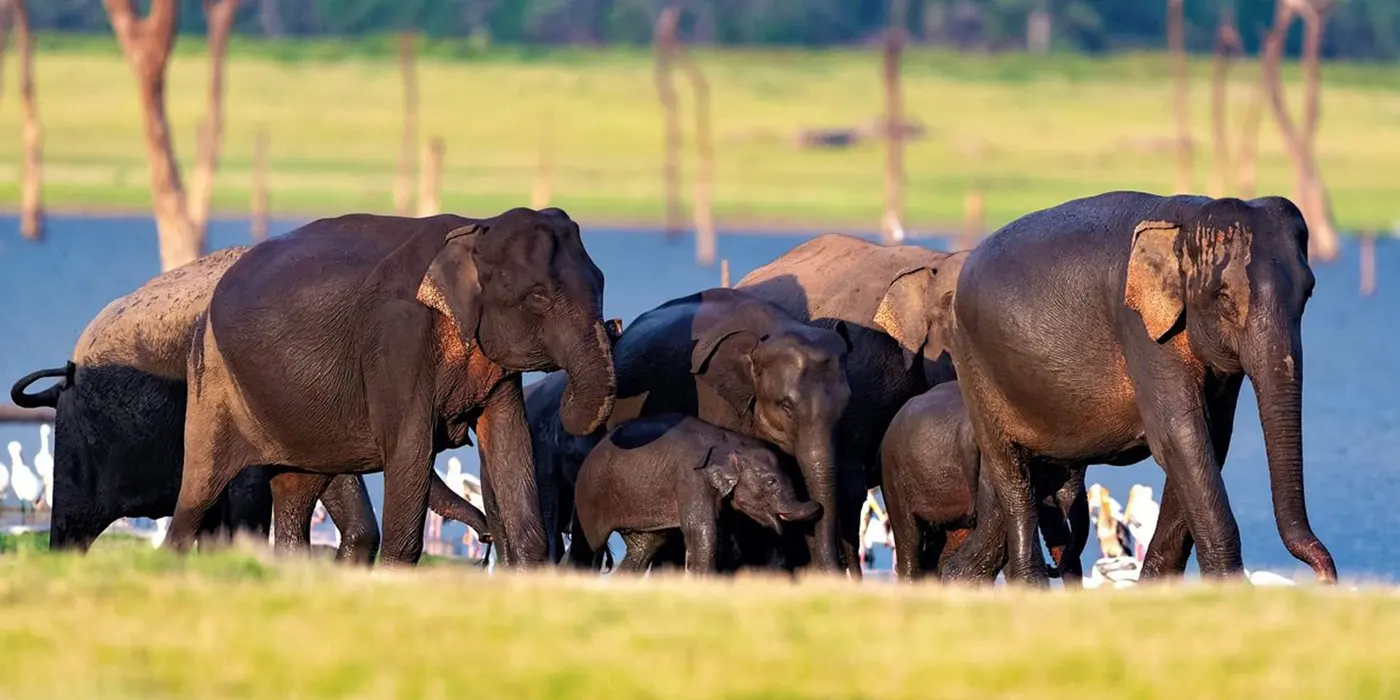
Kaudulla National Park is a beautiful wildlife sanctuary located in Sri Lanka. The park is home to a variety of animals, including elephants, water buffalo, monkeys, and birds. A safari in Kaudulla National Park is a truly unique experience, and it is the perfect way to see Sri Lanka’s wild side.
What to expect on a Kaudulla National Park safari
A Kaudulla National Park safari is a truly unique experience. You’ll have the chance to see some of the rarest and most elusive animals in the world, up close and in their natural habitat. Some of the animals you might see on a safari include:
Elephants: Kaudulla is home to a large population of elephants, making it one of the best places in Sri Lanka to see these majestic creatures. You might see them grazing in the grasslands, bathing in the lakes, or even playing with each other.
Water buffalo: Water buffalo are another common sight in Kaudulla National Park. These large, powerful animals are often seen grazing in the grasslands or cooling off in the lakes.
Monkeys: Kaudulla National Park is also home to a variety of monkeys, including langurs, macaques, and toque macaques. You might see them swinging through the trees, foraging for food, or playing with each other.
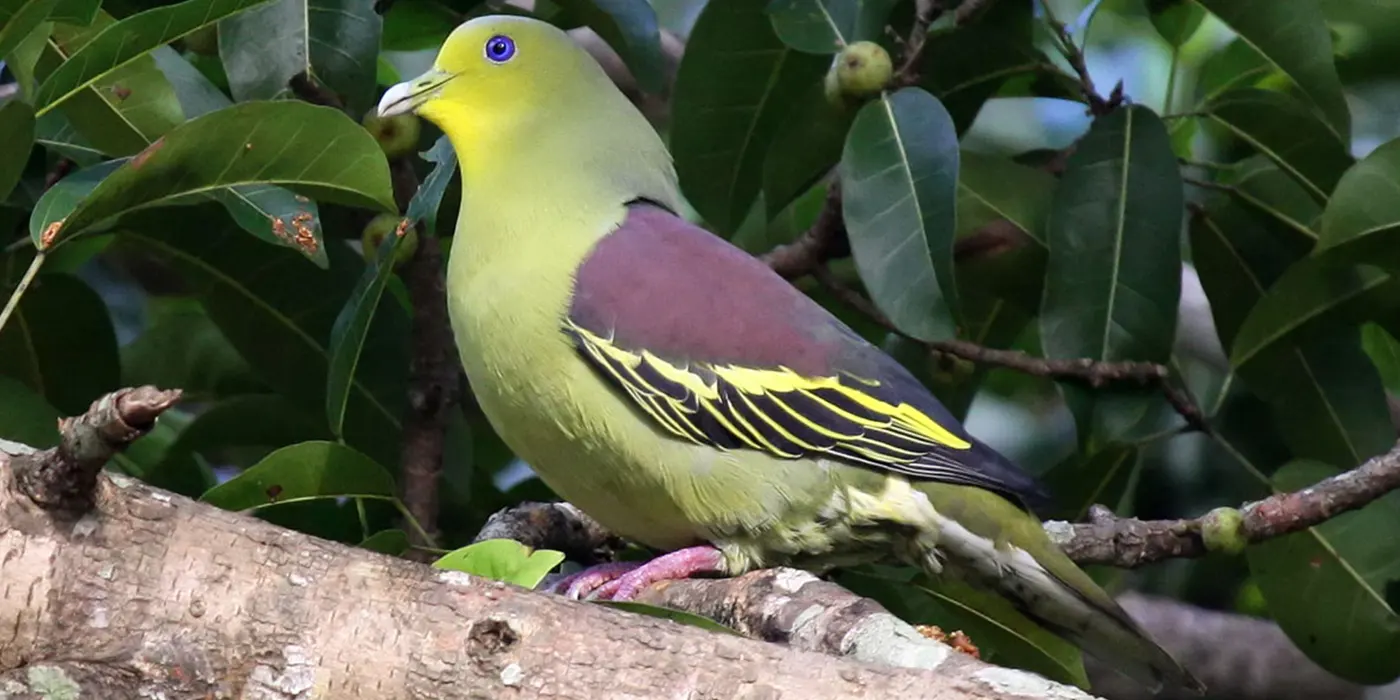
Birds: Kaudulla National Park is also home to a wide variety of birds, including peacocks, eagles, and storks. You might even see some rare birds, such as the Sri Lanka junglefowl.
Kaudulla Tank: The park is also home to the Kaudulla Tank, a large reservoir that is a popular spot for birdwatching. You can often see a variety of waterfowl, including pelicans, ducks, and geese.
When to go on a Kaudulla National Park safari
The best time to go on a Kaudulla National Park safari is during the dry season, which runs from December to April. During this time, the animals are more active and easier to see. However, Kaudulla is a beautiful park year-round, so you can go on a safari at any time of year.
How to book a Kaudulla National Park safari
There are a few different ways to book a Kaudulla National Park safari. You can book through a tour operator, such as Lanka Tour Experts, or you can book directly with a safari company.
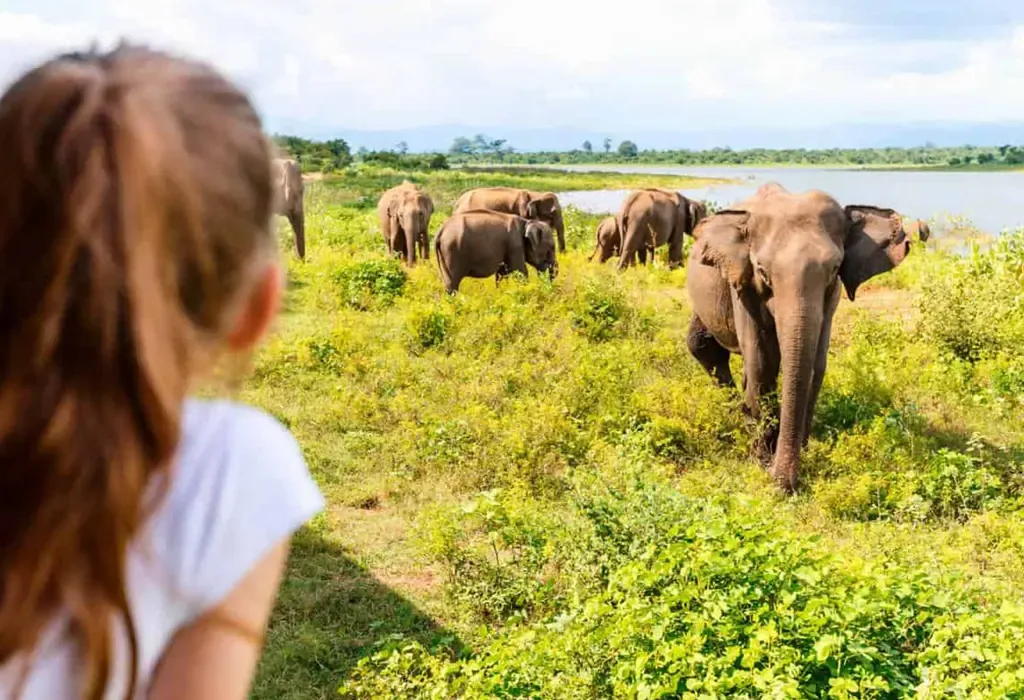
Tips for enjoying your Sri Lanka wildlife safari
Be prepared for anything: The weather in Sri Lanka can change quickly, so be sure to pack for all types of conditions. You should also bring sunscreen, insect repellent, and a hat.
Stay hydrated: The weather in Sri Lanka can be hot and humid, so it is important to stay hydrated. Bring plenty of water with you on your safari, and drink often.
Wear comfortable shoes: You will be doing a lot of walking on your safari, so it is important to wear comfortable shoes. Avoid wearing sandals or flip-flops, as these can be slippery and dangerous.
Bring binoculars: Binoculars can be a great way to get a closer look at the animals you see on your safari.
Learn about the animals: Before you go on your safari, take some time to learn about the animals that you are likely to see. This will help you to appreciate them more and to understand their behavior.
Be patient: It can take some time to spot the animals, so be patient and keep your eyes peeled.
Respect the animals: Remember that you are in their habitat, so be sure to respect the animals and their space.
Have fun: Sri Lanka wildlife safari is a beautiful with amazing animals, so make sure to have fun on your safari!
Suggested reading:
- The Best Time to Visit Sri Lanka
- Sri Lanka Visit Visa – Ultimate Guide
What are the best national parks for wildlife safaris in Sri Lanka?
Yala National Park: This park is home to a wide variety of animals, including elephants, leopards, and sloth bears. It is also one of the best places in Sri Lanka to see water buffalo.
Udawalawe National Park: This park is known for its large herds of elephants. It is also home to other animals, such as water buffalo, monkeys, and crocodiles.
Minnriya National Park: This park is home to a large number of elephants, as well as other animals, such as water buffalo, deer, and birds.
Wilpattu National Park: This park is the largest in Sri Lanka and is home to a wide variety of animals, including leopards, elephants, and sloth bears.
Gal Oya National Park: This park is home to a number of endangered species, including the Sri Lankan leopard and the sloth bear. It is also a great place to see elephants, water buffalo, and crocodiles.
What is the best time of year to go on a wildlife safari in Sri Lanka?
The best time of year to go on a wildlife safari in Sri Lanka is during the dry season, which is from November to April. During this time, the weather is warm and sunny, and there is less chance of rain.
What are the safety considerations for wildlife safaris in Sri Lanka?
* Be aware of your surroundings and take precautions against petty theft. * Do not get too close to the animals, as they can be unpredictable. * Listen to the instructions of your guide. * Be sure to wear comfortable shoes and clothing that you can move in. * Bring sunscreen, a hat, and sunglasses. * Drink plenty of water, especially during the hot season.
What are some other activities that can be enjoyed in Sri Lanka besides wildlife safaris?
Hiking and biking: Sri Lanka has a number of great hiking and biking trails. There are trails to suit all levels of experience, from easy family walks to challenging mountain treks.
Snorkeling and diving: Sri Lanka has some of the best snorkeling and diving in the world. There are plenty of places to explore, including the reefs off the coast of Trincomalee, the wrecks off the coast of Galle, and the underwater caves off the coast of Mirissa.
Cultural experiences: Sri Lanka is a rich and diverse country with a fascinating culture. There are a number of ways to experience the culture, such as visiting temples, attending cultural performances, and learning about the country’s history.
Beaches: Sri Lanka has some beautiful beaches, and they’re a great place to relax and enjoy the scenery. There are plenty of beaches to choose from, so you’re sure to find one that’s perfect for you.
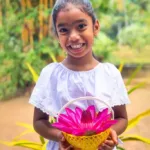
Copyright © 2024 Lanka Tour Experts. All Rights Reserved.

5 Best National Parks for Safari Tours in Sri Lanka
Are you wondering which national park is ideal for taking a Sri Lanka safari tour? Sri Lanka has many stunning national parks that are perfect for spotting diverse wildlife, such as elephants, leopards, sloth bears, crocodiles, monkeys, spotted deer, water buffalos, and various bird species.
It is a fantastic experience that should be on your Sri Lanka Itinerary, so book your elephant safari tour and visit one of the best national parks. Each national park in Sri Lanka is unique. So, whichever one you choose, you won’t be disappointed.
In this post, you can find out which are the best national parks, when to go, including entrance fees, jeep tour prices, and what to expect on your safari tour in Sri Lanka.
Disclosure: This post contains a few affiliate links, which means we may receive a small commission, at no cost to you, if you make a purchase through our link. This is a free way to support us and allow us to continue to create inspiring travel guides.
NO TIME TO READ NOW? PIN IT

Best time to go on Safari
The best time to visit Sri Lanka is between December and March in the south/west and March to October in the north/east.
Sri Lanka has two monsoon seasons: the northeast monsoon season, which runs from December to January, and the southwest monsoon season, which runs from May to September. During this period, it is harder to spot animals, and a safari tour on a rainy day is not much fun. However, during the dry season, animals are more often seen when they search for water or cool off at the lake.
For the best experience, book a morning safari tour or take a full-day Sri Lanka safari tour.
Sri Lanka Safari
Sri Lanka has over 20 national parks scattered throughout the country, all perfect for safari tours.
If you have limited time in Sri Lanka, we recommend visiting Yala or Udawalawe National Park. But depending on where you are staying in Sri Lanka and what you would like to see, such as leopards, elephants, or sloth bears, these are the best national parks to choose from, depending on your preferences.
Good to know The first two official national parks in Sri Lanka since 1938 are Yala and Wilpattu National Parks.
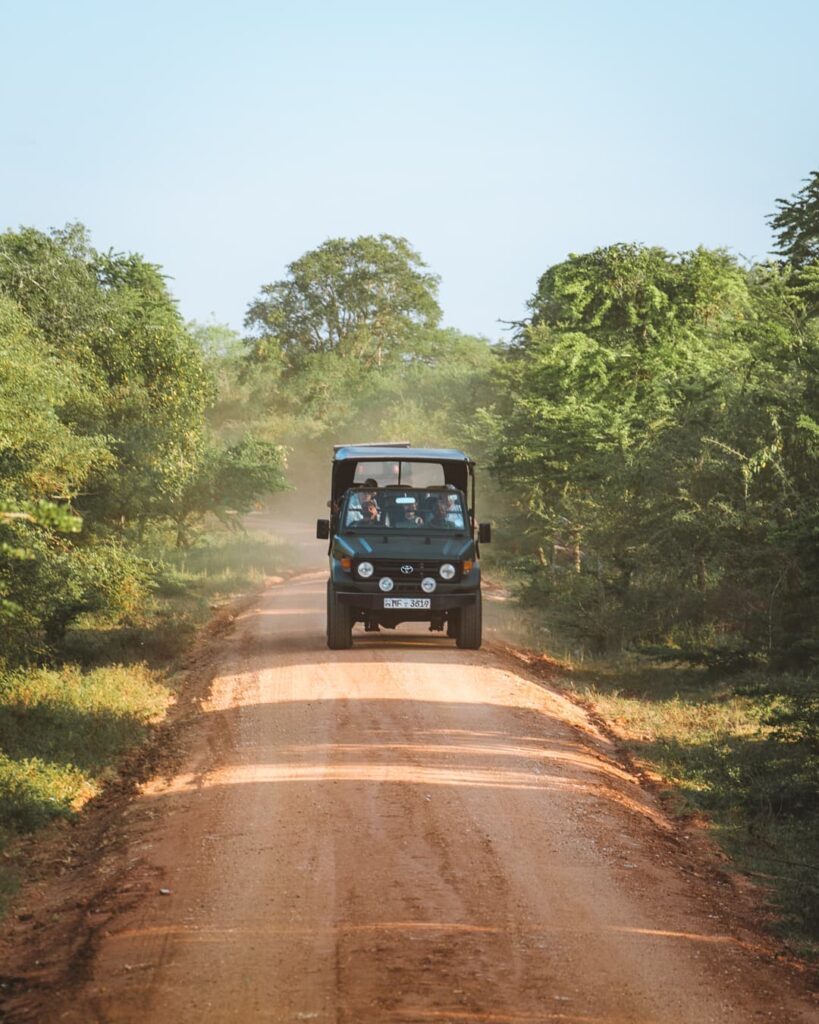
The best national parks for Sri Lanka safari
1. yala national park.
The Yala National Park is the best place to see leopards and elephants in Sri Lanka. You can easily reach Yala from Ella, Mirissa, or Galle and take a half-day or full-day Sri Lanka safari tour.
Yala National Park is home to 44 species of mammals and 215 species of birds. Yala is famous for having the world’s biggest concentration of leopards and is one of the best places in the world to spot leopards. There are around 60-70 leopards scattered throughout the park.
We recommend visiting Yala National Park from February to July. During this period, the weather is dry, and the water level in the park is low, making it easier to see the animals when they go to drink or cool off at the lake.
Read the full post → Guide to Yala National Park

Yala National Park Entrance Fee & Sri Lanka Safari Tour Price
The entrance fee to Yala National Park for foreign adults ranges from 31 USD to 36 USD per person. But the price depends on the number of people in the jeep (2-6 pax).
Usually, the entrance fee is 71 USD for two foreign adults.
The Yala National Park safari price depends on the safari tour you book, such as a private safari, group tour, or full-day safari.
Group jeep tours usually start from 28 USD per person, and private tours start from 100 USD per person.
Check safari tour prices and availability HERE.
Where to Stay near Yala National Park
Most people take a day trip to the Yala National Park from Ella, Galle, or Mirissa. But for the best experience, stay around Yala. These are our recommendations.
- Luxury: Wild Coast Tented Lodge
- Mid-Range: Jetwing Yala or Cinnamon Wild Yala
- Budget: Kaaya Eco Resort Yala

2. Udawalawe National Park
Yala is famous for its leopards, while Udawalawe National Park attracts visitors for its elephants. Over 500 elephants live in the park, which offers a great chance to see wild elephants in Sri Lanka (even on the afternoon elephant safari).
The Udawalawe National Park was established in 1972 to provide a sanctuary for wild animals displaced by the construction of the Udawalawe Reservoir on the Walawe River.
We recommend visiting Udawalawe National Park from January to March. The Udawalawe National Park is located in the south of Sri Lanka, and you can easily reach it from Ella, Mirissa, or Unawatuna.
Udawalawe National Park is best for elephants and bird watching, although there is a chance of seeing leopards.
Udawalawe National Park Entrance Fee & Sri Lanka Safari Tour Price
The entrance fee to Udawalawe National Park for foreigners is 25 USD. But this price does not include tax (15%) and tourist service fees, which also increase the cost.
Jeep tours usually start from 25 USD per person.

Where to Stay near Udawalawe National Park
We recommend you stay in Ella or Mirissa and take a day trip to Udawalawe National Park. These are our Ella accommodation recommendations.
- Luxury: EKHO Ella
- Mid-Range: Mountain Heavens or 98 Acres Resort & Spa
- Budget: Ella Mount View Guest Inn
3. Wilpattu National Park
Wilpattu is the largest national park in Sri Lanka and one of the best places for safari tour. Although not as popular as Yala, it is well worth a visit. It has a denser forest cover than other national parks and is larger than Yala, covering more than 130,000 hectares.
Wilpattu is located 40 km west of Anuradhapura, and the travel time is approximately 50 minutes.
The safari tours usually take 4-5 hours and are the perfect place to spot sloth bears and leopards. The Wilpattu National Park is open daily from 6 AM to 6 PM.
You can visit Wilpattu all year round, but the best time to visit is in the dry season, from May to early October.

Wilpattu National Park Entrance Fee & Sri Lanka Safari Tour Price
The entrance fee to Wilpattu National Park for foreign adults is 25 USD, and for children is 15 USD. But this price does not include tax (15%) and tourist service fees, which also increase the cost.
Jeep tours from Colombo or Negombo usually start from 105 USD per person.
If you stay in Wilpattu, you can easily join a group tour for 37 USD.
Where to Stay near Wilpattu National Park
Most people take a day trip to the Wilpattu National Park from Colombo or Negombo. Another alternative is to stay in Anuradhapura. These are our Colombo accommodation recommendations.
- Luxury: Shangri-La Colombo or Hilton Colombo
- Mid-Range: Mandarina Colombo
- Budget: Grand Oriental Hotel

4. Minneriya National Park
Minneriya National Park is located between Habarana and Polonnaruwa, so it is the perfect choice for those staying in Sigiriya. Join a morning or afternoon safari tour and see the stunning wildlife in Sri Lanka.
Minneriya National Park, part of the elephant corridor that connects Kaudulla and Wasgamuwa National Parks, is a great place to see herds of elephants throughout the year.
The best time to visit Minneriya National Park is from May to October. Get a wonderful experience in Sri Lanka and visit in August/September to see the famous Elephant Gathering of the Asian wild elephants.
Good to know The national park is an important habitat for two endemic monkeys of Sri Lanka, the purple-faced langur and the toque macaque.

Minneriya National Park Entrance Fee & Sri Lanka Safari Tour Price
The entrance fee to Minneriya National Park is 15 USD.
Safari tours usually start from 28 USD per person.
Where to Stay near Minneriya National Park
Most people take a day trip from Sigiriya, but you can stay around Minneriya National Park. These are our recommendations.
- Luxury: Ekho Lake House
- Mid-Range: The Deer Park Hotel
- Budget: Giritale Hotel
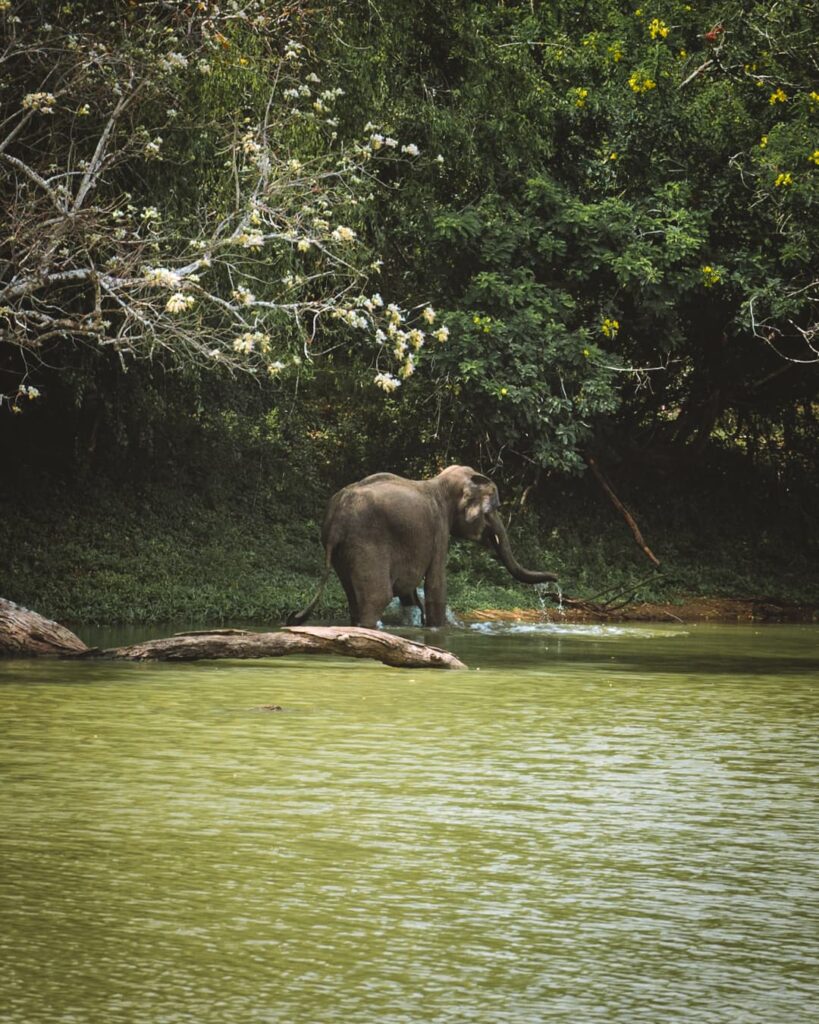
5. Kaudulla National Park
The Kaudulla is one of the best national parks near Polonnaruwa, so if you spend enough time in Sri Lanka, we recommend you take a jeep safari tour.
Although the park can be visited all year round, the best time to visit Kaudulla National Park is between July and December, especially in October. You can join a morning or afternoon safari tour, which takes about 3 hours.
Kaudulla National Park opened in 2002 and is one of the best places to see elephants and birds in Sri Lanka. The Kaudulla National Park is home to Asian elephants, water buffalos, monkeys, crocodiles, spotted deer, and more than 160 species of birds.
TIP The afternoon safaris are less popular, but there are more chances to see elephants at Kaudulla.
Keep reading → How to Visit Dambulla Cave Temple

Kaudulla National Park Entrance Fee & Sri Lanka Safari Tour Price
The entrance fee to Kaudulla National Park is 18 USD.
Jeep tours usually start from 45 USD per person.
Where to Stay near Kaudulla National Park
The national park is easily accessible from Sigiriya, Dambulla, Polonnaruwa, and Trincomalee. But you can also stay around the Kaudulla National Park. These are our recommendations.
- Luxury: Ekho Lake House
- Mid-Range: The Deer Park Hotel
- Budget: Giritale Hotel

Tips for Sri Lanka safari tours
- Wear closed sports shoes and lightweight, quick-dry clothes, as the weather is always warm and humid. But the weather is cold during early morning safaris, so bring a sweater or light jacket.
- Most safari tours include water, breakfast, or lunch, but bring enough water and snacks.
- Safari tours cannot guarantee leopard spotting, but Yala National Park has the best chance of seeing leopards.
- Some people may be unwell on a full-day safari tour as the road is very bumpy. Therefore, we recommend taking anti-nausea tablets with you.
- Do not feed animals!
- Use sunscreen and wear a hat.
- Kumana National Park and Bundala National Park are other national parks worth visiting in Sri Lanka.

- If you want to pass wild elephants on the way to Yala National Park, take a detour on the B35 Road.
- Always be ready to take photos, as you will see lots of wildlife and birds.
- Take a zoom lens with you.
- Use the toilet before going on a safari tour.
- Most safari tours do not include the entrance fee to the national park.
- The entrance fee can only be paid in Sri Lankan Rupees (LKR) at the entrance gates.
- The safari tours usually take 3-5 hours.
Important note Please don’t support places where elephants are kept in chains, so don’t visit the Pinnawala Elephant Orphanage in Sri Lanka!
We hope you found our guide to the best safari tours in Sri Lanka useful and that it will inspire you to visit some of the beautiful national parks. If you have any questions or thoughts, let us know in the comments below.
Travel Resources
Hotels – Booking.com Car Rentals – Discover Cars Flights – Skyscanner Travel Insurance – SafetyWing Tours & Attractions – GetYourGuide Bus/Transfer – Bookaway
RECOMMENDED POSTS
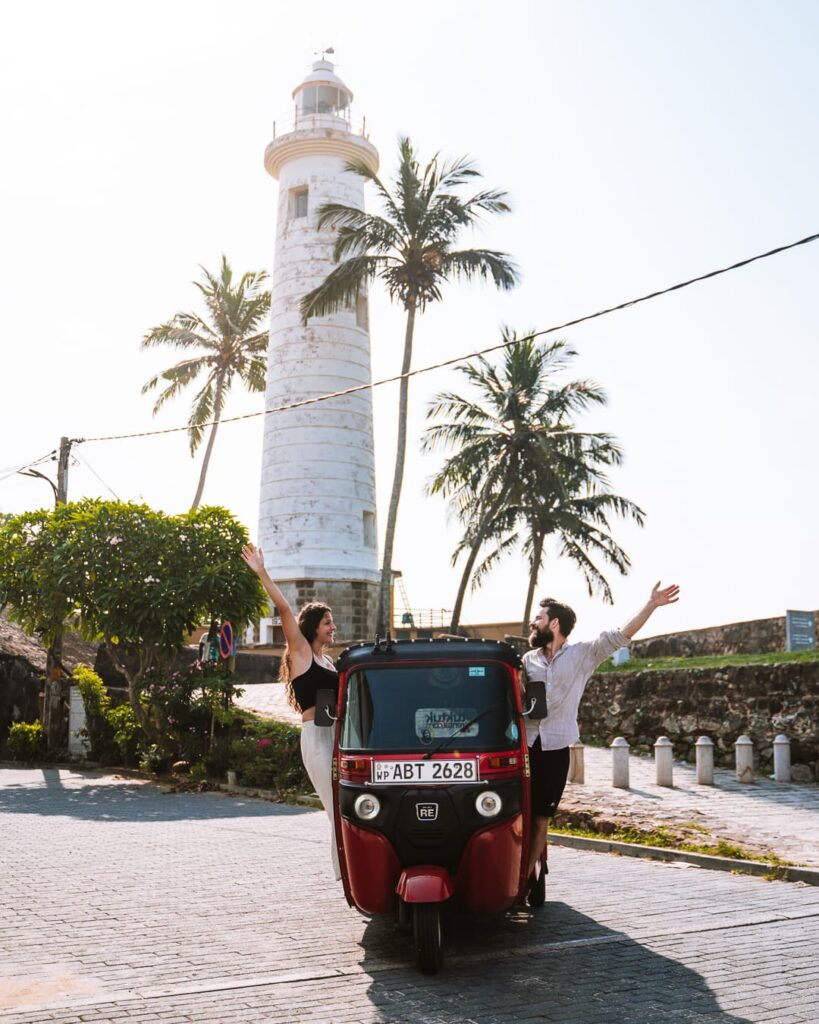
The Ultimate Sri Lanka Itinerary for 14 Days
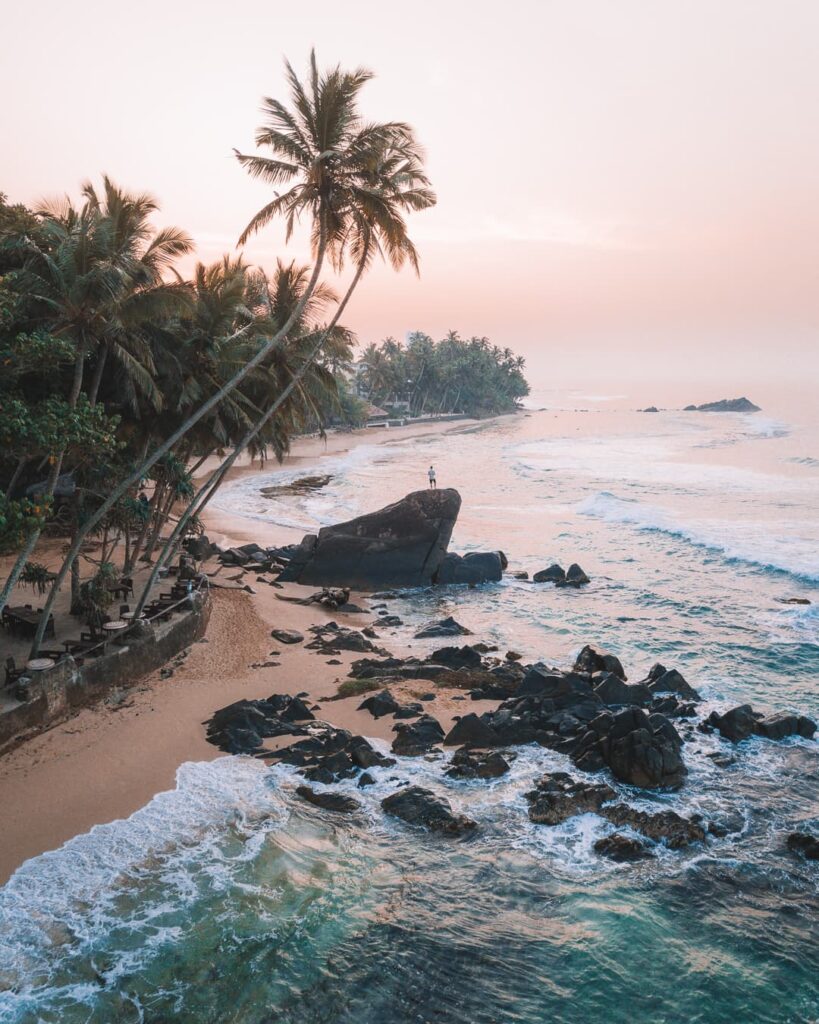
The Best Sri Lanka Itinerary for 7 Days
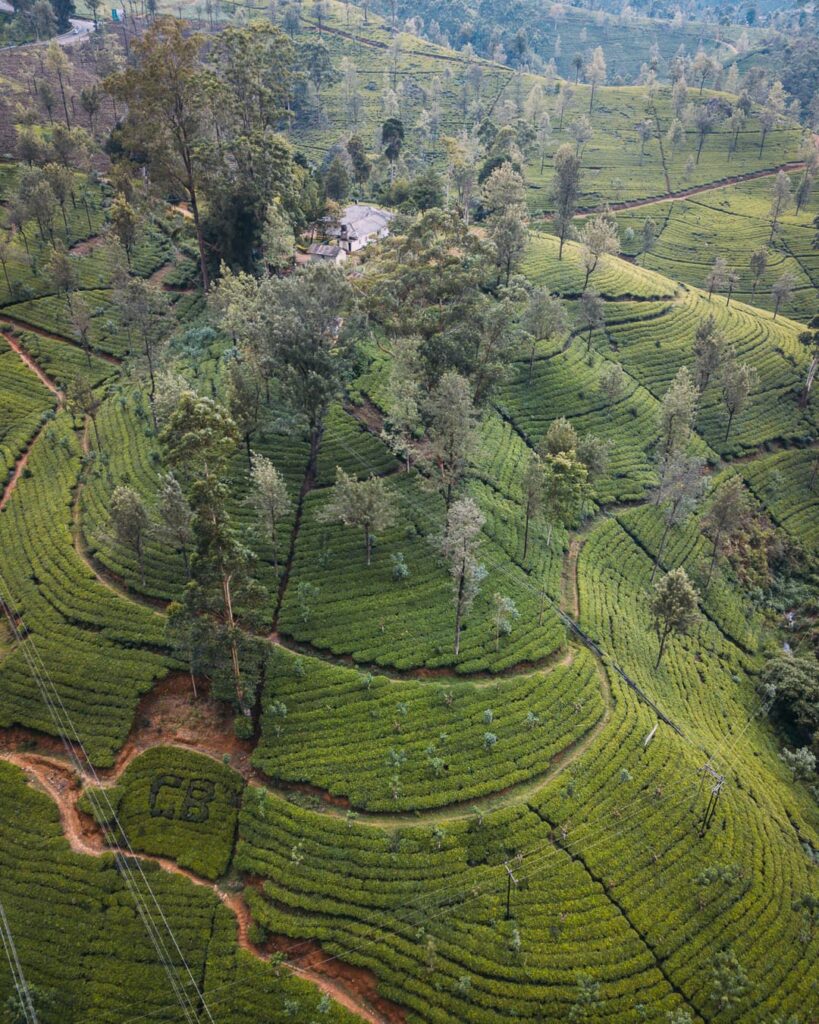
Best Ways: How to Get from Colombo to Nuwara Eliya
Leave a comment cancel reply.
Your email address will not be published. Required fields are marked *
Save my name, email, and website in this browser for the next time I comment.
Privacy Overview
Pin it on pinterest.

What are you looking for?
Our complete guide to planning a safari in sri lanka in 2024.
When visiting the wonder of Asia that is Sri Lanka, your itinerary wouldn’t be complete without a trip to one of the amazing Safaris on offer in the country.
When you think of a safari, we typically think of Africa, but don’t underestimate the greatness of a Sri Lanka Safari.
It is easily one of the best things to do in Sri Lanka and when it came to deciding what safari in Sri Lanka I would opt for, there was A LOT of choice.
So I figured to make your life a little easier, a guide covering all you need to know about safaris in Sri Lanka and highlighting the best safaris in Sri Lanka would be pretty useful.
So, with that in mind, keep reading this guide to create the perfect Sri Lanka safari holidays...

Travellerspoint
Let’s begin with our experience
We visited the Wilpattu National Park Safari which is well known for its leopard sightings, and is actually the reason I choose it.
I l ove elephants , but I’ve seen a lot of elephants, so I figured we could try and spot something different.
It was an AMAZING safari, and fantastically priced on booking. com and you can read about the experience here .
But imagine, staying in a luxury tent, dining underneath the stars, and you’ll have a taste of what a Wilpattu National Park Safari is like.
Going on safari in Sri lanka
There are 22 Sri Lanka national parks.
But with so much choice, it’s hard to know where to start searching for the perfect Sri lanka safari tours.
Sri Lanka wildlife consists of amazing elephants, bears, leopards and so much more.
Here’s a detailed look at the 6 most popular national parks in Sri Lanka for safaris.
Yala safaris in Sri Lanka

About Yala national park
Yala national park is probably the most popular and well known safari in all of Sri Lanka.
It’s the second largest national park in Sri Lanka and it’s a wonderful safari experience for all, especially families.
Yala safari is located around six hours from Colombo which is why most people organise a tour here (some of which I’ve listed below).
Animals to see in Yala national park safari:
- 215 bird species including , Sri Lanka wood pigeon, blue-tailed bee-eater, amongst many others
- 44 mammals including, the famous Sri Lankan elephant, leopards (Yala has the highest density of leopards in the world), the Sri Lanka sloth bear, and many more.
- 47 reptile species including the Sri Lankan flying snake, Indian cobra, and saltwater crocodile, among others.
The only problem with Yala is that because it is so popular, you’re going to be in a park that is filled with jeeps.
You may even see more jeeps than animals, and because of the high number of visitors, the chances of seeing leopards is slim due to the noise etc.
But, you have a very high chance of seeing lots of elephants, so if you love elephants and don’t mind the crowds, then it’s a great choice!
This is probably the best elephant safari Sri Lanka has to offer.
If you're wondering when the best time to visit yala national park is then be aware that Yala is closed during the drought season from the 1st of September to the 15th of October, but you can visit other national parks at this time, including Wilpattu.
Be aware that all my safari suggestions below include accommodation and safari for one night unless otherwise stated. I always find it’s best to get everything booked beforehand, plus it makes you excited!
Best luxury safaris in Yala
If you want an luxury safari sri lanka experience in Yala national park, then these spots will not fail to deliver.
Yala National Park All-Inclusive 2-Day Safari At The Leopard Nest Campsite
$450 per person
This is an excellent Sri Lanka safari that offers luxurious accommodation amongst the jungle with an all inclusive experience.
Imagine sleeping in a luxury treehouse with your own camp fire underneath the stars.
The price is excellent for the beautiful accommodation, all your food and drink and two game drives with a professional and qualified guide.
It also includes pick up from Colombo, Mount Lavinia and Negombo, Kalutara, Bentota, Hikkaduwa, Galle, Unawatuna , Mirissa and Weligama, which is excellent.
They take care of everything, so all you need to worry about is spotting animals and having an amazing time!
You can do a 2 night version of this same trip but with Viator.
Remember if you do a 2 day safari you'll have a better chance of experiencing a night safari Sri Lanka style.
Kulu Safari
$725 for two people all inclusive
This is a brilliant safari tour and you can go for an all-inclusive option that includes all your food, drinks, alcohol drinks and 2 game drives. Great value.
The accommodation is in the style of luxury tents with little decks which is perfect for dining under the stairs.
It will feel like you're camping in Sri Lanka, but in ultimate luxury.
Book it here.
Chena Huts by Uga Escapes
Prices start at $700 for two people all inclusive
An all-inclusive stay with accommodation location within the jungle and a safari experience.
Everything is included within this price , food, drinks, alcoholic drinks, spa experiences. It’s TOTAL luxury, but it’s expensive, but you can see why.
It's the perfect jungle safari in Sri Lanka.
Take me with you.
Book your stay here.

Best budget safaris in Yala
If you want a budget experience in Yala national park, then you’ll need to book cheap accommodation within Yala vicinity then book a day safari.
You’ll still get all the animal sightings experience, but miss out on the camping and dinner under the stars.
Below are some great value choices.
Viator Budget Yala Half Day Safari Experience
$37.50 per person
Includes pick up and drop off from your hotel in Yala, Katagrama area, and a 4 hour safari keep experience.
Get it here.
Viator Private Yala Half Day Safari
$38.25 per person
If you’re on time constraints, then this is a great choice.
It includes pick up from your hotel and you can arrange an early money or afternoon safari experience to suit your day. Includes a private driver for a private experience.
Great choice for couples on a budget looking for a Yala safari.
Get it here.
Yala day safari from Mirissa
For just $32 with Klook, you can take this awesome day tour safari of Yala National Park from Mirissa.
Transfers and safari experience included but you will need to pay the entrance fee to the national park. There is a morning and afternoon safari option too! Great for those on a strict budget.
Book it here.
Elephant Lake Yala
$220 dollars per night
I’ve also included this one, as I think it’s a budget option for two reasons:
- You can book an all-inclusive option that includes your accommodation, all your food, all alcohol drinks and a half day safari for only $105 dollars each, which is BRILLIANT value for absolutely everything.
- You can book to stay in a tent and just breakfast for $33 dollars each per night and add on a safari experience.
Book your amazing stay here.
Best mid range safaris in Yala
Eco island sri lanka tented safari camp yala.
$288 per night (based on two people sharing)
This mid-range accommodation offers you the chance to stay in a beautiful tent within the jungle alongside breakfast and dinner under the stairs.
The price includes a 5 hour game drive and it’s a great choice for those who have a little extra to spend and would like the overnight experience of a safari.
5 hours is a good amount of time to see some amazing animals!
Book your experience here.
Big Game Camp Yala
$264 per night (based on two people sharing)
Big Game camp is the company that Bradley and I stayed with in Wilpattu, and they offer safari experiences in both Yala and Udawalawe.
You get five star service for a mid range price, and I personally think it’s excellent value for money.
You get to stay in a luxury tent underneath the stars in jungle surroundings. The dining underneath the stars in the evening is a spectacular experience with a 5 course meal.
The staff at Big Game Camp are outstanding across the board and you’ll truly not want to leave!
With the safari option you get a half day safari, an afternoon tea, and breakfast and dinner under the stars.
Book your Big Game Safari Stay here.
Best luxury Yala safari for couples and honeymoons
I’ve included two safaris which I think ooze romance and bliss for couple travellers who simply want to have a romantic safari experience, or who are celebrating their honeymoon.
These are both all inclusive options and include two game drives.
The tents are beyond luxurious and it’s a truly wilderness safari experience that screams romance.
You’ll see what I mean…
Jetwing Safari Camp (All Inclusive)
$467 based on two people sharing
Get it here
Yala Tented Camp by Ajith Safaris - All Inclusive
$678 based on two people sharing
Wilpattu safaris in Sri Lanka

About Wilpattu national park
Wilpattu national park is the oldest and largest national park in Sri Lanka.
It was actually closed for 16 years during the Sri Lankan civil war, but is now open to the public again.
Wilpattu national park is a perfect choice if you’re visiting the cultural hubs of Anuradhapura as it’s only 30 minutes away by tuk tuk.
This is the park Bradley and I visited and it’s wonderful.
In my opinion, it's the best safari park in sri lanka.
It’s famous for its natural pools of water that exist, so you get a true essence of the “wild” here.
It’s the perfect safari in Sri Lanka for all seasons as both the wet and dry season bring different types of animals.
For example, the wet season is meant to bring greater sightings of sloth bears, but we got to see one in the dry season too!
Wilpattu national park is around 4 hours from Colombo.
Wilpattu is among the top national parks world-renowned for its leopard population, which is why Bradley and I visited.
The best time to visit Wilpattu is February to October, but you can visit all year round with certain eco groups.
Animals to see in Wilpattu national park safari:
- Birds: there are lots of amazing birds to see including The painted stork, the open bill, little cormorant, Sri Lankan junglefowl among others
- Mammals: 31 species of mammals have been identified so far including the Sri Lanka elephant, the Sri Lankan sloth bear, leopards, water buffalo, spotted deer, amongst others
- Reptiles: The most common reptiles include the common cobra, the mugger crocodile, Indian python amongst others
Wilpattu is a quiet national park, probably because it was closed for so long, but that’s a good thing.
You will only come across 2 or 3 jeeps on your journey (if even that) and you will truly feel like you’ve got the whole park to you and the wildlife, which I think is what a true safari experience should be like.
So if you want a secluded Sri Lankan Safari experience, then this is the perfect one for you.
Best luxury safaris in Wilpattu
Mahoora tented safari camp all-inclusive.
$639 per two people sharing
This is a fantastic all-inclusive option for a Wilpattu Safari experience.
It includes everything you could ever need, food, drink, alcohol drinks, One Half-day safari ride in a luxury jeep with forward-facing seats, even a picnic lunch on the safari day, and much more.
Leopard Trails Wilpattu
$1009 per night per two people sharing
A 5 star resort that oozes luxury, and it’s no surprise with the price.
It includes everything you need including, food, drinks, alcoholic drinks, and two game drives.
Best budget safaris in Wilpattu
Private day tour.
If you’re looking for a budget option then this private day tour is a great option!
Afternoon game drive
If you are on a time constraint, then an afternoon safari in Wilpattu is a great idea. This tour leaves from Anuradhapura, which is perfect as it’s only 20 minutes away and something you can do after a morning of sightseeing in the area!
Budget Day Trip from Anuradhapura
Another awesome budget option is this tour with Klook which is only $35. You can book it here.
Best mid range safaris in Wilpattu
Big game camp wilpattu .

This is the safari in Sri Lanka that Brad and I went on. I think this is the best Sri Lanka safari on offer.
I can say it’s amazing value, an amazing experience and you can read all about it here.
Book here: This is my absolute highest recommendation for luxury, value and experience.

Udawalawe safaris in Sri Lanka

About Udawalawe national park
Udawalawe national park is located near South of Sri Lanka and it is literally bursting with Sri Lankan elephants.. .more than 500, so it’s an elephant lovers dream.
You’re almost guaranteed to spot them with those numbers.
Udawalawe national park safari is located 4 hours from Colombo and is the 3rd most popular Sri Lankan safari.
Within the park there is even a he Udawalawe Elephant Transit Home was established in 1995 for the purpose of looking after abandoned elephant calves within the park. Cute right?
The best time to visit a Udawalawe safari in Sri Lanka is all year.
It’s an all year park due to its location, which makes it a perfect spot for any Sri Lankan itinerary.
Animals to see in Udawalawe national park safari:
- Bids: Over 180 species of birds including, Sri Lanka spurfowl, red-faced malkoha, Sri Lanka grey hornbill, brown-capped babble among others. It’s actually regarded as one of the top bird watching sights in all of Sri Lanka
- Mammals: There are over 42 mammals recorded in the park, particularly notable for its Sri Lankan Asian elephants. Other mammals include, Sri Lankan leopard, sloth bear, sambar deer, wild boar among others.
- Reptiles: There are over 32 reptile species including, oriental garden lizards, mugger crocodiles, and 30 species of snakes, among others.
This is a perfect choice for those who want to get awesome pictures of elephants and baby elephants.
It’s a fairly popular park, but won’t have the same crowds of Yala, so it’s a good choice for those looking for something in between Wilpattu and Yala, and since it’s good for spotting animals all year round, there are no seasonal restrictions on when you visit.
That's why people love a Sri Lanka safari Udawalawe.
Best luxury safaris in Udawalawe
Master campers.
$643 per two people sharing
All all-inclusive tent jungle experience in beautiful Udawalawe.
Highly rated food, accommodation and safari experience, this is an excellent choice for families and friends. Reviews say they take you up real close to the elephants!
Price includes your alcohol, food, accommodation and two game drives.
Best budget safaris in Udawalawe
Private tour: udawalawe national park safari (half day).
Start at $31 per person
If you’d like your own romantic private safari tour of Udawalawe national park then this is a great value choice.
It’s a half day safari giving you the chance to spot some animals in a morning game drive.
Private full day tour of Udawalawe national park safari
Starts at $63 per person
If a half day simply isn’t enough for you, then opt for this private full day safari tour!
You’ll have even more chance of spotting amazing animals.
Best mid range safaris in Udawalawe
Big game camp udawalawe.
$239 per two people sharing
I’ve said before how brilliant our experience with Big Game Camp was in Wilpattu and it seems like the experience in Udawalawe is just as good according to the reviews, value and what’s offered.
I don’t think you can go wrong with choosing these guys.
Dinner and breakfast al fresco, afternoon tea, and a game drive with luxury tent accommodation.
It’s great!
Minneriya safaris in Sri Lanka

About Minneriya National Park
Minneriya national park is located in the dry zone of Sri Lanka, and it’s a perfect choice if you’re visiting Sigiriya, (which you should).
It’s one of the most important bird areas in Sri Lanka. It has an interesting elephant story…
According to the wardens, one elephant lost her baby due when pregnant due to being hit by a jeep, so as revenge, she rammed into over 15 tourists since then.
I guess elephants remember, and you should be careful not to kill their children!!!!
But yeah, so the elephants are known to be a little angry at humans, which I think is fair enough.
It’s an important spot for monkeys!
Animals in Minneriya National Park
- Birds: 160 species of birds which is why it’s an important bird area
- Mammals: It’s recorded there is 24 different types of mammals in the park including, Sri Lankan elephant, deer, purple-faced langur and toque macaque monkeys among others.
- Reptile: 25 reptiles including Painted-lip lizard, Saltwater crocodile, Indian python, Asian water monitor, among others.
Fun fact, this national park safari has over 25 species of butterflies!
People tend to take a Minneriya national park safari for the chance of seeing elephants and monkeys.
So if you’re a fan of both, then this is a good spot.
A good time to take a Minneriya national park safari is July to September as that’s when the elephants flock there.
Best safaris in Minneriya
With regards to booking online, there isn’t a WIDE range of choice, but there is a good value private tour listed below.
This is because the park isn’t as popular as other marks, so it’s really only worth a day tour, rather than an overnight safari experience.
If you’re on a time constraint, then opt for this.
Because you will be near Sigiriya , it’s always worth staying there, then doing your safari from there. It’s popular for companies and lodges to offer safaris with them too.
If you need a place to stay near Minneriya, then I recommend the Cassandra Culture Resort , because it’s cheap, luxurious and has amazing views.
You won’t regret it, trust me.
Private tour of Minneriya national park
$44 per person
If you’d like your own private safari tour of Minneriya national park sorted before you arrive, then this is a good choice.
It also offers pick up and drop off within the area which will save on tuk tuk costs!
Bundala safaris in Sri Lanka

About Bundala National Park
Bundala National Park is an internationally important wintering ground for migratory water birds in Sri Lanka. It’s located in the Southern area of Sri Lanka and it well known for its bird population and it’s located around 4.5 hours from Colombo.
I haven’t heard much about this park in terms of reviews, and it’s very close to Yala so it probably loses a lot of competition from there, but that’s probably a good thing which makes it quieter to visit.
Animals to see in Bundala national park
- Birds: Almost a whopping 200 bird species are located in the park
- Mammals: 32 mammals inhibit the park including some elephants, leopard, wild boar, mouse deer, among others
- Reptiles: There are 43 species of reptiles including rat snake, python, crocodile, amongst others
I think is probably one of the least visited national parks in Sri Lanka and it’s not a good choice if you want to see elephants. But, if you like birds and reptiles then it’s a great choice! The best time to take a Bundala national park safari is September to March.
Best safaris in Bundala
Full day safari with picnic.
$81 per person
If you’re looking for a full day safari in Bundala then this is a great choice.
You’ll start your day at 5.30 with a pick up from your hotel and head out to find amazing animals, then you’ll stop half way through for a picnic lunch in the jungle, then head back to your hotel at around 4.30pm.
Bundala national park safari
$48 per person
You can choose from a full day or half day safari for this trip (great if you’re on a time constraint). It’s a similar experience to above, but without the picnic lunch.
Wasgamuwa safaris in Sri Lanka

About Wasgamuwa National Park
Wasgamuwa national park is located central of Sri Lanka and was actually created by the government to help displaced wild animals (one of four).
Wasgamuwa is one of protected areas where Sri Lankan Elephants can be seen in large herds and its one of the important bird areas of Sri Lanka.
It’s located around 5 hours from Colombo and the best time to visit is
Animals to see in Wasgamuwa national park
- Birds: There are 143 species of bird in the park including, Endemic red-faced malkoha, Lesser adjutant, yellow-fronted barbet, amongst others.
- Mammals: There are a recorded 23 mammals in the park including, 154 Sri Lankan elephants, monkeys, water buffalo, amongst others. Sightings of leopards and sloth bears are rare.
- Reptiles: There are 17 species including, mugger crocodile and water monitor.
If you’d like to spot some elephants in a relatively quiet
Best Wasgamuwa National Park safaris
Budget safari at wasgamuwa national park, tcs safari village .
$40 per couple sharing
This safari village offers budget accommodation, and you can book on a great value safari trip when you are there.
They offer both full day and half way game drives.
It’s located in a wild area, so you might even spot some wildlife amongst your living surroundings!
Safari at Wasgamuwa National Park
$57 per person
This is a full day safari option, perfect if you’ve just got a day to spend and are not fussed on staying near or within the borders of the national park.
Luxury safaris at Wasgamuwa national park
Explorer by mahoora - wasgamuwa .
$980 based on two people sharing
This is definitely a luxurious option for those looking to truly relax and unwind on their safari experience.
It’s an all inclusive option that covers your food, drink, alcoholic beverages, luxury tented accommodation and of course your high quality game drive with guide.
You even get a picnic on your drive as well!
Mid range safaris in Wasgamuwa national park
Camping in wasgamuwa national park.
You can opt to stay overnight in the park for one or two nights on an all inclusive options with tented accommodation, 3 course dinner, beer, and two safari game drives for twice the chances to spot amazing animals.
Book your stay here.


Kumana national park safaris in Sri Lanka
About kumana national park.
Kumana national park safari is located near Arugam bay, and you can actually do a tuk-tuk safari before you get to the official entrance, which is pretty cool.
You can spot elephants, deer and water buffalo.
Kumana was formerly known as Yala East National Park , but changed to its present name on 5th September 2006.
It’s one of the most important bird nesting and breeding grounds in Sri Lanka with 255 species of birds have been recorded in the national park.
It’s perfect is you’re on a budget because you can drive your own tuk tuk to the park, or even pay a tuk tuk driver to take you, or of course, you can go inside the park for a game drive too!
Animals you can see in Kumana national park:
- Birds: 255 species of birds recorded, which makes it the largest bird safari in Sri Lanka
- Mammals: The different types of mammals include, the golden jackal, wild boar, Sri Lankan elephant, and the European otter.
- Reptiles: Reptiles include Mugger crocodile, Indian flap-shelled turtle and Indian black turtle.
I think this is a good safari in Sri Lanka if you’re surfing in Arugam bay and just want something close and easy.
You might not see as many animals as you would on say, a Yala safari, but it’s fun all the same!
Best Kumana national park safaris in Sri Lanka
Private tour of kumana national park.
If you’d like a private tour experience of Kumana national park safari, then this is a great choice at a great price.
Book it here
One night camping in Kumana national park safari
If you’d like the chance to stay overnight and do camping with a safari experience, then this is a great choice and it’s even better as it’s organised from Colombo which is where you’ll be flying in to!
Ridiyagama safari park in Sri Lanka
About ridiyagama safari park.
Ridiyagama is a safari park and the first of is kind in all of Sri Lanka.
It’s 500 acres and it’s more a zoo, I’d say, except you’re the ones in cages and the animals roam free.
This was one Sri Lanka national park I wasn't aware of before my research, or during my visit.
It was open to the public in 2016, so it’s very new by Sri Lankan standards.
They have 22 different types of animals and you can do day trips to this safari park, but no camping!
This safari has animals from other countries too such as camels, zebras, lions, etc, but they all roam free.
You can take a day tour to it here from Colombo.
Cost for entrance into Ridiyagama safari park:
Adult: LKR 2500.00
Children: LKR 1250.00
Common FAQ about safaris in Sri Lanka
How much do sri lanka safaris cost.
If you've been wondering about a Sri Lanka safari price, it can range greatly.
You can definitely get a cheap safari by using online websites like the suggestions I’ve made above, but mainly the cheap way to do it is to book your accommodation with booking.com and book an full day or half day tour with an online booking company.
It’s always cheaper than paying there, because you don’t have to haggle.
Check out these sites for the best deals.
- GetYourGuide
- Booking.com
If you want luxury, then you can find that too, and the safaris in Sri Lanka that I suggested above are about as luxurious as it gets!
Should I book a safari before I get to Sri Lanka?
Personally I think yes. When you get to Sri Lanka and try and buy a safari in a tour or something, then you’ll often get charged more because you’re white and people often expect you to have lots of money.
It can sometimes be hard and hassle to negotiate, so if you book a tour ahead of time, you’ll know exactly what you’re getting for your money and you can pay for it in advanced.
Overall, Sri Lanka safari tours are bet bought in advance.
When is the best time to do a Sri Lanka safari?
There are safaris in Sri Lanka available all year round. So depending on the month you decide to go, you’ll find something.
Throughout this post, I’ve listed the best times to visit each safari in Sri Lanka, so use that as a guide when booking your Sri Lankan safari adventure.
What should I take with me to Sri Lanka?
For a detailed rundown of what to pack when travelling to Sri Lanka, check out our detailed packing list here .
I hope you have enjoyed my post on safaris in Sri Lanka.
I’ve tried to include every safari that is available in Sri Lanka that you could possibly want.
If you visit any of these places, let me know what you thought and if you enjoyed it.
If you're wondering what is the best safari in Sri Lanka, personally my favourite is the Big Game Camp, because that’s where I stayed, but to be honest, they all look fantastic and whatever you choose, you’ll have a wonderful safari experience in Sri Lanka!

Leave a comment
Let us know what you think.

5 million people can't be wrong
Never travel without TRAVEL INSURANCE! I use, and recommend, SafetyWing
Just Go Exploring uses affiliate links. If you purchase something through them, I may receive a commission, at no extra cost to you. See my disclosures page for more info.
Wilpattu National Park Safari Travel Guide: The Wild Side Of Sri Lanka (2024)
- Last Updated: March 19, 2024
- Asia , Destinations , Sri Lanka
Wilpattu National Park is hands down my favourite national park in Sri Lanka .
If you’re looking for an unspoiled and intimate safari experience in one of Sri Lanka’s most pristine wildernesses, you should definitely consider coming here.
Table of Contents
Spanning more than 1,300 square kilometres (500 sq mi), Wilpattu is the largest national park in Sri Lanka and one of the oldest.
It’s an incredibly beautiful place, with diverse landscapes and habitats including dry evergreen forests, marshes, wetlands, scrub jungles, mangroves, grasslands, and saltwater lagoons.
It was closed for most of Sri Lanka’s brutal 26-year civil war and witnessed periods of intense fighting. However, it’s been fully open since 2010.
Despite containing one of the highest concentrations of leopards in the world, this incredible place remains relatively off-the-beaten-path . Most tourists still don’t come here. That’s what makes it so great.
🤩 This is the best full-day safari tour of Wilpattu National Park
Why Visit Wilpattu National Park?
The best thing about Wilpattu is its quietness. Despite being larger than the famous Yala National Park, Wilpattu receives a tiny fraction of the number of visitors.
I’ve been on safaris in both Yala and Wilpattu, and Wilpattu was so much better in virtually every way.
Yala is so popular that it often feels overcrowded. It’s common to see more than 10 jeeps all jostling to see one animal. This clearly isn’t ideal, either for the animals or the people trying to see them.
When I went on a full-day jeep safari in Wilpattu , I saw fewer than 10 other jeeps all day . Most of the time, it feels like you have the entire park to yourself.
It’s an amazing place – peaceful and totally unspoiled.
Wilpattu is home to an incredible range of wildlife, including Sri Lankan leopards, sloth bears, Asian elephants, crocodiles, jackals, buffalo, deer, eagles, hornbills, and giant clouds of butterflies.
The main downside to Wilpattu is that you’re less likely to spot quite as many animals here compared with Yala. The animals here are shyer, more spread out, and can be harder to spot.
Although this is largely because of the lack of interaction with humans, so it’s actually quite a good thing.
That said, I saw all of the above animals and many more on my Wilpattu safari trip. It was a really unforgettable experience and I’ve been raving about this park ever since.
It’s also much cheaper to go on safari here than in places like Tsavo National Park in Kenya.
Where Is Wilpattu National Park?
Wilpattu National Park is located in the northwest of Sri Lanka, about 40 kilometres west of the ancient city of Anuradhapura and 180 kilometres north of Colombo .
The main park spans both the North Central and North Western Provinces and occupies a vast area of more than 130,000 hectares (321,000 acres).
In Sinhala , Wilpattu translates roughly as “Land of the Lakes” due to the roughly 60 naturally-formed lakes that are dotted around the park.
These “ Willus ” (or “ Villus “) collect rainwater and help to sustain the park’s vibrant ecosystems. They are vital sources of fresh water for the wildlife of Wilpattu, which also makes them ideal places to spot animals drinking and bathing.
Wilpattu has historical and cultural significance for the Sinhala people too.
Their ancestors first arrived on the island of Sri Lanka in the year 543 BC. The place they first landed was at Kudiramalai Point, on the park’s wild western coast.
Today, turtles continue to lay their eggs on this stunning beach.
Wilpattu National Park: Key Information
Opening times: 6 am–6 pm, Monday–Sunday
Park entrance fees:
- 1 person – 15,000 LKR (approx. $46 USD)
- 2 people – 25,000 LKR ($77, or $38.50 per person)
- 3 people – 35,000 LKR ($108, or $36 per person)
- 4 people – 45,000 LKR ($138, or $34.50 per person)
I paid my entrance fee in cash at the park entrance. They don’t currently accept card payments, and there isn’t a working ATM at the gate, so you’ll need to bring enough cash with you.
You can only pay in Sri Lankan Rupees, they don’t accept USD.
It is (theoretically) possible to pay your park entry fee online in advance, using the Department of Wildlife Conservation’s website .
However, I’ve never personally done this, and have heard that it doesn’t always work.
I think it’s safer to bring cash and pay at the entrance.
Driver & guide: it’s compulsory to hire a driver and guide . See the below section for more info on how to book a Wilpattu safari tour.
How to Get to Wilpattu National Park
There are various ways to get to Wilpattu. Despite its remoteness, it’s actually not that difficult to reach.
The closest major city to Wilpattu is Anuradhapura , which is only a 45 drive away from the park’s main entrance ( Hunuwilagama entrance ). (It’s also only 1 hour from Puttalam, and 2 hours 15 mins from Sigiriya .)
1. How to Get to Wilpattu National Park from Anuradhapura
Anuradhapura itself is easily reachable from many different places around the country. It has a train station, and direct busses from various towns and cities, including Colombo , Trincomalee , Kandy , Dambulla, and Jaffna .
To get to Wilpattu National Park from Anuradhapura, you can take a tuk-tuk. This should cost roughly 2,000 LKR ($6 USD) – agree on the price in advance.
🤩 Alternatively, this excellent full-day Wilpattu National Park safari includes pickup & dropoff in Anuradhapura
2. How to Get to Wilpattu National Park from Colombo
You can take a train from Colombo to Anuradhapura, and then a tuk-tuk to Wilpattu.
However, the cheapest way to get to Wilpattu from Colombo (or Negombo) is to take a bus straight to Nochchiyagama, which is only a 20-minute drive from the park entrance.
It’s the bus that goes from Colombo to Anuradhapura. Just tell the driver that you want to get off at Nochchiyagama.
This bus should take 4.5 hours and cost around 500 LKR ($1.50). From Nochchiyagama, you can take a taxi or a tuk-tuk to the park entrance, or wherever you’re staying.
If you want to spend the night in Nochchiyagama (and don’t want to spend too much money), I recommend Hotel Tree Garden .
This place doesn’t have any reviews on Booking.com yet, but I’ve personally stayed here and it’s super.
(I just showed up and asked to stay, which is why I wasn’t able to leave a nice review on Booking… otherwise, I would’ve done!)
Simple, but spotlessly clean, with comfortable beds, AC, and the family who own and run it are really lovely.
Also, if you do stay here, get the breakfast! It’s enormous, and one of the tastiest I had during my 4 months in Sri Lanka.
3. Taxis and Private Transfers to Wilpattu National Park
If you have limited time, and/or don’t mind spending more money, you could always book a taxi or a private transfer to get to Wilpattu.
This will cost significantly more than using public transport but is much more convenient (and comfortable). You can also usually ask the driver to make stops along the way if you want to get out and stretch your legs, use the bathroom, etc.
If you want to take a private transfer/taxi to Wilpattu, the best way to book this is through 12Go Asia . I’ve used this all over Asia – it’s competitively priced and usually works very smoothly.
🤩 Or, you could book this Wilpattu National Park safari tour , which includes pickup & dropoff in Negombo
Best Time to Visit Wilpattu National Park
Wilpattu is a year-round destination and a great place to explore at any time.
However, the best time to visit Wilpattu National Park is from May until early October. This is the dry season in northwestern Sri Lanka, which creates perfect conditions for spotting animals.
During these months, the animals tend to gather around the park’s many natural lakes and other watering holes making them easier to spot.
Additionally, given the lack of rainfall during these months, the vegetation is less dense making it easier to see animals from further away.
May–July is the best time to see Sri Lankan sloth bears in Wilpattu. These are the months when the park’s palu trees produce their fruit, which is the bears’ favourite food.
If you visit during the wet season (late October–February), you should be prepared for some heavy rain. Some of the park’s roads and tracks can become impassable, which can restrict the areas that you’re able to visit.
That said, these are the best months to visit Wilpattu for birdwatching. Many species of migratory birds flock here from all over Europe and Northern Asia to escape the cold winter, including pintails, plovers, sandpipers, and terns.
Common Wildlife Sightings in Wilpattu
Wilpattu has an amazingly diverse range of landscapes and ecosystems. It’s an ideal habitat for a huge range of wildlife, including some of Sri Lanka’s most iconic animals.
Wilpattu is one of the best places in the country (and the world) to spot a leopard, second only to Yala (which is infinitely more crowded, as mentioned above).
I saw the above one in the late afternoon, close to one of the large natural lakes in the centre of the park. It stayed with us for several minutes, seemingly unbothered by our presence.
And (unlike at Yala) there was no huge crowd of jeeps crowding it out. It was an amazing experience.
Of course, leopard sightings aren’t guaranteed. They’re wild animals and are often quite shy and elusive.
Sloth bears
Wilpattu is also a great place to spot sloth bears, although sightings of these rare and unusual creatures are even less guaranteed than those of leopards.
I saw one loping through the forest about halfway into the park. Even though it was at a distance, I was still thrilled as this was (and still is) the only time I’d ever seen one.
Wilpattu does have elephants, and I saw one near the end of my Wilpattu safari trip. However, they aren’t seen as often here as in some of the other national parks in the country, and they tend to be more solitary.
The best national parks for safari in Sri Lanka if you want to see large herds of elephants are Minneriya , Udawalawe , and Gal Oya .
Other mammals
Roughly 41 species of mammal live in Wilpattu. Other species that are commonly spotted here include:
- water buffalo
- spotted deer
- sambar deer
- tufted gray langur monkeys
The most common reptiles seen on safari in Wilpattu include:
- mugger crocodiles
- freshwater turtles
- monitor lizards
- Indian pythons
There are over 100 species of bird that can be found in Wilpattu. Here are some of the ones that I saw, and are commonly sighted there:
- jungle fowl (the national bird of Sri Lanka)
- red-backed woodpeckers
- painted storks
- white-bellied sea eagles
- serpent eagles
- kingfishers
How to Book a Wilpattu Safari Tour
There are a few different ways to book Wilpattu safari tours.
You can make your own way to the main national park entrance gate ( here ). Then, try to organise something on the spot with one of the jeep guys that often hang around near the entrance (and/or ask another group if you can join them).
Or, you can book a tour in advance .
The advantage of doing things yourself is that you might be able to save a bit of money.
You’ll probably be able to negotiate a cheaper price at the park gates, partly because you’d be able to offer someone cash on a take-it-or-leave-it basis. Partly also because you wouldn’t be needing transport to/from the park itself.
However, this is a risky strategy. There’s no guarantee that there will be a jeep and a driver available, or that you’ll find another group that’s willing to let you tag along and split the cost.
You run the risk of getting to the entrance of the park, but not being able to actually go inside. This would be frustrating and a massive waste of time and effort.
And, even if there is a jeep and driver available, you have no idea whether they are any good. And you might need to haggle to get a decent price.
The better option – and the one that I’d recommend – is to book your Wilpattu safari trip in advance.
If you’re on a tight budget, you can always try asking at your guesthouse/hotel whether they can put you in touch with someone locally who can take you.
This can often work out cheaper than booking through a company. However, it’s also much more uncertain. I’d only advise doing this if you have a flexible itinerary, as it’s not always possible to set everything up last minute.
For most travellers, the best thing to do is to book your Wilpattu safari in advance through a reputable company like Viator or Get Your Guide .
This way, you can guarantee that somebody will be able to take you on the safari, and you don’t need to negotiate with anyone. Many tours also include transport to/from the national park.
It also gives you extra peace of mind. If there are any issues, you can sort them out through the company, rather than having to deal with a random jeep guy.
But of course, it’s up to you.
If you do want to book your Wilpattu safari tour in advance, here are two good options:
- Full-day safari tour of Wilpattu National Park – you can either ask to be picked up from your hotel/guesthouse in the Wilpattu area, or from Negombo (for an extra fee)
- Full-day Wilpattu National Park safari – includes pickup & dropoff in Anuradhapura
Wilpattu safari jeeps can typically accommodate up to 6 people in the back. However, having more than 4 people would be a bit cramped.
Some Wilpattu safari tours include park entry permits, others you need to pay separately. Always check in advance.
Full-day safari tours in Wilpattu, booked in advance, can cost anything from $150–200 USD per person. The exact price depends on the operator, the size of your party, and whether you need transport to/from the park.
🤩 …Or, for the ultimate safari experience, check out this epic 2-night camping safari in Wilpattu
Where to Stay Near Wilpattu National Park
There are several great places to stay near Wilpattu National Park, from budget guesthouses and homestays to high-end safari lodges.
Here are some of the most highly-rated places.
Budget: Big Game – Wilpattu by Eco Team (next to Wilpattu) OR Hotel Tree Garden (in Nochchiyagama)
Mid-range: Leopard Cross
Luxury/high-end: Mahoora Safari Camp OR Leopard Trails Wilpattu
Other Places to Visit Near Wilpattu
There are various other things to see and places to visit near Wilpattu. The most obvious being Anuradhapura.
Anuradhapura
The ancient city of Anuradhapura is only a 45-minute drive away from Wilpattu.
Anuradhapura was the capital of Sri Lanka from 377 BC until the 11th century AD. It’s full of historical monasteries and important monuments, and is home to several of the most holy sites in the country for Sri Lankan Buddhists.
It’s an amazing place and I’d definitely recommend spending at least a couple of days here if you can.
I’ve written a detailed guide to the main places to visit in Anuradhapura, here .
Yapahuwa Rock Fortress
Yapahuwa Rock Fortress is another one of Sri Lanka’s most significant and striking historical sites.
Built into, and on top of, a giant granite boulder, it’s similar in many ways to the better-known Lion’s Rock in Sigiriya . It was built in 1272 as a royal palace and briefly served as the capital of medieval Sri Lanka (for 11 years).
Sigiriya is definitely more impressive, but Yapahuwa is just as atmospheric. When I visited, I only saw a handful of other people there (all locals).
This is largely because you need your own transport to get here. As far as I’m aware, it’s not possible to reach by public transport. (I drove myself there in my rented tuk-tuk.)
With its strategic location and three layers of fortifications, Yapahuwa used to be an important military stronghold.
It’s believed to have once housed the sacred Tooth Relic (i.e. the tooth of Buddha himself). This is one of Buddhism’s most important religious objects and today is housed in the Temple of the Tooth in Kandy .
The most striking feature of this ancient fortress is its steep ornamental staircase. It’s decorated with statues of lions, pillars, and intricate carvings.
At the top of the stairs, follow the trail uphill and to the left. You’ll climb for another 10-15 minutes until you reach the summit of the rock. It’s fairly steep in places, but not too bad. (I did it in flip-flops.)
At the very top, you’ll find the ruined remains of a stupa, a Bodhi tree enclosure, and an ornamental pool. From here, you can enjoy some really fantastic views of the surrounding area.
A thunderstorm blew in while I was on top, so I took shelter in a cave hidden just below the summit and waited for it to pass.
In the cave, I found the remains of a shrine and several little “rooms” and compartments, some of which had what looked like ancient inscriptions etched into the walls.
Sheltering here, while the rain pounded and thunder crashed overhead, was an amazing experience. The atmosphere was indescribable.
I wondered how many other people throughout history had sought shelter in this very spot — perhaps even making it their home.
It was incredibly powerful and moving. As I sat there, all I could do was look around at my surroundings and take it all in.
It’s one of those moments that’s etched vividly into my memory.
When the storm finally passed, I emerged from the cave and was greeted by a double rainbow. What a place!
I’m not sure whether you’re supposed to stay up there after dark… but it was cool!
FAQs: Going on Safari in Wilpattu National Park
Here are answers to some frequently asked questions about Wilpattu safari tours.
Is Wilpattu National Park worth visiting?
Yes, Wilpattu National Park is definitely worth visiting! This amazing nature reserve is home to a huge range of animals, including some of Sri Lanka’s most iconic species.
It’s one of the best places in the world to see leopards and sloth bears in the wild and is also extremely picturesque and peaceful.
Which is better, Wilpattu or Yala?
Personally, I think Wilpattu is better than Yala. I’ve been on safari trips in both, and the Wilpattu one was much better.
In Yala, you’re more likely to spot a larger range of animals. However, it’s also incredibly popular and tends to get quite overcrowded.
Wilpattu receives a tiny fraction of the number of visitors. When you do spot animals, your jeep is often the only one in sight, meaning you get a much more intimate, natural experience.
Which season is best for Wilpattu National Park?
You can visit Wilpattu at any time of the year. However, the best time to visit is from May until early October, during the dry season, when animals are commonly spotted around the park’s many watering holes.
Are there elephants in Wilpattu National Park?
Yes, there are elephants in Wilpattu National Park. I saw one there.
However, you’re less likely to see elephants here than in other national parks in Sri Lanka, such as Minneriya , Udawalawe , and Gal Oya .
How many leopards are there in Wilpattu National Park?
Nobody knows exactly how many leopards there are in Wilpattu National Park. However, experts estimate that there are approximately 350 leopards in Wilpattu.
How many days do you need to explore Wilpattu?
I recommend taking at least one full-day safari trip in Wilpattu .
Depending on what time you arrive in the area, you could also do an afternoon game drive (i.e. a half-day safari) on the day you arrive, then a full-day trip the next day.
Of course, the more time you spend there, the greater your chances of spotting a larger range of animals. If you can spend two (or three) days in the park, that’s even better.
🤩 This is the best 1-day safari tour of Wilpattu National Park
Final Thoughts
I hope this post has been useful and has helped to convince you to visit Wilpattu!
It’s my favourite national park in Sri Lanka and is definitely worth the extra effort it takes to get there.
And if you were planning to spend any time in the central, western, or northern parts of the country, it’s actually not that difficult to reach.
If you’re on the fence, I’d say go for it. I had one of the best safari experiences of my life here, and I hope you do too. 🙂
Related Posts
- 8 Best National Parks For Safari In Sri Lanka (2024)
- 15 Best Places To Visit In Jaffna, Sri Lanka In 2024
- How To Visit Nainativu Island (Nagadeepa Island): A Truly Offbeat Adventure (2024)
- 19 Best Places To Visit In Anuradhapura In 2024
- 23 Epic Off-The-Beaten-Path Travel Destinations: Why You Should Travel Off The Beaten Path In 2024
- 7 Best Lodges In Tsavo East And West, Kenya in 2024
Alex Tiffany
IMPORTANT: Never travel without travel insurance!
Here are three companies that I’ve used , and thoroughly recommend :
- HeyMondo – the best value travel insurance provider on the market. They cover virtually every country in the world, they have an easy-to-use app , and their policies are straightforward and upfront , with minimal (often no) deductibles and excesses.
- SafetyWing – if you’re a digital nomad like me, it’s essential that you have suitable insurance. It’s super flexible and affordable , you can sign up for as little or as long as you want, and can activate and deactivate it whenever you need to.
- World Nomads – for adventurous travellers , covers 200+ activities that many other insurers won’t, such as skydiving, heli-skiing, rock climbing, rafting, scuba diving, cliff jumping, and kiteboarding (not available for residents of every country – check here ).
Want to start your own blog?
- This FREE 1-hour SEO training video is the best place to start. (I also took their full course which taught me most of what I know today about SEO.)
- Bluehost is by far the best website hosting provider for beginners. Click here to get started with Bluehost !
I believe in transparency: Please note that some links in this post are affiliate links. This means that if you purchase something through them, I might earn a small commission, at no extra cost to you. (For example, a s an Amazon Associate, I earn from qualifying purchases made through some of these links.) However, I only link to products and companies that I trust and honestly recommend. See my disclosures page for more information. The income goes towards keeping this site up and running. Thanks for your support.
Leave a Comment Cancel
You must be logged in to post a comment.
Notify me of followup comments via e-mail. You can also subscribe without commenting.
This site uses Akismet to reduce spam. Learn how your comment data is processed .
- I’m Alex Tiffany. Former corporate city robot; lifelong travel addict.
- I’m on a mission to make adventurous travel accessible to all.
- I created this site to inspire, encourage and enable as many people to get outside and explore as much of our beautiful world as possible.
- Read more about me and my mission here .
- Need some help planning the perfect trip? Hire me as your Personal Travel Planner .
Popular Posts
Driving from dubai to oman: what you need to know (2024), 101 best couple travel quotes and captions for instagram in 2024, 201 best weekend getaway captions & quick escape captions for instagram (2024), 179+ best desert quotes & captions for instagram in 2024, camping in galloway forest park: beautiful and untouched (2024), 250+ great short day out captions for instagram in 2024, the perfect albania road trip: this place is epic (updated 2024), 303 best hiking quotes & hiking captions for instagram in 2024, 145 best flight attendant quotes & flying captions for instagram in 2024, best places to visit in northern turkey (2024), copyright © 2024 just go exploring. all rights reserved..
Privacy Policy | Disclosures | Terms of Use & Disclaimers | Sitemap
Yala National
Park safari.
Park Safari
Book your Safari Now
Yala National Park Safari
Yala National Park safaris provide a unique opportunity to explore one of the most iconic landmarks in Sri Lanka with the help of dedicated, knowledgeable guides. The safari jeep can carry up to six people and is well suited to make forays forest…
Yala National Park
Spanning 378 square miles, Yala National Park is one of the most iconic Sri Lankan landmarks. Some even refer to it as the home of the Sri Lankan leopard and Yala incidentally also has one of the highest concentrations of leopards in the world…
Spanning 378 square miles, Yala National Park is one of the most iconic Sri Lankan landmarks. Some even refer to it as the home of the Sri Lankan leopard and Yala incidentally also has one of the highest concentrations of leopards in the world. For over 100 years, Yala national park has been a wildlife sanctuary which has allowed it to flourish as a diverse landmass comprised of myriad species of fauna as well as flora, making it the perfect destination for the adventurous tourist. The natural diversity of Yala includes brackish lagoons, grassy plains, and dense forests…
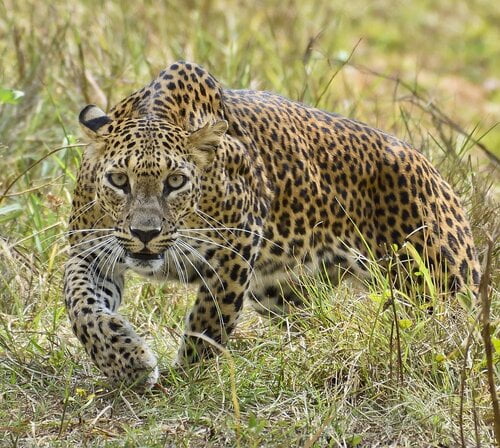
Yala National Park safaris provide a unique opportunity to explore one of the most iconic landmarks in Sri Lanka with the help of dedicated, knowledgeable guides. The safari jeep can carry up to six people and is well suited to make forays across the natural pathways and clearings across the forest. The open-air jeep provides both comfort and safety as it traverses across the grasslands where you can get an up-close look at the flora and fauna that make up the national park. You are free to customize your experience whether you would like to visit for 3 or 4 hours or even spend …
Why Book With Us?
Experienced safari jeep drivers.
We have friendly drivers with good experience
We provide you good condition safari jeeps
Jeeps with front-facing seats for a better view
Free hotel pick-up and drop-off
If you are in a nearby hotel we provide this.
We focus on your needs
Our drivers will support to fulfill your needs in the safari
No hidden charges
We don’t charge any additional fee at the end of the tour.
One of the best experiences I've ever had in my life. Sri Lankan Leopard is the main attraction and we've seen several leopard cubs during our last visit. You must visit. You can have the best experience if you book a full-day safari. Our driver was excellent.
Maciej Diaries
A five-star review simply for being ethical and cruelty-free. However, the place in itself could use a few tweaks of improvement and more wildlife in a larger span of ground, also with more knowledgeable guides
Rubina Rajaratnam
Isn't a topical safari that you do in Africa but still pretty cool. We've seen some elephant plenty of buffalo and lizards some crocodiles and many different birds. Our tour guide as knowledge and attentive.
Slawek Cisowski
Safari Packages
4 hour safari.
Three hours are just enough to see basic animals. But this is not an ideal safari to see more animals and observe
the park well. It’s better to choose a half-day or full-day safari. This is a tour of finding animals in a huge forest. Better to have more time
★ This rate is for the jeep.
Half-day Safari
In a half-day safari in Yala, You will be able to cover a considerable area of the park and will be able to see many
different kinds of wild animals. This safari takes around 6 hours. This is a good safari for photographers.
Full-day Safari
Full-day safari is the ideal safari for wildlife enthusiasts, photographers, and explorers. This safari starts early
in the morning and you can stay the whole day in the National Park. in this safari, you will be able to cover a considerable area of the National Park. We recommend this safari if you are a wildlife enthusiast.
Entrance fee for Yala National park
Sri Lanka National park entrance fees have been increased for local and foreign tourists from the 1st of September 2022 (Gazette Notification No. 2292/11 Aug 2022).
You have to buy tickets before you enter the national park from the entrance gate. These tickets are issued by Wildlife and conservation department. Sometimes the entrance ticket counter is busy. our drivers will support buying tickets.
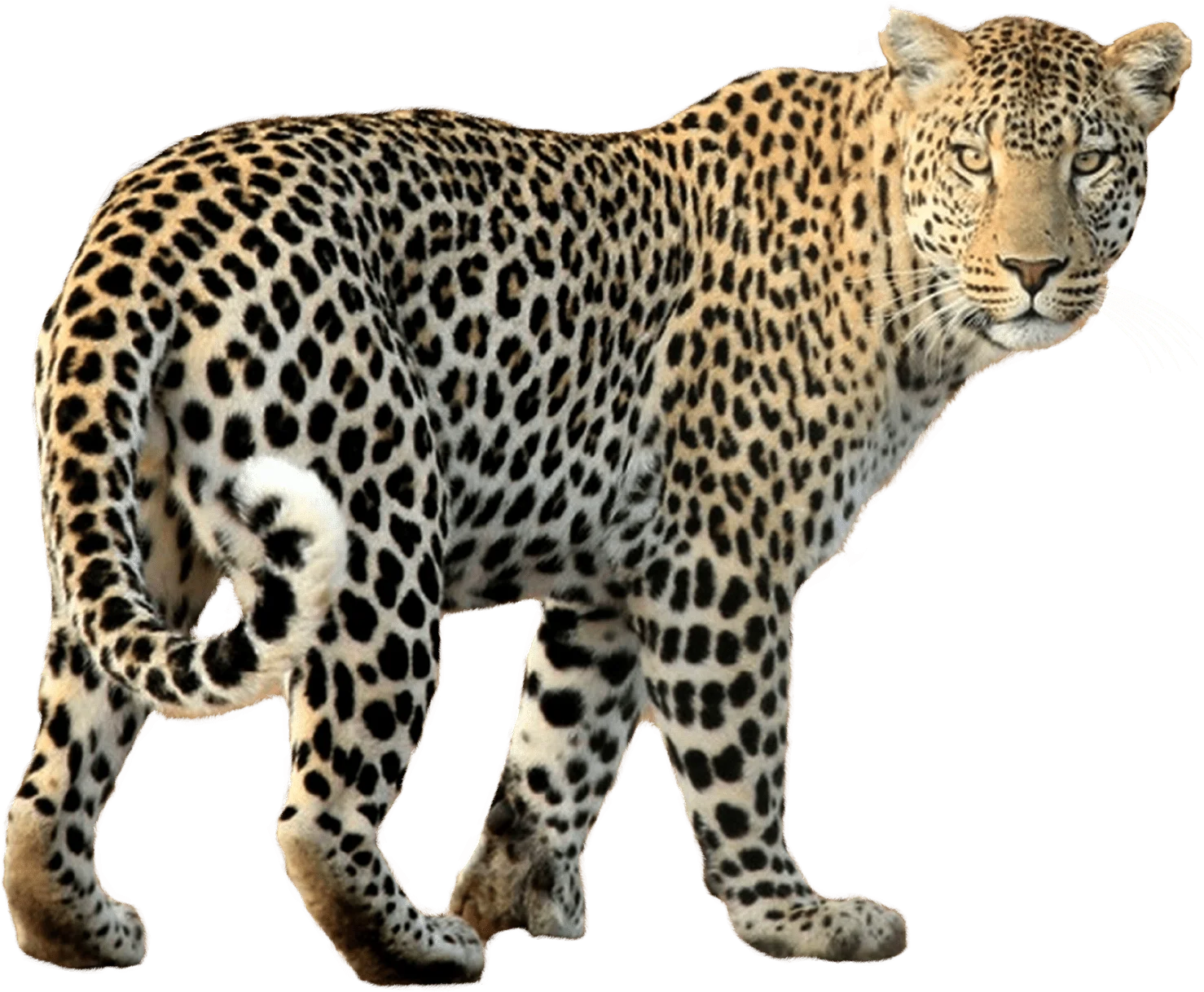
Peak season
Off peak Season
Foreign Adult (12+)
foreign child (6-12), saarc country adult (12+), saarc country child(6-12), local adults (12+), local child (6-12).
All tickets will be added 15% VAT, Service charges, and Other taxes.
* If you stay overnight in the National park this price will be doubled.
Other Things to do
Thissa lake.
You can do a beautiful boat ride here.
Sithulpawwa Rock Temple
Buddhist rock temple.
Weerawila- Thissa Sanctuary
Good place for birding
Kirinda rajamaha viharaya
Beautiful temple beside the beach
Bundala National Park
Good for birding
Hotels in Yala
There are many hotels in Yala and Tissamaharama In between, a few good hotels are below.
Uga Chena Huts
Cinnamon wild yala, leopard nest, jetwing yala, wild culture yala.

- Attractions
Yala National Park and Safari: Ultimate Guide

Yala National Park is a wildlife sanctuary in the southeastern region of Sri Lanka. The park is the second-largest national park in the country for the best Safari experience, spanning over 978.8 square kilometres. It is home to diverse flora and fauna, including Sri Lankan elephants, leopards, sloth bears, and over 200 bird species. The park was first established as a wildlife sanctuary in 1900 and was later declared a national park in 1938. This article will provide an ultimate guide to visiting Yala National Park and Safari.
Flora and Fauna at Yala National Park

It is considered one of the best places in the country for observing and photographing wildlife in its natural habitat. The park spans over 979 square kilometres and is home to many flora and fauna.
Flora: The vegetation in Yala National Park is characterized by dry monsoon forest, thorny scrub, and savannah grasslands. The park has over 215 species, including trees, shrubs, herbs, and grasses. The most common trees found in the park are Satin, Palu, Weera, Ehala, and Kumbuk.
Fauna: Yala National Park is home to a diverse range of wildlife, including 44 species of mammals and 215 species of birds. The park is most famous for its large population of Sri Lankan leopards, considered the highest density of leopards in the world. Visitors to the park can also see Asian elephants, sloth bears, spotted deer, sambar deer, wild boar, water buffalo, and the elusive Sri Lankan leopard.
The park is also a bird watcher’s paradise, with over 215 species of birds recorded within its boundaries. The most common birds found in the park are the Sri Lanka Junglefowl, Sri Lanka Grey Hornbill, Black-capped Bulbul, Indian Peafowl, and the Greater Racket-tailed Drongo.
Visitors can explore the park on safari jeeps accompanied by experienced guides knowledgeable about the park’s wildlife and vegetation. The park has five zones, each offering a different wildlife experience. Visitors can also enjoy camping, bird watching, and nature walks in the park.
However, it’s important to note that many of the species in Yala National Park are endangered due to human-wildlife conflict and habitat destruction. Therefore, visitors should not disturb the wildlife or damage their habitats.
Expect to be seen five main animals at Yala National Park .
Leopards : Yala National Park is famous for its leopard population, and it’s one of the best places in the world to spot these elusive cats. The park has a high density of leopards; visitors can spot them during their safari tours. Leopards are most active during the early morning and late afternoon, making these times the best to go on a safari.
Elephants: Yala National Park is also home to many elephants, and visitors can see herds of them grazing in the park’s grasslands. The park has around 300 to 400 elephants; visitors can spot them during their safari tours. Elephants are most active during the early morning and late afternoon, making these times the best to go on a safari.
Sloth Bears: Yala National Park is among the few places visitors can see sloth bears. The park has a small population of these bears, and visitors can spot them during their safari tours. Sloth bears are most active during the early morning and late afternoon, making these times the best safari.
Water Buffalo: Water buffalo are commonly found in Yala National Park; visitors can see them grazing in the grasslands. The park has a large water buffalo population; visitors can spot them during their safari tours. Water buffalo are most active during the early morning and late afternoon, making these times the best to go on a safari.
Crocodiles: Yala National Park is home to two species of crocodiles: the mugger crocodile and the saltwater crocodile. Visitors can see these crocodiles basking in the sun near the park’s water bodies. The park has a large population of crocodiles, and visitors have a good chance of spotting them during their safari tours.
When to Visit Yala National Park

Yala National Park is a popular tourist destination in Sri Lanka that attracts visitors from all over the world. The park is open throughout the year, but the best time to visit depends on what you want to see and experience.
High Season (December to April): The high season is the best time to visit Yala National Park to spot leopards and other wildlife. During this time, the park’s vegetation is minimal, making it easier to spot animals. In addition, the temperature during this time is pleasant, ranging from 25°C to 30°C, making it comfortable for visitors to explore the park. However, it’s essential to note that the high season is also the busiest time of the year, and the park can get crowded with tourists. Therefore, booking your accommodation and safari tours in advance is advisable to avoid any inconvenience.
Shoulder Season (May to July and September to November): The shoulder season is an excellent time to visit Yala National Park to avoid crowds and experience good wildlife sightings. During this time, the park’s vegetation is thicker, making it a little harder to spot animals. However, the park’s flora is also in full bloom during this time, making it a beautiful sight to behold. The temperature during the shoulder season is slightly higher, ranging from 30°C to 35°C, but it’s still comfortable for visitors to explore the park. It’s also advisable to book your accommodation and safari tours in advance during this time.
Low Season (August): Due to the monsoon season, the low season is the least popular time to visit Yala National Park. In addition, the park is closed for most of August due to heavy rainfall, making it challenging to explore the park. However, the park’s flora is in full bloom during this time, making it a beautiful sight to behold.
The best time to visit Yala National Park depends on what you want to see and experience. If you wish to spot leopards and other wildlife, the high season is the best time to visit. If you want to avoid crowds and still experience good wildlife sightings, the shoulder season is an excellent time to visit. However, despite the heavy rainfall, the low season is the best time to see if you want to share the park’s full bloom.
Getting to Yala National Park

Yala National Park is one of Sri Lanka’s most famous national parks, known for its diverse range of wildlife, including leopards, elephants, and sloth bears. The park is situated in the country’s southeastern region and is easily accessible by various modes of transportation. This article will discuss the different ways of getting to Yala National Park.
By Air: The nearest airport to Yala National Park is the Mattala Rajapaksa International Airport, approximately 45 kilometres away. Several international airlines operate flights to the airport from various destinations, including Dubai, Doha, and Mumbai. In addition, you can hire a taxi or a car from the airport to the park.
By Train: Travelling from Colombo , you can take a train to Matara, the nearest city to Yala National Park. The train journey takes approximately six hours and offers beautiful views of Sri Lanka’s countryside. In addition, you can take a bus or a taxi from Matara to the park.
By Bus: Several buses operate from major cities in Sri Lanka to Tissamaharama, the nearest town to Yala National Park. From Tissamaharama, you can hire a taxi or a jeep to reach the park. The bus journey from Colombo to Tissamaharama takes approximately eight hours.
By Car: If you prefer a more comfortable and convenient mode of transportation, you can hire a car or a taxi to reach Yala National Park. Several car rental companies operate in Sri Lanka, and you can book a car in advance to avoid any last-minute hassle. The journey from Colombo to Yala National Park takes approximately five hours.
Once you reach the park, you can hire a jeep with a driver to explore the park’s various attractions. The entrance fee for foreigners is approximately $30 per person, which includes the cost of the jeep and the driver. You can also hire a private jeep for a more personalized experience, which costs around $50 to $70 for half a day.
Accommodation Options at Yala

Yala National Park is one of the most popular tourist destinations in Sri Lanka, known for its diverse range of wildlife and natural beauty. Several accommodation options are available near the park, from luxury resorts to budget-friendly guesthouses.
Cinnamon Wild Yala : Cinnamon Wild Yala is a luxury resort on the edge of Yala National Park. The resort offers comfortable accommodations, including treehouses, chalets, and bungalows. The resort’s facilities include a swimming pool, spa, restaurant, and bar. Cinnamon Wild Yala is the perfect place to stay for those looking for a luxurious experience. Book Now
Jetwing Yala : Jetwing Yala is another luxury resort near Yala National Park. The resort offers comfortable accommodations, including deluxe rooms, suites, and villas. The resort’s facilities include a swimming pool, spa, restaurant, and bar. Jetwing Yala is the perfect place to stay for those looking for a luxurious experience. Book Now
Taru Villas – The Yala Lodge : Taru Villas -The Yala Lodge is a mid-range resort near Yala National Park. The resort offers comfortable accommodations, including chalets, villas, and deluxe rooms. The resort’s facilities include a swimming pool, restaurant, and bar. Taru Villas – The Yala Lodge is the perfect place to stay for comfortable accommodation at an affordable price. Book Now
Elephant Reach Hotel : Elephant Reach Hotel is a budget-friendly hotel located near Yala National Park. The hotel offers comfortable accommodations, including standard rooms and deluxe rooms. In addition, the hotel’s facilities include a swimming pool, restaurant, and bar. Elephant Reach Hotel is the perfect place to stay for those looking for affordable accommodation. Book Now
Camping: For those looking for a unique experience, camping is also an option at Yala National Park. Several camping sites are available near the park, offering a chance to sleep under the stars and experience the park’s wildlife up close.
Things to Do in Yala National Park and surrounding Areas

Yala National Park is one of the most popular tourist destinations in Sri Lanka, known for its diverse range of wildlife and natural beauty. In addition to wildlife safaris, there are several other things to do in and around Yala National Park.
Wildlife Safaris: Wildlife safaris are the main attraction of Yala National Park. Visitors can book a safari tour with a guide and explore the park’s grasslands, forests, and water bodies. The park has various animals, including leopards, elephants, sloth bears, water buffalo, crocodiles, and many more. Safari tours are available early morning and late afternoon, making it the best time to spot animals.
Visit Kataragama Temple: Kataragama Temple is a popular pilgrimage site for Buddhists, Hindus, and Muslims. The temple is located near Yala National Park and is dedicated to Lord Kataragama. Visitors can explore the temple’s beautiful architecture and learn about its cultural and religious significance.
Visit Sithulpawwa Temple: Sithulpawwa Temple is an ancient temple in Yala National Park’s outskirts. The temple dates back to the 2nd century BC and is known for its ancient rock inscriptions and beautiful architecture. Visitors can explore the temple’s ruins and learn about its historical significance.
Visit Yala Village: Yala Village is a small village near Yala National Park. The town is known for its handicrafts, including woodcarvings and woven products. Visitors can explore the village’s markets and purchase souvenirs to take back home.
Tissamaharama Temple: also known as Tissamaharama Raja Maha Vihara, is a Buddhist temple in the town of Tissamaharama in southern Sri Lanka. The temple is believed to have been built in the 2nd century BC by King Kavantissa, a prominent ruler of the region. It is one of the most important historical and religious sites in Sri Lanka. The temple is famous for its stupa, which is one of the largest stupas in Sri Lanka. The stupa , which is over 55 meters tall, is believed to contain relics of Lord Buddha.
Visit Bundala National Park: Bundala National Park is another famous national park near Yala National Park. The park is known for its birdwatching opportunities and is home to over 200 species of birds. In addition, visitors can explore the park’s wetlands and water bodies and spot various bird species. Explore Bundala
Relax on the Beach: Yala National Park is located near the South coast of Sri Lanka , and visitors can relax on the beautiful beaches of Tangalle and Mirissa. The beaches are known for their soft sand, crystal-clear waters, and beautiful sunsets.
Suggested read: Wipattu National Parks & safari Guide
Leave a Reply Cancel reply
Your email address will not be published. Required fields are marked *
Save my name, email, and website in this browser for the next time I comment.
Latest Articles
- 39 Places to Visit in Ella and Surrounding Areas
- Best Places to Visit in Weligama
- Fox Hill Supercross 2024
- International Industry Expo 2024: Sri Lanka
- Best Budget Accommodations in Galle
Our Categories
- Accommodations
- Travel News and Statistics
- Trips & Itineraries
- Uncategorized
Copyright © 2024 Sri Lanka Travel Pages . Developed by Traventy Australia Pty Ltd | About Us | Contact Us | Privacy Policy | Terms & Condition
Proudly powered by Traventy
- Add a Place
- Create account
Lost your password?
Please enter your email address. You will receive a link to create a new password via email.
Send Message
My favorites.

Yala National Park Safari, Sri Lanka
Some of the best, greatest national parks you could experience for rare wildlife (think tigers, elephants, and rhino's) can be found in India. Yet, were you to turn your glare to Sri Lanka you'd be delighted just as to discover Yala National Park. The park takes pride of place in Sri Lanka and our complete travel guide focuses on this one park and what you can get from it for your holiday vacation.
Like those parks in India, there are safaris that are guided tours to ensure you get maximum pleasure and act responsibly, and stay safe ― because these are dangerous animals. And Sri Lanka has crocodiles that are loose. They're wild and untamed. But don't be scared off, because a safari is a once in a lifetime experience that shouldn't, and can't, miss out on.
Be that as it may, on the African subcontinent, India or Sri Lanka, a safari is the same nonetheless:
- the buildup of excitement and anticipation of seeing a wild animal in its natural habitat
- the thrill of a chase, keeping sight of a rare beast as it seeks shelter from attention
Experiencing a herd of elephants pass by your vehicle ― as close as a dozen yards off ― is a lifelong memorable experience, in anyone's view. That beats any zoo, any day.
Popular National Parks in India
If Sri Lanka interests you with the wildlife, we feel maybe India's topmost popular national parks for wildlife would also interest you? Go on safari in one of India's national parks for sightings of the rare Royal Bengal Tiger, White Horned Rhinoceros and herds of elephants. Book in advance to guarantee your accommodation within the national park, so you are going on your safari fully refreshed without the travel beforehand.
- 5 Best National Parks for Wildlife in India
Yala National Park Ticket Price
You should budget US$15 for the entrance ticket, per person. With many tour packages and Yala National Park itineraries, the entrance fee may be included, but not always so check to avoid surprises. Depending on the time of year, also expect to be charged a little more, may a few dollars more for a ticket: prices fluctuate it seams. Without any doubt you will want to hire a jeep, if you have no tour itinerary, so include another US$20 for the jeep.
However, it greatly depends on the number of people going along in the jeep. The more people, the cheaper the hire is, with each jeep maybe carrying up to 5 people at a time.
Getting to Yala National Park

Getting to the park is relatively easy enough. You can hire private transport from Kataragama City , which is less than an hour away. The best time to visit the park safari is between June and September, be sure to prepare yourself for the tour by taking with you:
- a pair of binoculars
- a camera with a decent zoom lens
- sunscreen and insect or mosquito repellent
Wear loose-fitting clothing, sunglasses and a hat to protect your face from the sun. A pair of sturdy boots, not sandals, for when walking around. As stated earlier, wildlife in the park can be dangerous but don't worry because the park wardens won't take you too close to the animals. Which is why you need a zoom lens as you'll grab a photo from a distance. The better the lens then the sharper the picture.
You may also need a certain level of patience and perseverance, as animal behavior doesn't always perform to human needs and wishes. But in saying that, every park is different and it does depend on the season.
As with all national parks, including those in India, there are multiple access points or gates. The entrance closest to the city of Kataragama is Galge.
Yala National Park Accommodation
The choice is yours. You can stay in Kataragama City, but travel for a day safari, or you can stay in or near to the park. A lot of the guided tours last anywhere between 4 hours (a half day tour) to 12 hours. It's our recommendation that a 6-hour tour is sufficient to see enough of the wildlife to make it worthwhile your time to visit. Either go for a safari in the morning or afternoon. An afternoon safari is ideal when holidaying very late in the year, (December) through to spring.
Some of you may feel it necessary for a one-night, two-day package. In which case there are glamping and tented camps, ideal as they let the air circulate more freely in any breeze.
Wildlife in Yala National Park

There are a myriad of different animal and bird species scattered all over the park. It's the job of your tour guides to show you as many different animals and birds as possible. All you must do is be alert, be ready with your camera and have your finger on the button.
Sri Lanka Monsoon Seasons
You are blessed with Sri Lanka having a variable monsoon season but stable tropical temperatures, averaging in the low 80's Fahrenheit year-round. There is one monsoon lasting from May until August, and the second one arrives in September to hang around until March. Regardless of when you visit during a monsoon, it'll be hot. Expect to feel the worst of the monsoon during the month of November with the heaviest rainfall.
The wildlife you may catch a glimpse of includes (but not limited to):
- the Sri Lankan leopard
- the sloth bears
- the Sri Lankan elephant
- reptiles and water buffalo
- macaque monkeys
There can be up to 90 different bird species in the park at any one time with many of them being migratory. Every season brings in different species therefore. It really is a proper safari, no doubt about it:
- elephants enjoy bathing in the water pools, creating mud by doing so
- deer huddle close in herds as they continuously move to greener grass
- kingfishers can be seen perched on branches
- antelopes look on in suspicion from the distance, whilst crocodiles sleep off a recent meal
The park is lively and vibrant, as butterflies flutter around and you are joyous of the birdsong. Peacocks spread their feathers to your amazement. Every time you see a leopard or an elephant, your heartbeat races ahead of itself, as do your emotions. It's nothing like what it feels like being at a zoo, far from it. That's because the animals are free of any containment.
The animals can please themselves with what they do, they must not pander to human needs. And that's the reward ― and perhaps why safaris are becoming far more popular?
Patanangala Beach

As the park falls to the southeast of the Island, with a coastline, there is of course a beach. The natural surroundings are 190km distant from the Island capital of Colombo , and only 10km from Kataragama City. Even were you not interested in the park (we can't think why ever not) at least there is a decent beach close by. Chances are you'll want to come back to the beach the following day, before moving on from Kataragama. Do make allowances for this.
By the way, the beach and surrounding coastline were deeply impacted by the 2004 Christmas tsunami. A memorial was built and can be found near to the beach.
Yala Safari
One concern for many on holiday interested in wildlife and nature is their worry about not seeing a prized animal in the wild. Usually this is a tiger or rhino, when it comes to Africa and India, more so than a Sri Lankan safari. There is no need to be concerned, or alarmed, that you may go home empty handed. That's another reason why we suggest you book a 6-hour guided tour as a minimum: a 4-hour tour is, we feel, too short.
On an African safari the big five are a must-see event, the lion , elephant , rhinoceros , buffalo and leopard . Well, Sri Lanka has its own big five too, namely: the elephant, leopard, sloth bear, blue and sperm whales. You can catch sight of migrating blue and sperm whales from the southern coast off Sri Lanka, between December and April.
Udawalawe National Park

Other popular national parks in Sri Lanka are Wilpattu National Park, Udawalawe National Park (another favorite of ours), Minneriya National Park and Kaudulla National Park. Udawalawe National Park has some of the largest elephant herds on the Sri Lankan Island. If being around these gentle giants enthralls you, then most definitely take a day trip to Udawalawe. It's seeing the "little ones" running around that most people go weak at the knees for, the baby elephants are cute and super silly in their actions, there's unlimited fun.
Final Thoughts
With green forests, sandy beaches, muddy roads, verdant grasslands and so many varied fauna and flora, it's no wonder this is Sri Lanka's most popular national park. As your safari takes you through the trails, you can exit your vehicle to sit by a riverbank for breakfast (because your tour begins long before sunrise), rest or stretch your legs before resuming the tour.
It's a beautiful sight seeing the sunrise, finally, over the park and you see a different side to the animals too, for their behavior changes. Most of your enjoyment and pleasure will arise from sightseeing but part of the whole package experience is the landscape, the waiting in anticipation and drama about what the animals will do next. If you love animals and wildlife, then you'll love going on a Sri Lankan safari.
PREVIOUS GUIDE
Latest Guides
Sri lanka travel in april: 5 best places to amaze you, 10 most visited attractions in colombo, 5 reasons for trekking in sri lanka, 10 best beaches for a holiday, sri lanka.
- Terms of Use
- Privacy Policy
Newsletter Sign Up
Get bi-weekly travel inspiration to your inbox, tropical islands.
- Best Summer Guide to Bohol Island, for a Wonderful Holiday
- Summer Holiday Guide to Koh Rong Samloem Island
- Summer Holiday Guide to Langkawi Island
- 3 Reasons Why Travel to Raja Ampat Islands
- Summer Holiday Guide to Jeju Island
- Lombok Island, Indonesia for Holiday
- Holiday Guide to Boracay Island
- Summer Holiday Guide to Bali Island
- Summer Holiday Guide to Palawan Island
Budget Friendly
- 5 Inexpensive Destinations to Indonesia for an Amazing Time
- Hypnotic Ooty Hill Station, India for an Amazing Holiday
- 5 Unmissable Low Budget Destinations in India You'll be Thrilled
- The Best Attractions in Kolkata, India That Feel Amazing
- The Best Attractions in Mumbai, India That Feel Amazing
- The Best Attractions in Kampot, Cambodia That Feel Amazing
- Why India's Monsoon Season, is Excellent Time for Holidays
- Solo Travelers: Cao Bang, Vietnam is Best for Amazing Holidays
- Solo Travelers: The Best Backpacking in Cambodia for Thrills

The Best Sri Lanka Safari: Minneriya, Udawalawe or Yala
This post is a travel guide about the best Sri Lanka safari destinations and whether you should choose to visit Minneriya, Udawalawe or Yala National Park for your Sri Lanka safari.
A safari in Sri Lanka is a unique wildlife-watching experience. The most popular safari destinations in Sri Lanka are Yala and Udawalawe National Parks, but there are also several other parks and reserves that offer safari experiences, such as Minneriya, Wilpattu, and Kaudulla.
They are among the best places to go on a Sri Lanka safari and each national park in Sri Lanka has its own unique features. Whether you should visit Minneriya, Udawalawe or Yala depends on what you are looking for.
Why go on a Sri Lanka safari?
If you think about going on a safari, you probably think about Africa. Sri Lanka is more famous for its beaches and tea plantations, not so much for its wildlife. Therefore most people are surprised to hear that there are some incredible national parks in Sri Lanka that make it a great budget safari destination.
I love wildlife and I did read about Sri Lanka’s incredible nature. It was one of the reasons why I choose to go to, but even I did not expect to see the variety and amount of wildlife I ended up seeing in Minneriya, Udawalawe and Yala.
Sri Lanka is, for example, the best place to spot leopards in the world and seeing one was definetly the highlight of my trip. Then you have the Asian elephant, deers, langur monkeys, pea cocks and a large variety of bird species, including my favourite Great Hornbill .
Compared to Africa, going on a safari in Sri Lanka, is relatively cheap and therefore I was able to include all three major parks: Minneriya, Udawalawe and Yala. However, if you don’t have time to visit all three, I hope this guide will help you to choose whether to visit Minneriya, Udawalawe or Yala for your Sri Lanka safari.
What is a Sri Lanka safari like?
A typical safari in Sri Lanka includes a guided tour of the park in a specially-designed vehicle, such as a jeep or a land rover. The tour is led by a local guide who is knowledgeable about the park’s wildlife and the best places to spot them.
Most tour operators offer early morning safari’s or late afternoon safaris that last between 2 to 3 hours. This is when animals are the most active and you have the best chance to see them. Some safaris offer full-day tours, which include lunch and a break in between the morning and evening safari.
Where to go on a Sri Lanka safari
Udawalawe national park.
We had to get up early for our safari in Udawalawe National Park. It was still dark and cold when we were on our way to the entrance. However, once we entered Udawalawe, the sun was rising and all the birds came to life. The scenery was beautiful and soon we also saw our first female elephant.
The elephant slowly walked towards us and stood still in front of our jeep, quietly watching us. After 10 minutes our driver decided to move on, but as soon as we started our jeep the elephant got angry. We could do nothing else, but wait till the elephant moved.
The elephant did not move, instead another male elephant came to show his interest in her. Slowly touching her with his trunk they stood together for quite a while. The female clearly enjoyed all this attention, both from the male elephant and from us. When the male finally left, it seemed she made some goodbye picture poses for us, before leaving in the direction of the male elephant.
It was in fact Valentine’s day today and it wasn’t the last courtship ritual we saw on our safari. We also encountered a peacock displaying its beautiful feathers trying to impress a female peacock. Later we encountered another group of elephant with baby’s, but nothing could beat the early morning tender courtship experience.
At Erica’s travels you can read more about her experience in Uda Walawe National Park .
Logistics Udawalawe National Park
Base town: Udawalawe or Embilipitiya.
Logistics : Udawalawe is located about 200 km southeast of Colombo and is easily accessible by car or bus. It’s also closer to the popular southern beach towns of Mirissa and Unawatuna . I took a bus from Ella to Wellawaya and got out at Thanmalwila junction. From there you can either take a tuk tuk or another bus to Embilipitiya (90 minutes)
Accomodation : You can stay in the Max Safari Villa or the Green View Safari resort
Time to visit : During the dry season from May to October and in February/March
Wildlife peak times : early morning (5-8 AM) or late afternoon (5-7 PM)
Animals spotted : Elephants, peacock, hornbills, eagles, wild buffalo, wild foxes, monitor lizard, deer
Pro’s and cons : in this nationmal park you will have a good chance of seeing a variety of wildlife. It is also relatively quiet and you will not encounter a lot of other jeeps.
Entrance fees : 3300 per person, 250 rupees per vehicle.
Yala National Park
And all of a sudden there it was. A leopard crossed the road right in front of our jeep. It looked at us and disappeared in the bushes again.
I couldn’t believe that I saw a leopard at that moment. We had just entered Yala National Park and we were still waiting in a long line of jeeps on a dirt road when this leopard showed up.
Before the leopard, I was slightly discouraged about our safari. We woke up at 3 am to reach as early as possible at the entrance of the park. Once we arrived, there must have been at least 100 jeeps waiting in line. For more than half an hour we were waiting in the dark, before we could finally proceed, just as the sun started to rise.
We were very lucky with the leopard crossing the road only a meter in front of us. It was the only leopard we saw, but we did see many other animals after that.
Yala on the Southern Coast of Sri Lanka is the most touristic National parks in Sri Lanka and every day there is a high number of jeeps getting in. The jeeps dispersed throughout the park trying to avoid each other as much as possible, but at the same time informing each other about the whereabouts of the animals.
As soon as one jeep spotted some elephants, other jeeps followed. We joined a group that had surrounded a mother elephant with her child. The child was very curious and approached one of the jeeps. It went with his trunk inside, looking for food. When it didn’t find any, the elephant broke one of the side mirrors.
Not sure what to do with the mirror, the elephant threw it on the floor and started kicking around with it as if it was a football. It was a joy to see this elephant playing, but I am sure the jeep owner was less pleased.
I also had mixed feelings about this situation. Even tough the elephants didn’t seem to mind us coming so close to them, we were clearly disturbing their natural behaviours. I can see that if tourism is increasing further in Yala, this becomes even a bigger problem. In hindsight I wished I would have said something about this to our jeep driver
Logistics Yala National Park
Base town: Tissamaharama or Kirinda.
Logistics : There are frequent buses to Tissamaharama from Galle (5 hours), Ella (4 hours) or Tangalle (3 hours)
Accomodation : Tissamaharama Safari Inn
Time to visit : The dry season from May to August, the park closes for six weeks in September and the beginning of October
Animals seen : Elephants, peacock, eagles, wild buffalo, mongoose, monitor lizard, deer, crocodile, langur monkeys, macaque monkeys
Pro’s and cons : This park is the best national park in Sri Lanka to spot leopards and bears. It also had the most beautiful scenery and the biggest variety in wildlife I saw, but it is also crowded. Expect to see more other jeeps than animals.
Minneriya National Park
Nothing feels like the excitement and thrill of seeing a wild elephant up close. Our jeep driver points out the dark back of an elephant behind the tall grass. He drives closer and soon we see it is not just one elephant, but a herd with several baby elephants. Minneriya National Park has one of the largest populations of elephants in Sri Lanka.
Every year around august they gather all together in Minneriya National Park . The rest of the year they actually wander around into neighbouring parks unaware about the manmade borders. They are wild elephants, but quite used to visitors in their habitat.
Due to conservation efforts the elephants are well protected and are not scared of people. With the jeeps you can get pretty close to them and the elephants will simply continue with whatever they are doing.
Logistics Minneriya National Park
Base town: Habarana, arrange safari’s through your hotel or independently by arranging your own jeep (slightly cheaper, expect 3000 rupees for a jeep).
Logistics : Habarana is 30 minutes from Dambulla by bus, or 5-6 hours from Colombo.
Accomodation : The nearest town is Habarana with a great number of resorts like the Priyavimana resort .
Time to visit : August for the gathering, The dry season from May to September
Wildlife peak times : late afternoon is when the elephants come out and are most active. During the day they are hiding in the shadow.
Animals seen : Elephants, peacock and birds
Pro’s and cons : This park is easily accessible if you visit the cultural triangle of Sri Lanka . The biggest draw are the elephants, but due to the high grass, chances of seeing other wildlife are rather small
Note : Be aware that there are actually 3 different national parks in this area. Minneriya, Kaudulla and Hurullu. There is just one herd of elephants tough and they do not know anything about park borders. The jeep drivers are quite aware of where the elephants are and will bring you to the right park. If for some reason you specifically want to visit Minneriya, because of other wildlife you want to see be clear about this.
Entrance fees :
Minneriya: 3300 per person, 250 rupees per vehicle.
Hurullu Eco park: 1000 per person, 750 per vehicle
Kaudulla: 1500 per person, 125 per vehicle
Minneriya, Udawalawe or Yala?
For those we do not have the time or money to visit all national parks in Sri Lanka I will try to make a recommendation whether to visit Minneriya, Uda Walawe or Yala for your Sri Lanka safari.
If you have to skip one national park in Sri Lanka I would suggest Minneriya. Except when you happen to be there in August. Watching the largest elephant gathering in Asia is of course something you should not miss.
Minneriya is mostly about elephants tough. Because of the high grass it is hard to spot other wildlife and the scenery is less beautiful than in Udawalawe or Yala.
Udawalawe or Yala National Park
So the question remains whether to visit Udawalawe or Yala. Both parks offer a beautiful scenery almost resembling the African savannah and both offer a variety of wildlife to spot.
Yala is known for its high leopard density, as well as its large elephant and bear populations. Udawalawe, on the other hand, is known for its large herds of elephants and also provides a great opportunity to see water buffalo, crocodiles, and a variety of bird species.
In my opinion Yala is slightly more beautiful and there is a better chance to spot the leopard or a bear. But Yala is also very crowded, making the overall experience in Udawalawe more pleasant.
Sri Lanka safari tips
When to go on a sri lanka safari.
For Udawalawe and Yala the best time to go on a Sri Lanka safari is in the dry season between May and October/November and the months of February and March. This is when the animals congregate around water sources and are easier to spot. During peak season the parks can get crowded, especially Yala.
The northeast monsoon from December to February can bring rain to Udawalawe and Yala National Park. The lush greenery makes it more difficult to spot wildlife, but the parks are more quiet. Another important thing to know is that Yala National Park closes for six weeks in September and the beginning of October.
Minneriya is in a different climate zone. The dry season in Minneriya runs from May to September when hundreds of elephants gather around the Minneriya Tank to drink and bathe, creating an unforgettable experience for visitors. August is considered the best month in Minneriya to see the biggest elephant gathering in Asia.
Sustainable Sri Lanka safari’s
Tourism is increasing in the National Parks of Sri Lanka. Although this is a welcome source if income, mass tourism also brings pollution and other problems. Traveling sustainably on a Sri Lanka safari is essential to minimize your environmental impact.
Safari’s in Sri Lanka are not well regulated at the moment. As a result, tour operators might not follow the proper guidelines. Think about having too many jeeps in the park, jeeps getting too close to the elephants, littering and going off the tracks to chase animals.
Choose a responsible Tour operator : It will be difficult to know if your tour operator is a sustainable choice. However, it is good to ask some questions beforehand. Also during the safari it is up to you to discuss any unethical behaviour from your guide. Let your driver know that you feel uncomfortable getting too close to the animals or chasing them down.
Support the local community : You can support the community by purchasing goods and services from local vendors. It is better to try Sri Lankan Cuisine that uses local ingredients rather than imported foreign foods. Sri Lankan food is vegetarian friendly and it is very easy to follow a vegetarian or vegan diet.
Stay in small scale sustainable hotels : It is also better to stay in locally-owned guesthouses or homestays to support the local economy directly. These accommodations often have a more positive impact on the environment compared to large hotels.
You can try to look for guesthouses or homestays that prioritizes sustainable practices. That said, environmental awareness is still low. It’s up to you to use water sparsely, turn off lights and air conditioning when leaving your accommodation.
Leave no trace principle : I encourage you to take all your trash back with you when you go on a safari in Sri Lanka’s beautiful nature and dispose of it responsibly. In other words, leave no trace of your visit. Even better is when you bring something to pick up any of the trash that other people left behind.
To avoid single-use plastics, invest in reusable items. For example, you can bring your own water bottle with a filter. At last, use biodegradable and eco-friendly personal care products to minimize pollution of water sources.
Disclaimer : This post about the best national parks in Sri Lanka and whether to choose Minneriya, Udawalawe or Yala for your Sri Lanka safari contains affiliate links. If you buy any service through any of my links, I will get a small commission at no extra cost to you. These earnings help me to keep Backpack Adventures alive! Thanks for your support!

14 thoughts on “The Best Sri Lanka Safari: Minneriya, Udawalawe or Yala”
- Pingback: Top 10 things to do in Sri Lanka | Backpack Adventures
so nice pics!
Great post. I absolutely Loveeeeee Sri Lanka 😊
Wow it’s so easy to spot wildlife in Sri Lanka, I had no idea! I would love a safari there, thank you for all the useful info!
Thank you for all of this info!! Sri Lanka is so high on my must visit list!! Your pictures are amazing too! 🙂
Awesome! I didn’t know Sri Lanka had so much wildlife! I’d love seeing elephants in the wild one day. We did visit an elephant sanctuary in Chiang Mai, Thailand, but that’s not the same as spotting them in the wild. So cool you saw a peacock spreading its feathers as well 😀 Pinned for when we make it to Sri Lanka one day. 😉
Beautiful photos! Very thorough and informative post. thank you!
Thanks for this detailed info. We’re heading to Sri Lanka later this year so this is great inspiration 🙂
Thank you for this post! We love Sri Lanka and can’t wait to return! We had no clue you could go on safaris there, otherwise we definitely would’ve gone on our last trip! Great tips!
Really enjoyed reading about the mating rituals, especially the peacocks. We had a male peacock follow us in a park in Porto and open his tail, not sure if he was just showing off or trying to mate with us haha. I really like that you have mentioned the costs for those who plan on visiting soon.
Great post, my absolute favourite was Yala, so amazing seeing the leopards! However, I also loved Minneriya BUT we did see herds of elephants with their babies which was something I’d never seen before. I’d only seen solo elephants or groups of 2 – 4 before in India before!
How sweet that you saw courtship rituals of elephants and peacocks on Valentine’s Day! Love your photos, especially the close-ups of the birds and the mother and baby elephant. I’ve always wanted to do a photo safari like this – thank you for the pros and cons of the different parks.
Such a great post! Brought back fabulous memories as I have also been to the 3 amazing parks. Way too hard to choose a favourite. We also had a leopard cross right in front of the jeep in Yala. I will never forget that gorgeous muscular body. What a thrill. Just love Sri Lanka and everything it has to offer.
Very thorough and insightful tips! If you love Sri Lanka then you’re gonna love India! I am so happy that I found your blog; it’s fabulous! I’ll be sure to give your blog and read through and connect via social media.
Leave a Reply Cancel reply
Your email address will not be published. Required fields are marked *
- Kale by LyraThemes.com.
- Search Search Search …
- Search Search …

How to Take a Yala National Park Safari
Taking a Yala National Park Safari is the reason that we went back to Sri Lanka for our second month long trip. We’d been here a few years back, and had a glorious, if very, very wet month, and didn’t get to Yala (there was a lot of flooding) so we made it this year. Yala National Park is the most popular National Park in Sri Lanka, primarily because it’s the number one place to see leopards in Sri Lanka. But there’s a lot more wildlife here in Yala than just leopards, as we came to find out. Here’s our guide to taking a Yala National Park Safari, which we’ve now planned twice!
THIS POST MAY CONTAIN COMPENSATED AND AFFILIATE LINKS MORE INFORMATION IN OUR DISCLAIMER
Where is Yala National Park?
Yala National Park is in the south-east of Sri Lanka, adjoining the stunning Indian Ocean. The National Park is one of 26 National Parks in the country, which cover a total of 5,734 square kilometers (2,214 square miles). The park straddles two of Sri Lanka’s provinces, Hambantota and Monaragala.
Yala is the second largest National Park in Sri Lanka, after Wilpattu National Park. Yala is about 6 hours’ travel or 260 kilometers (161 miles) from Sri Lanka’s capital city of Colombo. We traveled from Galle to Yala National Park, that journey is 190 kilometers (118 miles) and it took about 3 hours using the Expressway to drive to Yala from Galle.
EASIEST WAY TO VISIT

Full Day Private Yala Safari
This is a superb way to see Yala National Park, a full-day safari in your own private safari jeep, with lunch and a driver provided
How to Get to Yala National Park
If you search for Yala on a map it’s quite hard to figure out exactly where you have to get to to take a Yala National Park Safari. Let’s make it really simple.
The absolute easiest way to get to Yala National Park is to take a tour. You can do this from Colombo, you can take a Yala National Park Safari from Ella, you can take a safari in Yala from Galle or you can take a safari in Yala from Tissamaharama. These are long days, but it’s a truly fabulous experience, and the transport is also comfortable. Here are the best tours to Yala
This tour from Ella includes a safari in Yala and Udawalawe too + lunch
If you’re staying in Tissamaharama , then this full-day private safari gets superb reviews.
You can visit Yala from Galle and also combine a safari to Udawalawe too
We chose to travel from Galle to Tissamaharama and stay in the town for two nights. We stayed at the fabulous value Nehansa Resort and arranged our National Park Safari via our accommodation. I wouldn’t say it was a resort as such, but we had a great room, the food was excellent, and it seemed like there were several members of staff all on hand at the same time. The tour they arranged for us was excellent.
Our guide on how to go from Galle to Yalla National Park is here.

We planned to stay in Tissamaharama until we’d spent at least one full day in Yala, possibly longer if we didn’t see a leopard on that day.
While there are several entrances to the park, the entrance most used is via the town of Tissamaharama. It’s about 40 kilometers (25 miles) from Tissamaharama to the entrance of Yala and all Yala National Park Safari tours will pick you up from your hotel and take you into the park. The further away you stay from the park, the earlier your pick-up.
To get to Yala National Park you need to transfer to Tissamaharama.
Galle to Yala
You can take the slow local bus along the coast from Galle to Yala, but it will take you about 5 hours. We traveled from Galle to Tissamaharama and it took 3 hours in a taxi, that we booked through the PickMe app. You can make good use of your time in Sri Lanka and combine a visit from Galle to Yala and Udawalawe in a full day tour.
Ella to Yala
We left Tissamaharama and traveled to Ella. There are currently no direct buses for this route, so rather than spend the entire day on several buses we took a taxi from Tissamaharama to Ella. You can use the PickMe app in Sri Lanka to get an idea as to how much a taxi or a tuk-tuk should be. Alternatively, you can maximize your time and take a Yala Safar from Ella and return back to Ella
Mirissa to Yala
You can take a bus from Mirissa via Matara to Tissamaharama. It takes about 3.5 hours. A bus still costs around 350 LKR.
Animals to see in Yala National Park
Yala National Park covers a variety of different landscapes – there’s jungle here, grasslands, lagoons, coastline, lagoons and lakes.

This means it provides a habitat for a variety of different mammals and birds. There are 44 species of mammals and 215 species of birds that call Yala home, plus 46 species of reptiles.

Just because the animals live here doesn’t mean that you’ll see them though, although it’s pretty safe to say that you’ll see peacocks, water buffalo, spotted deer, and monkeys. You’re also highly likely to see elephants at Yala.

Leopards, the animal that Yala is famous for are more elusive,
Leopards in Yala National Park
Usually the most asked question is “How many Leopards are in Yala National Park?” The answer, of course, is mostly irrelevant. As the answer that you’re interested in is if you’ll see a leopard in Yala National Park.
So here’s the situation on Yala National Park leopards. Yala has the biggest concentration of leopards in Sri Lanka. Yala isn’t fenced. So they may or may not be there. There are usually around 55 leopards in and around the park area. However, leopards are elusive. They’re most likely to appear at the beginning or the end of the day. Leopards are both solitary and territorial, so you’re not going to see a big pack of leopards, but they usually go back to the same places. That’s why the safari guides and drivers will gravitate to the same places to spot leopards.
Elephants in Yala National Park
The elephant herd of Yala National Park numbers between 300 and 350 animals. However, while this seems like a large number Yala is also a large park. Depending on the time of year you may or may not see elephants. We saw several, all individuals, no herds. And all in different places in Yala.

Other Animals in Yala National Park
It feels a little mean to group all the other animals – the 44 species of mammals into “other animals” in Yala National Park. You’ll see deer here, and crocodiles, water buffaloes for sure.

You may or may not see the Black Sri Lanka Sloth bear (they’re elusive too). However. Most people are coming to Yala to see the leopard and elephants.
If you’ve taken a guide or have a great driver (we did), then they’ll point things out to you. They’ll also have a book on animal and birdlife. We saw lots of birdlife in Yala National Park
BirdLife to see in Yala National Park
For me, the fact that our driver, who spoke some English, but not a huge amount, had a book of Sri Lankan birds made all the difference. Many of the birds were incredibly pretty, however many were also very small and very fast in flight. Also, many looked very similar, so having the book made a huge difference in identifying them. There are 215 species of bird life in Yala. That’s a lot to know about!
Yala National Park Entrances
There are 5 blocks or zones to Yala National Park, and you’ll get to visit one if you take a half-day trip. Two (possibly) if you take a full-day trip, although a full day trip is a bit of a misnomer. Everyone, you, your driver, and the animals need a break, and so if you take a full day Yala Safari what actually happens is that you simply stop somewhere for your lunch, for a very long lunch. It’s during the hottest part of the day, so your chances of seeing animals are pretty limited anyway.
And so while Yala National Park has 5 zones, and entrances to each of them, unless you’re hanging around and visiting Yala for multiple consecutive days, then you likely won’t have much of a choice on the zone that you visit. You may not even know which zone you’re in. Relax, don’t worry about it, and let your driver and guide point things out. It’s very like when we went on a Tiger Safari in Ranthambore National Park in India, we *really, really* wanted to go to a certain zone, because we’d read that it was THE zone where all the Tigers went. In the end, we just relaxed, went with the flow, and saw some amazing tigers.
The entrance to Yala is about 40 kilometers from Tissamaharama and what time you go through the entrance depends on how far away your hotel or camp is from the entrance, as well as if you choose a morning or an afternoon safari, and also if you’re taking a private or a shared safari.
Private Yala National Park Safari or Shared
Unless you are traveling on a severe budget, then I would definitely go for a private safari. Why? You’ll get all the seats in the jeep to yourself, which means you can slide around getting into the best possible place to avoid the sun/rain/weather and the best possible place to see the wildlife, instead of having to climb over someone else.
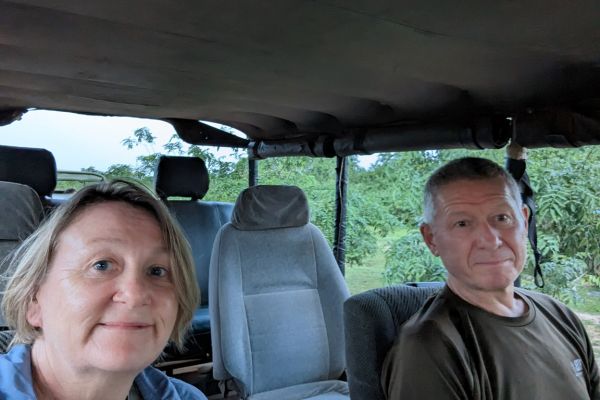
This is probably going to be the most budget-friendly place in the world for taking a private safari. And no, it’s not expensive. We paid US$148 for a private full day Yala National Park Safari including lunch. I’ll touch on that later, but it was well worth it.
Travel Tips for Exploring Sri Lanka
- Considering travel insurance for your trip? World Nomads offers coverage for more than 150 adventure activities as well as emergency medical, lost luggage, trip cancellation, and more.
- Get online immediately with an eSIM for Sri Lanka
- Download and install a VPN BEFORE you travel to Sri Lanka > discount coupon here
- Book your airport transfer with Welcome Pickups
- Read about transport in Sri Lanka in our guide here
- Our guide to booking trains in Sri Lanka
- You will 99% likely need a power adapter for Sri Lanka – there’s more here.
- Book the best Sri Lanka tours and guides on Get Your Guide
- Save money in Sri Lanka with a Wise debit card
- Book Trains in Sri Lanka with 12goAsia
- Book accommodation in Sri Lanka with Booking
Where to stay to Visit Yala National Park
You can stay either in the National Park or just outside the National Park. Most visitors will stay in or around the town of Tissamaharama. There are lodges managed by the National Park that you can rent to stay in, but they’re usually for bigger groups and you’ll need transport to get to them. They’re basic. You can also stay at tented camps inside or next to the National Park. Or you can stay at a lodge, hotel, or hostel in Tissamaharama. These are the places that we looked at to stay. Our choice in the end came down to our poor planning. And we booked what was available. Traveling over the holidays means you NEED to book things in advance.
Cinnamon Wild Yala: We put this on our list because of the views of the sea and the fact that it was just 5 minutes from the entrance to Yala National Park. That and the fabulous reviews, of course, the sound of the waves and the jungle also drew me. But they were full for days either side of our time in Yala. Don’t make the same mistake we did, and book early.
Leopard Trails: We also looked at staying more in the jungle environment, and Leopard Trails comes top of the list for this type of property. Tents are air-conditioned and some have plunge pools too. You can check availability here.
We managed to successfully book the fabulous value Nehansa Resort . We were the only people staying here and the staff were fabulous. It wasn’t luxurious, but felt very local. When we needed to get cash from the ATM our host took us out, and then took us on a private wildlife spotting tour in his tuk-tuk – the night before our Yala Safari – and that was amazing. You don’t need to go into the park to see wildlife, you just need someone who knows where to go!
The Best Time to Visit Yala National Park
I guess that your choice of when you visit Yala is going to be based on when you go to Sri Lanka unless you’re specifically coming here to come to Yala. So, the best time to come to spot wildlife in Yala is during the dry season. And the dry season in Yala is between February and June, although the best time to see leopards is from February to March. We were here between Christmas and New Year (and yeah that’s why there was so little availability for accommodation!)
Cost of Yala National Park Safaris
The cost of a Yala National Park Safari has several parts of it. There’s a National Park fee to pay (and this differs, with exchange rates and the Sri Lankan government seems to make changes to it as well) and then there’s a jeep and driver fee and then if you choose to have a guide, there’s an additional fee for your guide.
If you’re taking a shared safari, then the shared costs of the driver, jeep, and guide will reduce the cost per person. If you’re taking a full day safari (which is really a morning and an afternoon safari, as you do not leave the park in between – you just hang around having a long lunch), then it’s less than the cost of booking separate morning and afternoon safaris.
If you want to save money, join a group. You can get 6 people in a jeep. If you want a better experience, then take a private jeep safari tour of Yala.
Cost of a half-day Yala National Park Safari
If you decide to take a half-day safari of Yala, then the cost – including the jeep, driver, and National Park fees will be about US$50 per person. You can opt for a morning safari tour, or an afternoon safari tour.
Morning tours are scheduled to go through the gates when they open. Yala National Park gates open at 06:00. This means that you’ll be sat in a line of jeeps well before that. The plan is generally to get to the front of the line. A morning tour will finish at around 10:00 which means you’ll be driving back to your accommodation by then.

Afternoon tours of Yala go through the gates at 14:00 and finish at 18:00.
So you’ll be picked up at a time confirmed by your hotel or safari organizer to be sat at the gate for those opening times.
Cost of a full-day Yala National Park Safari
A full-day safari of Yala National Park is what we opted for. We’d have kicked ourselves if we’d only taken the morning safari and not seen leopards. We saw our leopard in the late afternoon. And as we planned to hang around until we saw one, we might have still been there now if we hadn’t taken the full-day tour.
We paid US$148 for a private full-day Yala National Park safari. We paid cash, in Sri Lankan rupees. And yes we tipped our driver, Ranga, when we were done. Sri Lanka and its people have had a really, really rough time over the past few years. He was a great driver, he was a great guide, even though he didn’t have to be a guide to us and he prepared us a fabulous tiffin lunch too – Sri Lankan Food is truly fabulous. He picked us up at 04:40 and dropped us off after 19:00. And tomorrow he’ll do it all again. So long as he can find a customer.
Costs will vary depending on exchange rates, how you pay, and if you decide to take a private or a shared tour. There are a limited number of jeeps that are allowed into the park for each safari time. And of course, we were traveling at a major holiday time, so I felt very lucky that we got our private jeep and such a great driver.
What to take on a Yala National Park Safari
On the basis that we took a full day safari into Yala, we’d prepared, It was chilly when we got picked up, and when the jeep is racing along in the dark the wind is quite cold. It was hot during the day. No matter how much you stay out of the sun, it’s relentless, so sunglasses, a hat, and sunscreen were necessary. Insects weren’t so much of a bother, although I did have mosquito spray with me. We took water with us, but our driver had brought way more bottled water than we could have drunk during the day.
Check with your safari organizer about what they’ll be providing. We were given a small breakfast before we left the resort, and coffee or tea, but our driver had also provided snack bars, fruit, and a fabulous lunch. Honestly, the amount of food was way, way too much for the two of us, and it was really, really good.
Our Yala National Park Safari Experience
We had planned to visit Yala on our first trip to Sri Lanka, but we didn’t get there. On that 28 day trip, it rained for the full 28 days and Yala was underwater then. And so it was a long-term dream to finally get there.
Yala is the top place in the world to see leopards. This Sri Lankan National Park has the highest density of leopards in the world. There are varying counts of how many – from 40 to 120, but I guess the only relevant count to you is how many you see.
We took an all day private safari. (Probably the only place in the world we can afford that!) – left the hotel at 04:40 (yes, ouch) and didn’t get back until 19:00 for US$148 for both of us, in a safari jeep to ourselves, along with driver and guide, Ranga. This included breakfast, lunch, National Park entry fees, and all transport.
Suitably fortified by the coffee provided by the team at our hotel, and loaded with enough breakfast and lunch to feed an army we set off.
We drove fast through the dark of the morning (it was cold and windy), and then stopped at the visitor center for Ranga to sort out our entrance fees, Nigel walked off into the dark to find the toilets and we waited for the sign to be able to head to the entrance gates.

And so we joined the line to enter Yala National Park. The gates open at 06:00 on the dot and there is something of a race as the jeeps and drivers aim to get to where the animals might be (it’s quite a distance), along the rutted, bumpy, dusty roads.
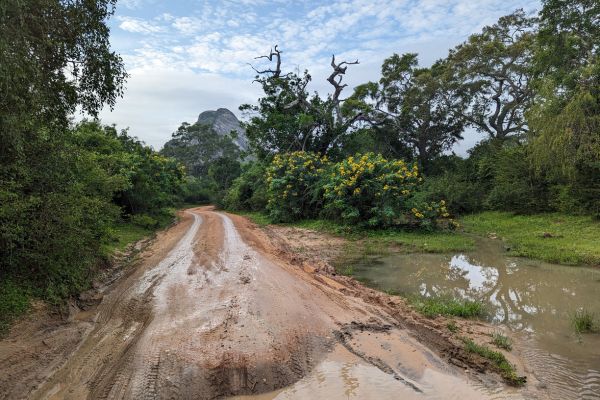
Ranga takes it easy. We have all day. And to be fair some of those jeeps look particularly uncomfortable with the way that everyone is getting bounced around!
The landscape here is glorious too. It’s very flat in this part of the park. And the early morning light is glorious. We see the first of many peacocks. Which you know, I really wasn’t expecting.

And water buffalo. Both domesticated and wild. There are spotted deer too.

And it’s not long before we find our first elephant. There are mongooses. Reptiles. Crocodiles. And Ranga’s book of birds comes in handy.

Elephants, deer, water buffalo, macaques, birds of all types, and yes, leopards were spotted.
Spending a full day in the park means that we get to have our lunch inside the park and don’t need to take the time to drive back out, and that means we actually get a LOT longer on Safari than the half-day folks. It’s 12:30 before we’ve arrived at our lunchtime.
Ranga has brought a set of tiffin boxes and we stop at (what the map says is) the Yala Mobile Leopard Camp for lunch. There’s little more than a space under the trees, some concrete walls to sit on. Well, there are toilets, which are basic (and responsible for the only insect bites I get all day). And we tuck in. Lunch is fabulous.
And then we chatted with an extended Indian family who are here for the Christmas break and having a great time. We avoid the monkeys desperately trying to out-maneuver us to get at the remnants of lunch. And then after a break, we’re back in the jeep for the afternoon session of our Yala National Park Safari.
The afternoon is more of the same. Although it’s much warmer now. There’s an elephant that we find on a massive rock, more deer, lots of birds.

And then we stop for what seems like an age as another driver says he’s spotted a leopard at a distance. We have binoculars, but none of us are sure. Even Ranga says “Maybe”. Which is Sri Lankan for “not a chance”.

And so as we head towards the exit, we’re rapidly getting towards sunset.

We come across an elephant on one side of the dirt track that all the jeeps are driving on. It clearly wants to be on the other side of the track, but no one is willing to let it pass. I want it to ram the jeeps. This feels wrong the way it doesn’t have right of way and they’re not willing to let it pass as visitors glamour for photos.
Eventually, it finds a gap and I feel dirty, soiled, and voyeuristic. And sad. Very sad.
So I’m not in the best frame of mind when a few minutes later we stop. And there is it. Our leopard for the day. It’s about 300 meters away. My phone is my camera. But it’s a leopard. In a tree. At dusk. A leopard in Yala National Park.
Had I been willing to lug a proper camera with me, then the photos would be better, but these photos are from my Google Pixel. Not bad for the leopard being nearly 300 meters away. In a tree. At dusk.

And as we drive, through the increasingly darkening night, I realize that I adore this country, the landscapes, its food, and its people.
Please do come to Sri Lanka. This country needs you, they are struggling for tourism business in the wake of the pandemic and the financial crises of recent years.
History of Yala National Park
Cipriano Sanchez, a Spanish mapmaker noted the area that is now Yala in 1560, stating that it looked abandoned. Under British rule, the forest here was used for hunting, and Yala finally became a wildlife sanctuary in 1900 and then became a Sri Lankan National Park in 1938.
Yala National Park and the 2004 Tsunami
Yala National Park was hit directly by the Indian Ocean Tsunami in 2004. I remember the devastation of the 2004 Tsunami from disjointed TV pictures. From videos that don’t seem real, where the water seems to flood so slowly and unrealistically. I remember, that my concern was for the Chairman of our company at the time, who was on vacation in Thailand (he was fine). The reality of this disaster, I truly don’t believe hit me until I arrived in Sri Lanka.
There were perhaps 50,000 people who died in Sri Lanka. I say perhaps because numbers are uncertain, thousands are still missing, and bodies have never been found. That number pales into insignificance when you consider the more than 200,000 Indonesians who died on the same day.
250 people died here in Yala National Park, where the waves were reported to be more than 6 meters high (20 feet).
This disaster is real to me because I opened a book – Wave – as I arrived for the first time in Sri Lanka. Sonya Deraniyagala – a Cambridge-educated native Sri Lankan, married to an Englishman, with two sons lost her husband, both sons, her parents, and, for a while, her mind. The family was spending the Christmas holidays in Yala. Sonya wrote of her experience, her despair, and her desire to die. The book is a brutal, but enthralling read and I do recommend it whether you come to Yala or not.
Weeks after reading her account, my throat still clenched, and my hand still automatically went to cover my mouth when I think of it. Her voice still, now, bounces off the inside of my head. And even now, 9 years after first reading the book I still feel her despair in the bottom of my stomach as I gaze out at the flat ocean off the beach on the coast here in Yala.

If you’re looking for other Sri Lanka National Parks to visit, then head to Horton’s Plain National Park and hike to World’s End. I wrote about it here.
Transport & Popular Routes in Sri Lanka
- Here’s our guide to travel and transport in Sri Lanka
- Here’s how to buy train tickets in Sri Lanka – online, on the phone and in person
- Want to know what Sri Lankan buses are like? Here’s our guide.
- How to go from Colombo to Galle
- Going from Galle to Yala National Park
- How to go from Nuwara Eliya to Colombo
- How to go from Colombo to Kandy
- How to get from Ella to Nuwara Eliya
- How to go from Jaffna to Anuradhapura
- How to go from Colombo to Jaffna
FAQS about taking a Yala National Park Safari
We had so many questions about taking a safari to Yala. This was, after all the second time we’d planned it. Thankfully, this time it came off. So here’s our consolidation of all those questions.
Do I need a guide on a Yala National Park Safari?
It depends on the experience that you want. A driver will point out what you’re seeing, or what you’re missing if you don’t see it. If you want to know more about the animals and the environment, then a guide will be invaluable.
Can I drive myself into Yala National Park?
Yes. If you have a 4×4 you can drive yourself into Yala National Park. However, most foreign visitors will neither be driving nor have a 4×4, and the roads are rutted, often underwater and not on a map. Do yourself a favor and take a driver and jeep into the park.
Which Entrance Should I use for Yala National Park?
To be fair you probably won’t know which entrance you go in to the park. Plan your accommodation near Yala, then book your safari and they’ll take care of all of that.
What animals will I see on a Yala National Park Safari?
You’re most likely to see water buffalo, deer, and elephants in Yala. Everyone wants to see leopards, and you may be lucky to see them. There are 44 species of mammals here and 215 species of birdlife. However, this is the wild. They don’t come out on demand.
How long do you need in Yala National Park?
If you’re short on time a half-day safari is the shortest trip that you can take into Yala. You can take a full-day safari too. We planned to stick around until we saw a leopard. We were lucky and saw a leopard – at a distance – at the end of our full day Yala Safari.
What are the opening times of Yala National Park?
Yala National Park opens from 06:00 to 18:00. All jeeps are supposed to be out of the park by 18:00. This time is slightly flexible. We left the park exit very late (!), as our driver had spotted a leopard in a tree at a distance and we were waiting to see if it moved. So too were other jeeps.
Are there toilets in Yala National Park?
Yes, there are toilets in Yala National Park, but they are few and far between. You’ll only really get to use them if you’re taking a full day Yala National Park Safari, and when you stop for lunch. They were really basic, and I blame using them for the numerous bites I got “on my lower body” that day.
Final Words on Taking a Yala National Park Safari
This trip has been more than 8 years in the making and I’m so glad we got there this time. Coming to Yala is the primary reason we came back to Sri Lanka. Wait, no, maybe it was the food. Or the people. Well, let’s say it was a big part of the reason we returned to Sri Lanka and it was a great decision. Our private Yala National Park Safari was a fabulous, extremely long day, we saw so much wildlife and birdlife, and, yes we saw our leopard too.
We receive a fee when you get a quote from World Nomads using our affiliate links. We do not represent World Nomads. This is not a recommendation to buy travel insurance.
ASocialNomad is a participant in the Amazon Services LLC Associates Program, an affiliate advertising program designed to provide a means for sites to earn advertising fees by advertising and linking to amazon.com, amazon.co.uk, and amazon.ca. Amazon and the Amazon logo are trademarks of Amazon.com, Inc. or its affiliates. As an Amazon Associate, I earn from qualifying purchases .
Sarah Carter
Leave a comment cancel reply.
Your email address will not be published. Required fields are marked *
Save my name, email, and website in this browser for the next time I comment.
Privacy Overview
Wildlife Adventures in Sri Lanka: How to Plan a Safari in Yala National Park For All Budgets (2024)
Yala National Park in southern Sri Lanka is an amazing place to go on safari and hopefully see leopards in the wild. I recently had the privilege of exploring the wonders of Yala, and I’m excited to share my experiences with you. If you think you have to choose between a high-end, expensive, luxury private safari, or a bare-bones backpackers hostel, we’ve got great news for you- there is a middle ground! We’ll help you sort out where to stay to visit Yala National Park so you can book the best Yala safari in Sri Lanka for your family- whether that’s a luxury resort or a rustic camp where you feel in tune with nature.
Arranging a jeep safari in Yala National Park can be confusing and overwhelming. In this blog post, we’ll help you plan your own unforgettable safari in Yala National Park. From spotting elusive leopards to encountering elephants in their natural habitat, we’ll dive into the magic of this Sri Lankan wilderness together. We’ll cover how to book a park safari experience, which block in the park to visit, where to stay close to Yala, the best time of year to go on Yala safari, how to get to Yala National Park, and tips for enjoying your park safari once you a there.
This article may contain affiliate links, which means we may earn a small commission if a reader clicks through and makes a purchase. As an Amazon Associate, we earn from qualifying purchases at no additional cost to you. All our recommendations are our own and are in no way influenced by any advertiser or commercial initiative.
At the bottom of this post, download a free guide: 6 Safety Tips for Traveling with Kids: What You Should Know Before You Travel
Lodging: Booking.com Flight Deals: Skyscanner Rental Cars: Discover Cars Airport Transfers: Welcome Pickups
Digital SIM Cards: Airalo eSIM Travel Insurance: SafetyWing
Table of Contents
Where is Yala National Park
Yala National Park is located in the southeastern part of Sri Lanka. Its vast expanse covers a significant portion of the country’s southeastern lowland dry zone, making it a haven for diverse wildlife and breathtaking natural beauty. Yala National Park is about a 5-hour drive from Colombo, so it’s best to incorporate your visit to Yala into a larger two-week itinerary in Sri Lanka .
Yala National Park is divided into 5 blocks. Most safari tours visit Block 1 where the largest population of leopards live. Animals are free to wander among the blocks, so there is no guarantee of sightings, and they may change their patterns due to weather, mating season, or even the migration patterns of deer.
Once a British royal hunting ground, Yala National Park was designated a wildlife sanctuary in 1900, and a national park in 1938.
Is Yala National Park Worth Visiting?
Yes, Yala National Park is worth visiting! It’s a family bucket list experience that you won’t forget! Yala National Park has the world’s largest population of wild leopards- so you have the best chance of seeing one of these majestic and elusive creatures!
There is no guarantee that you will see a leopard, but even if you don’t see one, you’ll have a fantastic park safari experience and see lots of other animals including elephants, sloth bears, water buffalo, peacocks, wild boars, and more!
What Animals Will I See in Yala National Park?
There are 44 different mammals in Yala National Park as well as over 200 species of birds. Many people come hoping to see a leopard or a sloth bear, but there are also elephants, jackals, water buffalo, deer, boar, monkeys, and crocodiles. No animal sightings are guaranteed, but most are fairly easy to spot with the exception of the sloth bear and the leopard.
Note: If you are interested in elephant welfare and conservation, we recommend a visit to this elephant sanctuary in Cambodia .
What Happens If We Spot a Leopard?
When a leopard is spotted, your guide will call in the sighting. All of the other vehicles in the area will rush to the site to try and also see the animal. This creates a traffic jam.
Vehicles in Yala do not go off-roading-they follow strict rules which prevent drivers from getting too close to animals or harassing animals. This means that when vehicles line up and crowd into one location, it can be hard for any one vehicle to move.
Secondly, your guide will record and report the sighting. Guides are able to identify most leopards on site by their coloring and spots and will be able to tell you about the animal. Every sighting is recorded so that animal movements can be tracked.
When we visited Yala, our vehicle was the first to see a leopard- near the end of the afternoon we started Amber, a 9-year-old female who was resting in the ditch at the side of the road. She quickly headed into the tall grasses, and we were then able to watch her from far away as she ate a small animal, possibly a rabbit.
When we were finished attempting to watch her- even with binoculars she was tough to see as she would dip her head down below the grass level, we were not able to move for a while as other safari jeeps had blocked us in.
To learn more about the leopards in Yala, or to see photos and details about whichever individual you spotted, check the Yala Leopard Diary . They have updated information about the migratory patterns of each animal as well as a family tree, and lots of wonderful photos.
How to Book a Safari at Yala National Park
There are two ways to book a safari in Yala National Park- as part of a complete package, or by booking lodging close to the park and then arranging the safari separately. Often, even though the safari is not included in your room rate, your accommodations will be happy to help you arrange as many safaris as you like. There are both group safari tours and private safari tours available.
If you are staying in Tissamaharama there will be opportunities to book guides from town. We highly recommend booking ahead so you can arrange for both a driver and a guide for your safari.
A driver will simply drive, and while he will do his best to show you animals he usually doesn’t offer much guidance in terms of animal behavior. We found that our guide and driver worked well together, discussing routes and looking for animal tracks. You want to reputable guide who has years of experience with tracking- they should be able to hear animal alarms indicating the presence of predators and track animals using prints and scat.
Where to Stay Near Yala National Park
There are budget hostels, luxury camps, and a few mid-range camps to stay in near Yala National Park. When we started researching options, I was frustrated to keep seeing the same few luxury or high-ed jungle camps coming up in blog posts over and over- they just weren’t in our budget.
We’ve included some of these luxury camps below- if you have the budget, these camps will pamper you and make sure you have a vacation to remember. However, if these are not in your budget, we’ve rounded up other options so you can still see all the epic wildlife that Yala National Park has to offer.
Try to book lodging as much in advance as possible – many of these properties only have a handful of tents, cabins, or chalets, so they book up quickly.
Staying Inside Yala National Park
There are government-run bungalows available inside Yala National Park . I’ve seen several comments that they are not “up to standard”, but haven’t spoken with anyone who has tried using them. You can stay in these bungalows for up to 3 consecutive nights. You can see the facilities here , and reserve them online . Details are scarce- if you’ve tried one of these please let us know how they were!
Luxury Jungle Camps near Yala National Park
These luxury camps offer every amenity- and charge over 1K USD per night. If you are looking for an unforgettable, once-in-a-lifetime, five-star experience, these lodges are fantastic. These jungle camps are in the buffer zone around Yala National Park.
Uga Chena Huts
This is a five-star all-inclusive resort that has luxury cabins that are air-conditioned with private plunge pools. They describe the resort as “colonial expedition chic with contemporary design innovations”. Safaris and meals are included with the lodging. This place is absolutely stunning, and only a few minutes drive from Yala National Park.
“The location is amazing, no fences or electric to keep out wildlife so it’s wild and beautiful. You can walk to the beach and to a nearby waterhole from your accom (not after dark!) You do need to be careful but that’s half the attraction. Two daily (optional) safaris were included with our stay which were brilliant, we saw so much amazing wildlife both on these.” -Jenny (Read More Reviews )
Book Now: Uga Chena Huts
Wild Coast Lodge
This five-star all-inclusive jungle resort is built in the shape of a leopard’s paw, with open-air central buildings made from bamboo and other natural materials. Guests stay in luxury air-conditioned cocoons made with double-height, stretched fabric roofs looking over the Indian Ocean. They also have a family cocoon suite that has two attached pods for parents and kids to experience together, while still having some privacy. Meals and game drives are included.
“I turned around to see a giant elephant on its way to my watering hole…they said it could happen…but I really thought the reality was slim to none…boy was I surprised! Besides all that, all the food and drinks were delicious! And, it cannot be omitted…the coastline! WOW!” -JennIE (read More reviews )
Book Now: Wild Coast Lodge
Mid-range camps near yala national park.
These unicorns are in the buffer area of Yala National Park- so you’ll need to get a driver to take you there, but are much closer to the gate of the park, so you’ll have less of a drive early in the morning. Some of these camps also offer an additional bush walk to introduce you to the wildlife in the area around the camp.
Cinnamon Wild Yala
This eco-friendly resort is high-end and clearly has hosted a lot of bloggers because it comes up often. This resort is in a bit of its own category- it’s more expensive than most of our mid-range options- with rooms in the range of $300-400 USD per night. As a five-star property, it’s a bargain compared to the all-inclusive luxury options, but significantly more expensive than most of the mid-range. If you’re debating about splashing out on your stay near Yala, this could be just what you are looking for.
This camp is located very close to Wild Coast Lodge but for 10% of the price tag. Chalets here are air-conditioned with private balconies. Chalets each have one double bed, so they don’t have a great setup for larger families, though they do offer connecting rooms. The complex has a large pool and a rooftop terrace for guests to enjoy.
“The property is absolutely fabulous, the location is incredible. if your going there for animals this is the place to stay. In the resort we saw crocodiles and water buffalo down at the lake and lots of beautiful birds. An elephant went through the resort and was down at the lake twice.” -Emma (read more reviews)
Book Now: Cinnamon Wild Yala
Wild Trails Yala by Suri
Wild Trails Yala is where we stayed, and absolutely loved it. We stayed in a tent with one double bed and two beds, air conditioning, and our own bathroom. The “tents” at Wild Trails Yala are made of lovely hardwoods, with our own front deck. Once we arrived we went on an afternoon bush walk, then hung out by a watering hole in the later afternoon until dinner was served by candlelight. There is no pool or fancy amenities, here, it really is glamping.
In the morning, we woke in the dark, had a cup of tea and biscuits, and headed out on our full-day safari. By the time we arrived back at camp, it was after dark. We had arranged for a driver to take us to Hiriketiya Beach that evening. Looking back, we would have enjoyed relaxing at camp for a second night and not rushing out so fast.
The camp here is small and simple, but lovely, and with every convenience. They made arranging our safari easy, and the guide they provided was friendly and knowledgeable. He taught our girls a bit about tracking and answered all their questions about wildlife in Sri Lanka. He even pointed out where once there may have been treasure buried inside a rock!
“The tent was amazing; extremely comfortable and spacious with towels, water, AC and a fan as well as shampoo and shower gel as standard. Goshi arranged a fabulous guide to accompany us on our 2 safaris (small extra charge and well worth doing as it added a lot to the experience). The park entrance is 15 min drive from Wild Trails Yala by Suri.” -Elizabeth (Read more reviews )
Book Now: Wild Trails Yala by Suri
Jetwing Yala
This resort is a massive 38-acre complex , complete with a spa, a large outdoor swimming pool, and TVs in each room. This is not a camp, but a large, luxury hotel close to Yala National Park.
“Great location just outside the national park and on the beach. It’s a lovely property with an exceptional pool. The staff were extremely friendly and helpful and there was an excellent choice of food and drink. We had lovely massages in the spa.” -Julia (read more reviews )
Book Now: Jetwing Yala
Camp Leopard
This glamping resort is located near the town of Katagamuwa and uses the northern entrance into Yala National Park than the south entrance used by those lodgings closer to the coast. Visitors report that the ride into camp is a bit bumpy due to its remote location, but that using a different entrance means a quieter safari experience, and that the guides here are experienced and top-notch.
Tents here are canvas and have a more rustic feel, though they are air-conditioned. Hammocks are available in the shared lounge area. They have an onsite restaurant, and can also arrange a bbq by the lake.
“The staff at Camp Leopard are phenomenal. Very accommodating, knowledgeable, and friendly. They immediately treated us like friends and taught us about the animals, food, and culture.” -Brian (read more reviews )
Book Now: Camp Leopard
Budget Lodging near Yala National Park
The nearest town to Yala National Park is Tissamaharama. This is where you’ll find most of the budget hotels and hostels. From this town, you have about a 45-minute drive to the main gate of Yala National Park. The farther away you stay from the park, the earlier you’ll have to get up in the morning to be at the gate (and in line with the other cars) before the 6 am opening. These hotels generally charge well under $100 per night.
There are many more options in Tissamaharama, here are some of the hotels with the highest guest ratings, many of these offer family rooms with multiple beds:
– Moon Light Guest House : With a 9.9/10 rating, travelers report spacious rooms, a shared garden, and staff who cook a delicious curry!
– Village Mango Resort Yala : Looking out over rice fields, these comfortable rooms are run by a lovely family who takes special care of their guests. There are hammocks and bicycles for guests to use.
– Lavender Home Yala : Run by a lovely family, you’ll find comfortable family rooms with air conditioning, some with balconies on the upper story.
Safari Options at Yala National Park
When going on a Yala National Park safari you have the option of a half-day morning safari, a half-day afternoon safari, or a full-day safari.
Half-Day Morning Safari
Mornings are the best time to see animals. You’ll line up with a lot of other vehicles outside the main gate of Yala National Park as the sun comes up, once the gates open, you’ll want to be one of the first cars in, as the vehicles often scare off any animals that are nearby.
Expect a 4:30 departure if you are leaving from Tissamaharama and a 5 or 5:15 departure from one of the border area camps.
If you choose the morning half-day option, you’ll have about three hours of safari time, then head back to your accommodation by 10 am.
Half-Day Afternoon Safari
The afternoon safaris depart from your lodging for a 2 pm entrance to Yala National Park. You’ll have about three hours of safari time, focusing on the later afternoon hours when the sun is not so hot. All vehicles must exit the park before sunset.
Full Day Safari
A full-day safari is from 6 am when the park opens, until about 6 pm. We watched the sunset on the way back to our camp. This is a long day, but it gives you the best chance of spotting animals, without a lot of back-and-forth driving.
You will need a packed breakfast and lunch to eat in the park. Also, the park closes down from 12-2, and all the full day safaris stop for a long lunch break in designated areas. The park is really strict about this, as it gives the drivers and the animals a much-needed break. You’ll see the safari jeeps line up a few minutes before 2 waiting to leave the designated area, but they take this break very seriously.
With four of us in the back of the safari jeep with four bucket seats and a rear bench seat, we had plenty of room to move around and switch seats in and out of the sun over the course of the day.
We spent our lunch break at a stop with a bathroom right by the river. Our guides put down a blanket and set out lunch, then we were free to play in the river until it was time to go. There are a lot of monkeys here so the guides were focused on keeping them away from our food, and then ate once we had finished.
After lunch we drove around a bit, it did start to feel like we were going back over areas we had already visited. At 2 pm it is still hot, so there are not a lot of animals around. One of the kids fell asleep at this time, and we let her rest, figuring we could wake her for any big sightings. By late afternoon there is again more to see, and then as you head back to the gate for your evening exit.
How Much Does Yala National Park Cost?
The entrance fees to Yala National Park are charged by the Department of Wildlife Conservation (DWC) depending on the number of foreigners in a jeep. Children below 6 are free of charge. Children 6-12 pay a child rate, anyone over 12 is considered an adult.
As of 2023, two adults in a jeep will pay a total of 71 USD in park fees. 2 adults and 2 children will be 106 USD. Generally, these fees are included when you book a vehicle with a driver and a guide.
Prices vary, and make sure to negotiate with your provider, but in 2023 we were quoted $150 for a half-day safari (private jeep, 2 adults 2 kids), and originally quoted $300 USD for a full-day, but were able to pay $175 USD. This included a packed breakfast and picnic lunch during our safari day, as well as an afternoon bush walk the day before our actual in-park safari.
How Much Should I Tip for a Safari in Yala National Park?
Deciding when and how much to tip is always a bit stressful, and depending on where you are coming from you may have different cultural associations or expectations around tipping. To clarify, we reached out to our host at Wild Trails Yala to learn about expectations around tipping your guide and your driver after a safari in Yala.
She advises planning to tip around $10 USD per vehicle to the guide for a half-day safari, and around $20 USD for a full-day safari. It is also recommended to tip the driver as well, though generally slightly less than the guide. Adjust as you feel comfortable based on your experience. This is not per guest but per safari vehicle in total.
Yala National Park Hours
Yala National Park opens at 6 am and closes at 6 pm. There is a mandatory lunch break from 12-2 for all vehicles that are staying for the full day.
Some years, the entire park closes for the month of September. However, in 2023, the park will not be closing unless a drought hits.
When is the Best Time to Visit Yala National Park
Yala can be visited year-round, but your chances of seeing different animals will vary by time of year.
February – July is the best time for spotting leopards. This is the dry season, so while the scenery is not as lush, the animals come out into the open to visit watering holes. We visited Yala in February and had great weather for animal spotting.
In August, the Palu trees bear fruit making it much easier to spot sloth bears who love to eat this fruit.
November to January and April are the rainy months when you are less like to see animals. Keep in mind that leopards, like other cats, do not like the rain, and will retreat into caves, so you are much less like to see one on a rainy day.
Often, Block 1 of Yala closes in September to give the park time to recover from the crowds. During this time, Block 5 is available for an alternate safari.
Which Block Should I Visit in Yala National Park?
There are five blocks in Yala National Park, but most are not open to the public. They are protected land, accessible only to those doing research, filming documentaries, or similar programs that get explicit approval.
This is the block that most tourists visit. The animals that spend time here are used to vehicles going through and are unfazed by the traffic, and therefore easier to spot. The traffic here can be intense, with lines at the gate before sunrise.
Block 1 is the most popular block because this is where the highest numbers of leopards live. We toured Block 1, and while the actual area is small, we did see almost all of the animals we were hoping for, with the exception of the sloth bear.
Block 5 is usually booked for safaris during October and November when Block 1 is closed due to drought and for restoration. There is less visible wildlife here, and much less traffic. The animals are shyer, and the terrain is drier. This is a great block for bird watchers, but not for seeing the larger animals. Some tourists report being very disappointed by tours of Block 5.
Blocks 2, 3, and 4
The other blocks are generally not open to the public, although some specialized tours may enter Block 3 specifically looking to see sloth bears.
How to Get to Yala National Park
While there are buses and trains that run through various parts of Sri Lanka, Yala National Park is not on any major bus routes. You can take a bus from the south coast beach towns to Tissamaharama, but if you are staying at lodging in the buffer area of the park you will need private transportation to get there from the center of town.
From Galle, take the bus marked Kataragama, Tissamaharama is just one stop before the final stop at Kataragama.
The easiest way to get to Yala is to hire a private driver for the journey which will drop you directly at your lodging which may be quite a distance from the town center.
Alternate National Parks in Sri Lanka
Sri Lanka has a massive amount of protected lands over 13% of the country is a national park, reserve, sanctuary, or similar protected space. In fact, Sri Lanka has 21 National Parks! If you can’t fit Yala National Park into your Sri Lanka itinerary, there are other parks that you should consider to see wildlife in Sri Lanka.
Wilpattu National Park : Sri Lanka’s largest and oldest preserve, with a dense forest cover. Close to the historical city of Anuradhapura. Here you will look for elephants, leopards, and sloth bears.
Udawalawe National Park : This is one of the best parks to see herds of elephants. Drier than Yala, it is located more inland. Located south of Ella and northwest of Yala.
Bundala National Park : This is the most impressive park in Sri Lanka for bird watching. Located just down the coast from Yala, the wetlands here attract migratory birds, and the park boasts over 200 species.
Wasgamuwa National Park – This park in central Sri Lanka, just south of Sirigiya, has the largest population of sloth bears in Sri Lanka. You will also see elephants, deer, and crocodiles.
Tips for Enjoying Your Safari In Yala National Park
Here are some tips to help you be prepared and enjoy your safari in Yala National Park.
1. Keep Your Expectations Low. This is especially important with kids! You may see a wild leopard right away, and follow them for an hour, or you might not see one at all. You may be called to a sighting to find 30 other vehicles waiting in line to see the same animal that is now deep in the grass. You will see wild animals, but it’s best to keep your expectations low prior to your trip.
2. Bathrooms are hard to come by in Yala National Park. Your guide may be able to find a spot for you to squat in the bush, but the only official bathroom is at one of the lunch break locations, so be prepared for that reality.
3. The best time to see animals is in the early morning, so you’ll start before dark, and be lined up (with a lot of other vehicles) at the entrance to the park before dawn. Later afternoon, starting around 4 pm is the next best time to see animals.
4. The afternoons get quite hot, and the animals take cover. If you opt for a full-day safari, keep in mind that the afternoon will be slow. One of our kids fell asleep in the car during this time, and we let her sleep. To some extent, it felt like we were driving around just wasting the hours waiting for the cooler times when the animals might emerge.
5. Bring water and a packed lunch. Your lodging can probably help with this, but there is nowhere to buy water or food inside the park, so come prepared.
6. Bring sun lotion, bug spray, and a sweater for the cool morning before the comes up. Remember to bring extra battery packs or chargers for your camera or phone!
7. Communicate with your guide. If you’d like to stop and take a picture, let them know. If you are ready to move on, speak up! They want you to have a good time but don’t always know whether you want to stop to see the fourth peacock of the day and take photos, or just keep moving.
FAQ: Safari in Yala National Park
The more hours you spend in the park, the more likely you are to see a leopard or other hard-to-spot animal. We recommend either one full day or two half days to maximize your chances of seeing these elusive animals.
There are over 100 leopards in Yala National Park, with many of them roaming through Block 1. Your guide will be able to identify and report any leopard that you view on your safari.
Yala National Park is huge- it covers 979 square kilometers or 378 square miles. That’s nearly 130,000 hectares of land. It is the second largest national park in Sri Lanka, behind Wilpattu National Park.
Yes, you can stay inside Yala National Park, though most people stay outside the park in private lodges in the buffer area around the park. The bungalows inside the park are managed by the Sri Lankan government and have few amenities. You can see the facilities here , and reserve them online .
There are many animals and birds in Yala National Park including leopards, sloth bears, elephants, crocodiles, peacocks, boars, deer, jackals are more. Birds include various storks, pelicans, and herons.
Leopards are wild animals, so they can be dangerous. Most leopards in Yala National Park as used to seeing safari vehicles all the time, and pay them no mind. However, never exit a safari vehicle unless your guide tells you that it is safe to do so. Leopards can become especially dangerous if hurt, or if their cubs are threatened. Here’s a fun article on how to survive a leopard attack .
Beginning in 2022, vehicles could no longer enter Yala National Park without a licensed guide. Currently, private vehicles cannot enter, you must be a registered tour vehicle.
You need a licensed vehicle and driver to visit Yala National Park. We strongly advise also hiring a guide who will help you track and spot animals, as well as give you guidance on their behavior.
There are supposedly a few buses that run from Ella to Yala National Park but they are not straightforward. We recommend booking a private transfer. You can ask for quotes from your hotel in Ellas as well as your camp near Yala to compare rates. We found that while everything is negotiable, most places offer fair rates based on the cost of fuel at the time. The drive time between Ella and Yala is about two hours.
Colombo is about a five-hour drive from Yala National Park. You can hire a driver to take you between the two cities, but you are better off enjoying other locations in Sri Lanka on your way to and from Yala. The southern beaches are only about a 1-2 hour drive from Yala.
There You Have It: Safari in Yala National Park
A safari in Yala National Park is a wonderful experience with wildlife you aren’t likely to see elsewhere! We’ve covered all the options from luxury to budget- whether you want to be pampered, or commune with nature. You’ve got everything you need to know to book your safari, from what to expect, and to what to bring with you to have an amazing safari. Make sure to add a safari in Yala National Park to your Sri Lanka itinerary, finger’s crossed you’ll see a leopard!
Continuing on to India? Don’t miss our guide to the Taj Mahal !
Cynthia Matthews von Berg is the founder of Sharing the Wander. She is a passionate traveler, mom, and travel coach specializing in long-term travel and family travel. She and her family embarked on a Family Gap Year in 2021, and haven't looked back.
Similar Posts
Hikkaduwa beach: sea turtles, surfing, and adventure in sri lanka (2024), sri lanka itinerary: 2 amazing weeks of jungles, beaches, and culture (2024), is the taj mahal a mosque everything you need to know to visit the taj mahal in 2024, tropical paradise: 15 things to do in hiriketiya beach, sri lanka (2024).

Pre-book your safari

News | From the wild
Yala in september.
As of now, it looks like your favourite park will remain open throughout 2023! While visitors may be familiar with the park usually being closed in September, no such decision to close the park this year has been made. Any decision to close the park, if at all, will be if a severe drought occurs. So, let’s hope for the best!

This is leopard country, and they are the Lords of the Jungle! With a leopard density that's higher than anywhere else on this planet, these menacing predators prowl majestically in Yala, while elephants roam in their numbers with cautious deer scampering by their side

PRE-BOOK YOUR SAFARI
You can now advance book your safari to yala including reserving your ticket and safari jeep., kumbukriver eco-lodge.

STAY AT THIS WORLD FAMOUS ECO-LODGE
If you are visiting yala, take the time to travel to kumbukriver, one of the world’s most unique hotels., hotline: +94 77 736 1010 | www.kumbukriver.com.

First comprehensive tourist map

EXPLORER’S CORNER
Visited yala recently post your pictures, videos, comments and recommendations on our social media blog., their life is in your hands, are you a responsible visitor, as the number of visitors to this world-famous park increases, so does its impact on nature. while the incredible world of wildlife must be experienced, you must take it to your heart that you cannot even leave your foot print behind. so let’s take a moment to understand what wildlife is all about and how you can confidently proclaim that you are a true lover of nature..
More From Forbes
This ultra-luxury safari lodge will debut in the serengeti in june 2024.
- Share to Facebook
- Share to Twitter
- Share to Linkedin
With prime safari season fast approaching, a show-stopping lodge in Tanzania is gearing up to welcome guests this June, as it sets a new standard for luxury in a relatively untouched corner of one of Africa’s most iconic destinations.
One Nature Mara River Lodge promises an extraordinary safari experience amidst the gorgeously untamed beauty of the Northern Serengeti, a less-traveled part of the park wedged between the Central Serengeti to the south and Kenya’s Maasai Mara National Reserve to the north.
The seven villas at One Nature Mara River Lodge, set to open in June of this year, all feature ... [+] heated pools, outdoor copper bathtubs, and dazzling views of the Serengeti.
Its hilltop perch, located just over a mile from the Mara River and a 30-minute drive from the Kogatende Airstrip, affords guests stunning views of the entire Mara Triangle–one of the premier viewing locations for the Great Migration, where seemingly endless herds of wildebeest and zebra enter and exit the Maasai Mara National Reserve from Serengeti National Park from June to November–while also offering complete privacy from the hundreds of vehicles that line the riverbank during one of the natural world’s most incredible annual spectacles.
The new One Nature Mara River Lodge offers guests a front-row seat to the Great Migration, during ... [+] which some two million wildebeest and zebra migrate annually from Tanzania's Serengeti National Park to the greener pastures of the Masai Mara National Reserve in Kenya.
Guests of the property will witness the thrilling Great Migration river crossings to Kenya from One Nature Mara River’s open 4- and 6-seater vehicles. Besides year-round safari game drives, other activities include balloon safaris, walking safaris, enchanting riverside sundowners and picnics, and singular bush dining experiences.
Best High-Yield Savings Accounts Of 2024
Best 5% interest savings accounts of 2024.
The lodge's seven luxury villas also boast woodburning stoves, private bars, and TK TK.
One Nature Mara River Lodge’s six one-bedroom villas and and sprawling two-bedroom family villa–measuring more than 1,625 square feet and 3,100 square feet, respectively–showcase a contemporary colonial design accented with African elements, and feature private heated pools with panoramic views of the Serengeti, outdoor lounge areas, indoor and outdoor showers, and copper bathtubs. Other creature comforts include eco-friendly engineered wood flooring, solar-powered air conditioners, wood-burning stoves, and private bars. The lodge’s enviable privacy is among its most vital aspects, as the rooms’ outdoor bathtubs, showers, and private pools face the awe-inspiring river view.
During the Great Migration, thousands of wildebeest migrate through the vast plains of Serengeti ... [+] National Park, which was created In 1951 to protect the area's large numbers of wildebeest, zebra, and Thomson's gazelle.
In keeping with One Nature’s sustainability ethos, the lodge–powered by a 352-panel solar farm–has been built to ensure that it can be disassembled and removed without leaving a trace. All wood throughout is FSC-certified, while an on-site bio-gas plant transforms food waste into cooking gas to optimize energy efficiency and minimize waste. The property also eschews plastic consumables, replacing them with customized glass water bottles, paper straws, bamboo toothbrushes and razors, and boxes, paper, and pencils made from recycled and biodegradable materials.
The opening marks the launch of One Nature’s second property, following the debut of the 14-tent One Nature Nyaruswiga , located in the Central Serengeti, in January 2017. The company was founded by Dubai-based husband-and-wife team, Hani and Pamela Saliba, whose first African safari in 2014 cast a life-changing spell.
“Love is an understatement,” says Pamela, One Nature’s executive director, who oversees lodge operations. “We found ourselves drawn back repeatedly, traveling to national parks across Africa. The experience sparked a dream to create a sanctuary of our own, where we could bring together family and friends. That dream brought One Nature Nyaruswiga–which we made our personal haven–to life. Perhaps that’s why many of our guests remark that the lodge feels like a home away from home.”
The lodge's main lounge is a cozy gathering place to enjoy cocktails while sharing stories of safari ... [+] adventures in the Northern Serengeti.
One Nature’s future expansion plans include properties in Queen Elizabeth National Park and Bwindi Impenetrable Forest in Uganda, Sossusvlei and Etosha National Park in Namibia, and Yala National Park in Sri Lanka.
Rates at One Nature Mara River Lodge start at $1653 in mid-season and $2240 in high season, per person per night, inclusive of all meals and beverages (including premium wines and spirits), wifi, laundry, daily game drives, and round-trip transfers from the Kogatende Airstrip. For more information or to book, visit the One Nature website .
- Editorial Standards
- Reprints & Permissions
- Search Please fill out this field.
- Manage Your Subscription
- Give a Gift Subscription
- Sweepstakes
- Nature Travel
Sri Lanka Has a New Walking Trail With Wild Forests and Centuries-old Wellness Retreats — What to Know
The hiking path covers 186 miles, visiting towns and locations rarely seen by travelers previously.
From left: iStockphoto/Getty Images; Courtesy of W15 Hanthana
Heavy clouds rolled overhead, clearing out the day’s humidity in Sri Lanka’s central highlands. Below a forested hillside, tea pickers in colorful saris moved among rows of electric-green bushes, as if the scene were set to high contrast. In the distance, plumes of smoke carried the scent of roasting tea leaves.
I was walking the Pekoe Trail, a long-distance hiking path that opened in Sri Lanka last year. Largely made up of existing paths used to travel between tea fields and factories, it winds 186 miles through estates and national parks. The trail, which connects 80 hamlets and villages that see few foreign visitors, was designed to bolster Sri Lanka’s tourism industry in the aftermath of the terrorist bombings that took place in the capital, Colombo, on Easter Day 2019.
More a walking holiday than a backpacking expedition, the entire trail is designed to take a laid-back 22 days, with hikers covering an average of nine miles each day. For those who don’t have three weeks to spare, it’s possible to link up separate sections with the help of a guide and driver, as I did on my five-day trip.
Courtesy of Thotalagala
After arriving in Colombo, I boarded a three-hour train to the ancient city of Kandy, where the trail starts. I spent my first night at the 10-suite W15 Hanthana , where a wraparound veranda overlooked misty mountains topped with stupas and temples. The next morning, after a late breakfast of string hoppers (rice noodles) and curry, I set out on the first segment on my route: 7.5 miles of easy dirt road that cut through colorful villages and the Hanthana mountain range, a popular hiking spot, before ending in the small town of Galaha.
I was accompanied by Miguel Cuñat, the sustainable-tourism consultant who designed the trail. “You know that saying ‘To understand an island’s soul, head to its interior?’” he asked me as we ate mangoes from a roadside stand during one of our breaks. I knew what he meant. Like many visitors to Sri Lanka, I had only spent time along the beautiful coastline, and it wasn’t until this hike that I began to sense the island’s true character.
On my second day, Cuñat and I walked uphill through a steep pine forest and then followed a ridge that overlooked the Knuckles mountain range and the snaking Mahaweli River. Thick fog in the distance signaled the looming monsoons. Two hours later, the forest opened up to the Loolecondera , Sri Lanka’s first tea estate, which dates back to 1867.
Courtesy of W15 Hanthana
From there it was a 56-mile drive to Goatfell , a beautiful bungalow that overlooks Ceylon tea fields. I dipped my tired legs into the infinity pool, then read by the living-room fire as the rains rolled in.
The next morning, it was a quick drive to Nuwara Eliya, a picturesque city that is a popular getaway for many Sri Lankans. We hiked six miles through a tableau that felt like the quintessential image of the countryside. Women moved through tea fields, gently plucking only the youngest buds and leaves from each branch to assure the highest quality of Ceylon black tea. Many of the tea pickers are descendants of the indentured South Indians brought over by the British colonists in the 19th century, and the work is still punishing. Under wages set by the government, they must pick about 40 pounds of tea each day to earn just over $3.
While Nuwara Eliya is the official end of the Pekoe Trail, hikers can follow the route in any order they like. So, after a tea break, we drove 60 minutes to Horton Plains National Park, where a windswept plain was circled by a cloud forest. We strolled under a troop of bear monkeys swinging from trees before the dense canopy opened up to a switchback called the Devil’s Staircase, which overlooks the lush Udaweriya Valley.
That night we slept at Thotalagala , a seven-suite retreat in Haputale where Thomas Lipton, the Scottish merchant, began his Lipton Tea empire in the late 19th century. The next morning, I took a tuk-tuk to a panoramic overlook called Lipton’s Seat, where Sir Thomas is said to have sipped tea and looked out over his estate. The view has not changed much.
Courtesy of The Pekoe Trail
For our final hike, we drove to a modest village, Makulella, then climbed through a eucalyptus forest to a ridge dotted with Buddhist temples and waterfalls until we reached the Nine Arch Bridge. The famous viaduct turned out to be just as dramatic in real life as it is in photos. While other tourists arrived in tuk-tuks, it was satisfying to approach the bridge on foot, alongside children in starched school uniforms.
The people behind the Tourism Resilience Project — which established the trail and is funded by the European Union and the U.S. Agency for International Development — hope it can empower villagers to make a living from the new route, perhaps by operating a juice bar or tea-tasting room for hikers. “We want the people living and working there to feel like they’re a part of it,” said Vishadini Fernando, a project manager. The vision includes giving visitors more chances to learn from locals.
It was just this kind of understanding that soothed me during the night I spent at Thotalagala. I arrived after dark and was led down a grand hallway that opened onto a manicured lawn. Beyond an infinity pool, a fire burned, engulfing trees along the hotel’s edge. But after having hiked the highlands for several days, where the sight of smoke rising from small patches of forest is a near constant, I had recalibrated my relationship to seeing fires in nature.
A tea farmer had taught me about controlled burning: always simmering, never boiling over. I took my tea, fell asleep, and by morning, a small patch of earth just beyond the estate’s periphery was scorched, but everything else — including the view of mist-shrouded tea hills spilling into a lush valley — remained beautifully intact.
A version of this story first appeared in the April 2024 issue of Travel + Leisure under the headline "High Tea. "

IMAGES
VIDEO
COMMENTS
Yala National Park is possibly our favorite park in Sri Lanka, and it is certainly one of the more popular places to visit! Yala is located in the southwest corner of Sri Lanka. It is the second-largest park in the country and it borders the Indian Ocean as well as an expansive dense jungle. The park is broken up into 5 blocks, and only blocks ...
1. Yala National Park. Yala National Park is the most visited national park in Sri Lanka and one of the best places to go on safari in the country. This huge area spans more than 975 square kilometres (375 sq mi) across the southeast corner of the island.
Maduru Oya National Park, Eastern and Uva Provinces Best for birds and Indigenous history. Northwest of Batticaloa, Maduru Oya is one of the least visited national parks in Sri Lanka. At its center is an immense, 500 sq km reservoir full of fish, that attracts water birds including black-necked, painted- and wooly-necked storks, spot-billed ...
Yala National Park in Sri Lanka. Yala is the most popular national park in Sri Lanka, and for good reason! It is famous for its high leopard population (40-50 within Yala), which is actually the highest leopard density in the world! Despite this, it's not guaranteed to see a leopard, as they are very elusive.
Yala National Park. Yala National Park could easily be the country's most well known national park, and of course, it's the perfect place for a Sri Lanka safari. It's one of the country's largest nature reserves, as well as being the most visited, and in Yala, you can find the best of Sri Lanka's wildlife. The huge national park ...
As with most things in Sri Lanka, visiting Udawalawe National Park can be done without breaking the bank, especially when compared to African safaris. Before visiting, you do need to know that there are generally two fees that need to be paid when taking a safari. PARK ENTRY FEES. First, there are the park entry fees.
Our guide to Wilpattu National Park safari will help you plan your wild Sri Lankan adventure. Taking up almost 2% of Sri Lanka's land area, Wilpattu is the largest National Park in Sri Lanka. The park is located in the dry climatic zone on the northwest coast of Sri Lanka. It lies 35 km west of the ancient city of Anuradhapura and 200km north ...
Image Source. Kaudulla National Park is a beautiful wildlife sanctuary located in Sri Lanka. The park is home to a variety of animals, including elephants, water buffalo, monkeys, and birds. A safari in Kaudulla National Park is a truly unique experience, and it is the perfect way to see Sri Lanka's wild side.
The best national parks for Sri Lanka safari. 1. Yala National Park. The Yala National Park is the best place to see leopards and elephants in Sri Lanka. You can easily reach Yala from Ella, Mirissa, or Galle and take a half-day or full-day Sri Lanka safari tour. Yala National Park is home to 44 species of mammals and 215 species of birds.
If you want an luxury safari sri lanka experience in Yala national park, then these spots will not fail to deliver. Yala National Park All-Inclusive 2-Day Safari At The Leopard Nest Campsite . $450 per person. This is an excellent Sri Lanka safari that offers luxurious accommodation amongst the jungle with an all inclusive experience.
Especially if you realize that Yala National Park is considered the most popular wildlife park on Sri Lanka's teardrop-shaped island. This excellent reputation is due to its dynamic landscape, great variety and density of wildlife - plus the fact that the park is acknowledged as one of the best places in the world to see leopards in the wild.
Full-day safari tours in Wilpattu, booked in advance, can cost anything from $150-200 USD per person. The exact price depends on the operator, the size of your party, and whether you need transport to/from the park. 🤩 …Or, for the ultimate safari experience, check out this epic 2-night camping safari in Wilpattu.
Wildlife sighting: Minneriya National Park is home to a variety of animal species that inhabit its different ecosystems. Among the most prominent residents are the Asian elephants, which roam freely across the plains. The best times to go for an elephant safari in Minneriya National Park is in the morning between 5:30AM-8:30 AM and in the afternoon between 3:00PM-6:00 PM, because these are the ...
Yala National park safaris provide a unique opportunity to explore one of the most iconic landmarks in Sri Lanka with the help of dedicated, knowledgeable. Yala National ... Sri Lanka National park entrance fees have been increased for local and foreign tourists from the 1st of September 2022 (Gazette Notification No. 2292/11 Aug 2022). ...
Planning a trip to Sri Lanka?Then a safari in Yala National Park is absolutely essential. Yala National Park straddles the empty southeastern coastline of Sri Lanka and the1268sq km park is home to a rich array of dunes, forests, open plains and lush lagoons, which also attracts a huge diversity of wildlife; 44 mammal species (including elephants) and over 215 bird species, to be exact!
Yala National Park safaris provide a unique opportunity to explore one of the most iconic landmarks in Sri Lanka with the help of dedicated, knowledgeable. Yala National ... Sri Lanka National park entrance fees have been increased for local and foreign tourists from the 1st of September 2022 (Gazette Notification No. 2292/11 Aug 2022). ...
Yala National Park is a wildlife sanctuary in the southeastern region of Sri Lanka. The park is the second-largest national park in the country for the best Safari experience, spanning over 978.8 square kilometres. It is home to diverse flora and fauna, including Sri Lankan elephants, leopards, sloth bears, and over 200 bird species.
The park takes pride of place in Sri Lanka and our complete travel guide focuses on this one park and what you can get from it for your holiday vacation. Like those parks in India, there are safaris that are guided tours to ensure you get maximum pleasure and act responsibly, and stay safe ― because these are dangerous animals.
Elephant in Yala National Park on a Sri Lanka safari Logistics Yala National Park. Base town: Tissamaharama or Kirinda. Logistics: There are frequent buses to Tissamaharama from Galle (5 hours), Ella (4 hours) or Tangalle (3 hours). Accomodation: Tissamaharama Safari Inn. Time to visit: The dry season from May to August, the park closes for six weeks in September and the beginning of October
Yala is about 6 hours' travel or 260 kilometers (161 miles) from Sri Lanka's capital city of Colombo. We traveled from Galle to Yala National Park, that journey is 190 kilometers (118 miles) and it took about 3 hours using the Expressway to drive to Yala from Galle. EASIEST WAY TO VISIT.
In fact, Sri Lanka has 21 National Parks! If you can't fit Yala National Park into your Sri Lanka itinerary, there are other parks that you should consider to see wildlife in Sri Lanka. Wilpattu National Park: Sri Lanka's largest and oldest preserve, with a dense forest cover. Close to the historical city of Anuradhapura.
The national park was established in 1972 and covers an area of 30,000 hectares. It was created to provide a sanctuary for the wild animals displaced by the construction of the Udawalawe Reservoir and dam. Elephants that we spotted during our Udawalawe safari. The elephants we spotted before even entering Udawalawe National Park.
1st March 1938. Distance from Kataragama to: Katagamuwa Entrance: 14Km Palatupana Entrance: 41Km Galge Entrance: 30Km. Nearest Hospital: Debarawewa Government Hospital. Head office: Open from 9am to 6pm. yalasrilanka.lk is the official website of yala national park, sri lanka's most famous wild life park. among a host of animal, yala is ...
Kaudulla National Park - Situated in the ancient city of Polonnaruwa in Sri Lanka, Kaudulla National Park offers abundant opportunities for visitors to observe magnificent elephants in their native surroundings.; The park is also home to a variety of other wildlife, including sambar deer, Sri Lankan axis deer, chevrotain, wild boar, Asian spoonbill, grey-headed fish eagle, painted stork, and ...
Rates at One Nature Mara River Lodge start at $1653 in mid-season and $2240 in high season, per person per night, inclusive of all meals and beverages (including premium wines and spirits), wifi ...
Two hours later, the forest opened up to the Loolecondera, Sri Lanka's first tea estate, which dates back to 1867. The piano room and library at W15 Hanthana, near the start of the Pekoe Trail.
98 Likes, TikTok video from next… (@nextplacepls): "Yala National Park, Sri Lanka 📍 #safari #safaripark #srilanka #yalanationalpark #elephants #leopards #backpacking #holiday #southsrilanka #srilankan #srilanka🇱🇰 #animal #explore #southeastasia #asia". Did you know it's not just Africa that has incredible safari… | This is Sri Lanka…He Lives in You - Holy drill.
367 likes, 41 comments - rare_srilanka on April 1, 2024: "Tusker Bullet has been shot by rubber bullets inside Udawalawe National Park to save Safari Jeeps by the department that is responsible f..." RARE - Rally for Animal Rights & Environment | Tusker Bullet has been shot by rubber bullets inside Udawalawe National Park to save Safari Jeeps ...